- Home
- Collections
- COLLIER S
- Diary of Frederick Tiffen 1845-1911
Diary of Frederick Tiffen 1845-1911
1902
The first portion of this my Diary is of retrospective nature showing prior arrivals of colonists whom, in later life, became related to me by marriage.
(Signed) F.J. Tiffen.
1839 – Oct. 1st. The Barque Duke of Roxburgh, 417 tons, left London Docks for Wellington N.Z. arriving at her destination on Feby. 8th of following year. Amongst the passengers (of whom there were about) were George Hunter son. and wife, 4 sons, and 7 daughters. George (mar. Margaret Paul, Wellington ) David (mar. M.A. Monteith, my sister-in-law, 18 ) William (mar. Anne Guthrie ) Robert (mar. Helen Paul (His sister-in-law 18) Barbara ) Jessie (mar. Rev. Cole ) Margaret (mar. Rev. Govette ) Helen Bel (Isabell?) Fanny (mar. Bethune ) and Tiney (Mar. Capt. Buck ) A cow of Hunter’s aboard served as foster mother to baby Lucy E. Monteith. In addition to the Hunter family there was Dr. G.D. Monteith, his wife, and family of 2 sons, George Dalrymple and Jack, and three daughters, Elizabeth, Maria, and Lucy Eleanor the youngest, being six weeks’ baby on embarkation who in year 1849 [actually 1859] married F.J.T. Sons died instead of marrying. Subsequently Elizabeth Mar. Alfred Chapman of Edenham. Maria mar George Neill, H.M. Command Dept. Katharine mar. Wm. Augustus Warren, and Mary Ann Mar. David Hunter of Porongahau [Porangahau].
1842. The barque Brougham which left England in Sep. or October 1841 arrived in Wellington with a goodly staff of Land Surveyors under engagement with the N.Z. Company, amongst them being Henry Stokes Tiffen (my brother) and his young wife (daughter of Captain White R.N. Hastings, Kent) who died Oct. 1842 aged 17 in Wellington.
1843 – June Wairua [Wairau] Massacre.
1845 – Jan. ? Prior to expiry of the three years engagement with the N.Z. Coy. Mr. James Henry Northwood, wife and daughter Elizabeth (Mrs. A. Knowles 18 ) arrived in Wellington and a 7 years’ partnership was entered into as Sheep Farmers. H.S.T. later on proceeding to the Wairarapa and acquiring a track of land known as Te Ahiaruhi from the Native Owners at a rental of £12 a year. The area was about 8,000 acres. Maoris built the first dwellinghouse of 3 rooms Totara bark sides, and divisions and Manuka bark roof. A patch of ground cleared by Natives and 1 white man (Bennet) and a crop of wheat put in. H.S.T. was here on my arrival in Wellington.
1845. In March (10) I left the St. Catherine docks in the good ship Louisa Campbell, Capt. Darby, and on 16th, my birthday age 16, set sail for New Zealand (4 months voyage) arriving in Nelson 122 days out on June 10, left 21st, and Wellington on 24th. Whilst there heard of the wreck of the Tyne (which left London a little before the L.C.) at Terawiti ? near Wellington.
Amongst my fellow-passengers were Thompson, a lad of about the same age, Murray and his friend Reynolds (both Tipplers) Hill, Charlton (Auckland) a Lankey man; Bushell an old Channel Capt. getting out of the way, Dr.. and his wife, Rich and his now second wife (Auckland) Good, Captain Good of later Colonial Army renown (Taranaki) Miss Taylor (who formed a Millinery shop Te Aro, Wellington) and 3 or 4 other passengers whose names I have forgotten.
Called at St. Jago, Cape Verki [Verde] Isle.
At Nelson, between the landing place and town, were a couple of market places, built of brick, for Maoris; these I did not care to pass alone at first, as the Maoris seemed to [too] demonstrative and noisy – apparently angry.
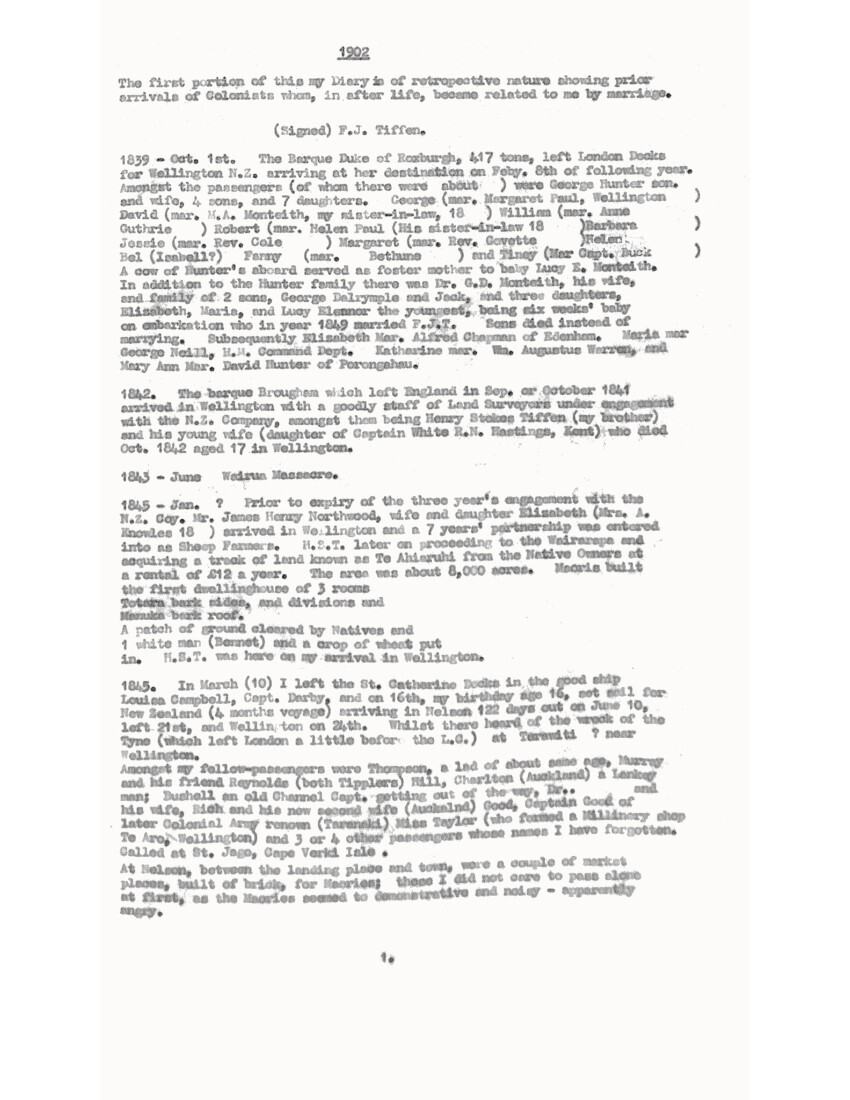
Page 2
1845. Captain Cross was the Pilot and it appeared very close shaving coming into port, the Fifeshire (formerly Whitby) rock standing in the way, Mud flats seemed to thrive and mussels too, the sailors got a good lot.
The L.C. remained 11 days here and arrived in Wellington on 24th June 1845. About 6 weeks later a cargo of Merino Ewes arrived in Wellington from Newcastle N.S.W. to the order of Northwood and Tiffen, which after being landed a few days were on Aug. 19th driven through the main street of Wellington Lambton Quay, en route Wairarapa via coast route – the only one then. The flock numbered between 700 and 800 and 1 pack mare and two small pigs. Engaged in the expedition were the partners N. and T. myself, York, Paddock, Mr. C.J. Pharazyn sen. now 99 years of age, G. Swainson and D. Henderson. At Wainuiomata a half dozen head of cattle of H.S.T. were added to the live stock, having been sent by W Bertram White (H.S.T’s brother-in-law who was settled near).
Memo
The Ahiaruhi (Ahi Fire aruhi fern roots) run contained about 8,000 acres, the hills being covered with stunted fern and the terraces and flats with native grasses and a good sprinkling of Te tree scrub. It was the farthest run up the valley that was taken up, and remained so for a year or two, when “Manaia” run (W.H. Donald or Rhodes and Donald) was settled by Donald, wife and family, and later on Te Oriori run by R. Collins who removed from Bedwells with his sheep.
Northwood and Tiffen after a while purchased a mob of heifers and turned them on to the run but nobody ever mustered them or went among them and they became wild, their presence being known only by their crashing amongst the scrub in the gullies. We never had any more cattle beyond a few milkers.
1845 – Sept. After 17 days journeying we reached Ahiaruhi with 758 Ewes 6 head of cattle and a mare.
The route around the coast from Wellington to Wairarapa Lake afforded obstacles which the earthquakes of 1848 removed through a general upheaval of the land in that neighbourhood. Rocky points which could be got round only at low water and with smooth or moderate sea became passable at all tides even at the Muka Muka rocks where it used to be a ticklish job to negotiate at all times. Maoris ferried the sheep across the lake (it being open at the time) but the sheep were pretty tame from their sea voyage and coast journey and easily caught and tied and placed in canoes. The only incident that occurred in the valley was the bogging on Wharekaka Plain of the mare and smothering the two (pigs) Porkers which formed part of her load. Swainson and myself were in this but H.S.T. was supposed to be directing us to a firmer crossing but did not look back to see if we were following until it was too late.
Memo
To negotiate the Muka Muka Rocks half the sheep were left behind at last Camp, and we were at the obstacles with the other half before daylight piled up stones at one point so that the sheep might scale the point and at another point it had been tunnelled and was known as “Cole Hole” named after Rev. Coles who used to visit the country occasionally. Rider had to go into the sea a bit to get around these points but even then the tide had to be well out. If a swell was on nobody attempted to pass. This is as the Muka Muka was, it became safe travelling after the earthquake even at high tide. It was a great relief getting quit of the coast, but it was not all coast, as a long stretch of hills, known as Rhodes Hills had to be travelled between Okiwi (Brown Acorn House) and Wainui-o-Mata Orongorongo (Riddifords).
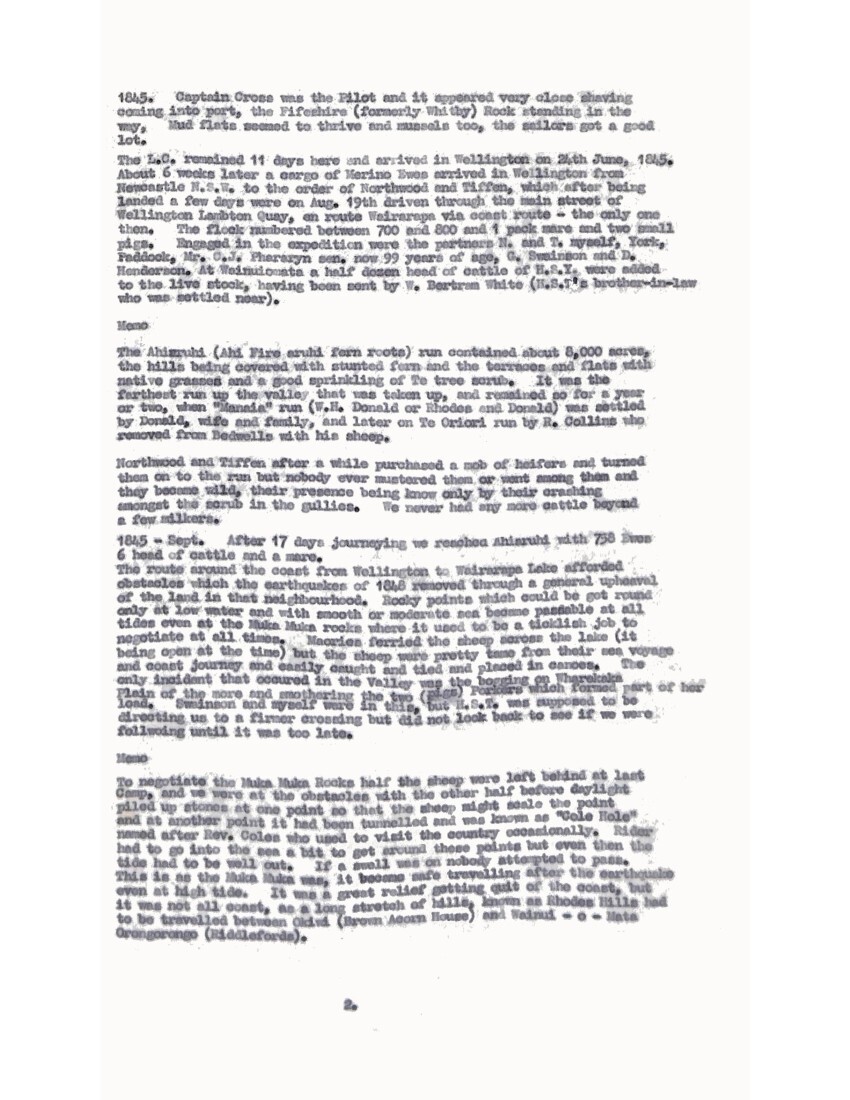
Page 3
We had but one sheep-dog “Bob” imported from Australia with the sheep, fortunately the Merinoes were low or Bob would have been of but little use.
1845.
After leaving the Pa at the Lake called Kai-ko-kiri-kiri in the neighbourhood of which was the first station owned by, or rather rented from, the Maories by Drummond and Wallace – a cattle station, and it was stated that one of the partners not knowing mules did not breed, grazed a number on account of an Australian, on thirds, that is to say, his recompense was to be l/3rd of the progeny – which came not.
A trifle further up the valley the “Sow & Spuds” accommodation house kept by J. Grindall was reached and welcomed too as the first European quarters though primitive.
Tauanui Station came next rented by Charlton Scroggs Tully. Two, if not three, being of the N.Z.Coy. survey staff. To the right of Tauanui, and on the coast was Wangai-Moana Sheep Station, Purvis Russells and one of his brothers with him.
There was no other coast Station near Te Kopi, the landing place, until Mr. C. Pharazyn Sen. (who helped us up with the sheep) took up Waterangi run (just beyond Te Kopi) at this visit to Wairarapa. From Tauanui we passed Tuitarata (McMasters) Otaria (Gillies, wife and family).
1845.
Memo.
Packing Station requisites and household requirements from Te Kopi, their landing place, to Ahiaruhi, about 40 miles, also Wool as return load – occupied much of my time, in conjunction with one David Henderson. The journey occupied 5 days, nearly all on foot, and when the packages were not equally balanced on the pack animal a few stones had to be requisitioned. My chief animal was the bull, but mule horse and donkey were also used. The bull had a ring in his nose but was not comfortable riding perched on a pack saddle and but one rein to guide him. Sometimes our neighbours and us would go for stores Etc. at same time and thus about 6 loads were brought home. Packing wool to Te Kopi, about two tons first shearing, was an awkward job on account of its bulk, and on arrival repacking into larger bags or bales for shipment to Wellington. A pair of harrows once formed a pack made snug with a few score yards of calico. The mule got bogged in a creek and we had to unload the animal before it would rise. There was not a bridge or half a mile of formed road to travel over at this time nor several years later, nor was there an acre of freehold land in the hands of Europeans.
Wharekaka (Clifford & Weld) Kupungarara (since Pahiatua) Bridwell and his friend Collins, the latter afterwards taking up Te Oriori near the top of the valley a few years later on, next to Wharekaka, a large plain extending to the Huangaroa river, on the other side of which was the run known as Huangaroa occupied by Captn. Wm. Smith and wife and family, and Saml. Bevans. On their boundary was the Ahiaruhi Run on the west side of which ran the river Ruamahanga, on the other side of which Morrison and family occupied a cattle run. These runs constituted the Col. 1845, when every acre of land, with small exceptions, from the Hutt near Wellington to Auckland was owned by Natives, and it is surprising on looking back, to the fact that the Maories rigidly respected the primitive leases made between them and their white tenants. Rent was invariably paid in coin, but it immediately came back in payment for clothing, prints, calico, Etc.
1845.
Memo.
The Ewes imported from N.S.W. were timed to lamb in Sep. and this is the way that event conducted. Paddock, the shepherd of English origin, had me as his assistant, and my picture I formed of reclining on a bank and watching the gambols of the lambs was dispelled on the first day, for as soon as the flock was got well together I had to keep going round and backwards and forwards all day to keep them within bounds. Even to late in the evening when we used to leave them camping would we remain there and to home for a bulls eye lantern. Every morning it took two or three
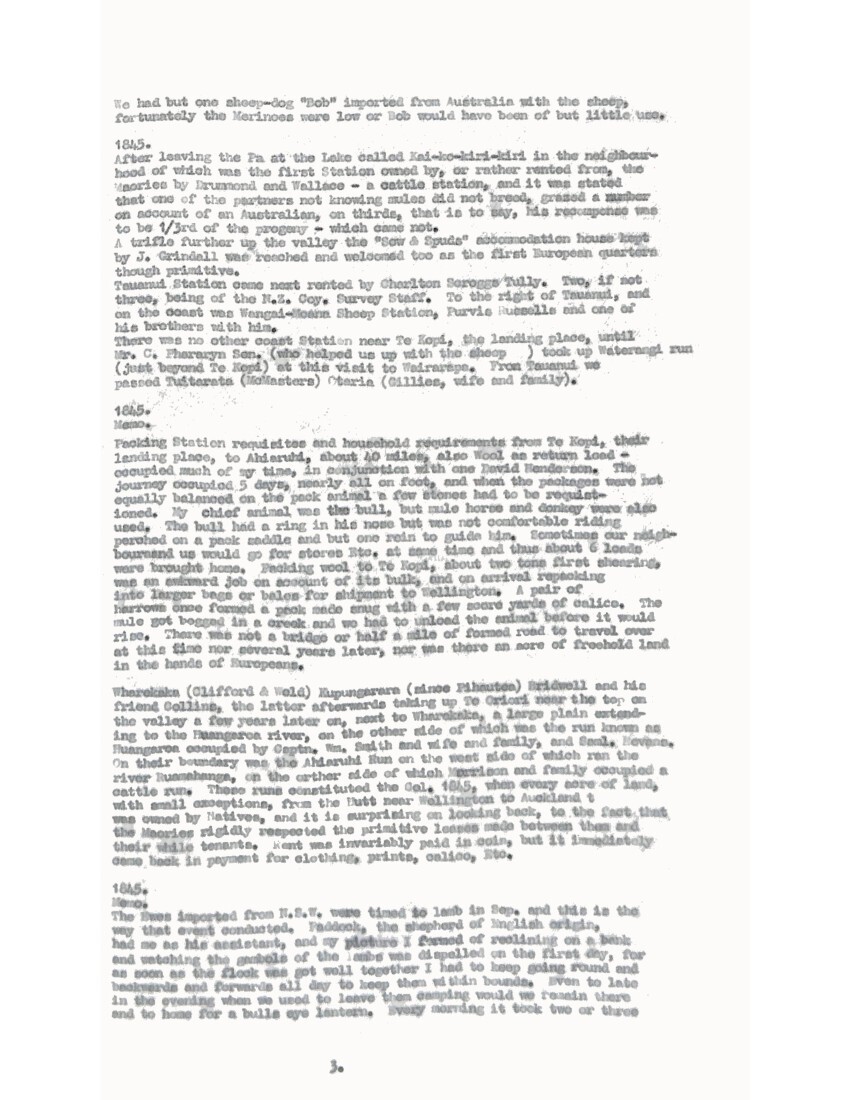
Page 4
hours to collect the ewes again, give some lambs a drink of milk and keep them in close compass as the previous day and to the end of the lambing. When the lambing ground, from ½ to 1 mile off had to be changed an extra hand helped us two to drive Ewes and Lambs right off to that ground, such a job to get the young lambs to move in the right direction, such confusion such folly. No wonder the percentage was low at docking.
Memo continued:-
Shearing followed, the operation being performed by an old Jim Coutes and his co-shearer Charlie Cameron. Each fleece was rolled up and tied with a strip of flax-leaf, locks and pieces loose. The woolpack, known as ¾ bale was suspended to the roof by its 4 corners and into that was packed, by treading in, enough fleeces to make about a hundred pound bale for packing to the coast, about 30 miles, where they were repacked for shipment by boat to Wellington. Scab existed in the flock either the first or the second year. Our neighbouring run (Smith & Bevan’s) had scabby sheep and there being no fencing on the stations beyond a few hundred acres the flocks roamed sometimes beyond their own limits, thus one day I detected a rough wooled intruder amongst those under my care, caught him and drove him in flax harness to the station a distance of about two miles. It was there dressed with something or other, tethered in the garden, but next day it was non ( ), and as the masters didn’t mind they evidently knew more about its disappearance than they cared to tell me, or even Smith & Bevan’s. It was a very scabby animal but none of us knew much about that scourge, except theoretically.
1845. Sept. 6. After 19 days journey from Wellington, arrived at Ahiaruhi with 758 Merino Ewes, 1 mare, and six head of cattle. This ended 3 folios back.
1846. January, 10th. My first visit to Wellington since leaving with the sheep on Aug. 19 of last year. Journeyed on foot taking four days, being on pleasure bent – to see the races, which were then on Te Aro Flat on January of each year – being anniversary of foundation of Wellington in year 18 ? .
Northwood and Tiffen leased another run from the Native owners in this year. Bounded on the South by bush and swamp on East by Rumahangi [Ruamahanga ?] River on North by Waimgau a river and on West to bush at the foot of the mountains. A 10,000 acre property I should say. Leaving Ahiaruhi the Ruamahanga river was forded, thence through a mile or two of bush and over the big hill Paranui- o-Kuaka to a flat called Tananui which extended to the Pa Hurunui-o-rangi and to the Waingana river. At the foot of Paranui-o-Kuaka, on this flat was our Tananui outstation occupied by a shepherd J. Murray and his Maori wife, a hand, and sometimes myself. Here I got my right shoulder dislocated by the Maori woman. I threw a little clay at her while assisting Murray to build a chimney. She took off her waist sash, held the ends in each hand, threw it over me and drew both hands smartly to her thus tripped me up backwards. A small junk of timber lying on the ground struck my forearm and shot it out of the socket. It was quite an accident. Next day went to Ahiaruhi and all the treatment I got was the application of opodeldock solution to reduce the swelling. Nobody knew what was wrong. Twenty days later found me in Wellington (via coast on foot) under treatment of Dr. Dorset reducing the dislocation by a series of long and strong pulls and put me in stays in which I returned to Ahiaruhi.
Memo –
Prior to the third shearing the Whaleboat bring station stores from Wellington and taking back wool made the Lake instead of Te Kopi, dragged the boat across the bar and into the lake, from thence pulled up the Ruamahangi River to Wharekaka Station (Clifford & Weld) so Mr. C. Nairn set to work and made a wool dray, the wheels of which were cut from a large Kahikatea or white pine tree, and with that primitive dray and a good team of bullocks much was done during the summer months. Some of the bullocks had been used packing wool before this dray came into existence, but they gave lots of trouble and did not appreciate a

Page 5
bale on each side of them and perhaps half a bale on top. Old Billy the pack bull was a good beast but the bullocks back’ (buck?) Civilisation tended to kill Billy, chairs were voted better than blocks or stools to sit upon. A case was sent from Wellington but it was so heavy that a corresponding weight had to be made up to balance it, and the animal strained himself and died.
In 1847-8 I was a good deal on outstation work under canvas on Taratai flats and on bank of river Waunganui with flock of sheep. Gordon and myself were camped by the Ahi Kihari bush on margin of the Tarathi flat. The bush was celebrated for rats and took its name from these rodents (Kiari). They used to run up and over our tent, across our legs and up to our ears. They scampered about the dry leaves, devoured bacon or salt meat sunk in the stream overnight and just as I was about dozing off Gordon would give me a nudge and say “Hear that”. We caught by ordinary gin trap over 100 and left their tails pinned to one of the pine trees. Wild dogs or strayed dogs gave a good deal of trouble at night and we used to mount the ridge overlooking the flats and make a great noise and let off a small brass cannon I had until one night it burst. The Taratahi plains and to the river Waunganua[?] was strewn with small plants of amice and so greedy were the sheep for it that it became quite a task to keep the sheep within bounds until all within reach disappeared, and being annual it never afterwards appeared. On these plains grew much Papai or Bayonet grass, being a cluster of 50 to 100 strong and prickly Bayonets covering about a 2 to 4ft square. Patches of a thorny plant named (word missing) also was numerous. Maories descrive [describe] this plant as forming the Crown of Thorns of Scripture.
1848 Jan 20. Self and Chas. Nairn left Te Ahiaruhi at daylight reached Blue Rock camp jan. 21 – Arrived in Wellington via Rimutaka mountains on foot. From Morrisons run the track ran through Morrisons bush which most of the year was little better than a bog of mud and tree roots. Thence across the trackless Tauherenikau plain of more stones than soil to Burlings accommodation house. Thence across the bush hills where the Government were making a road, thence past Hodders Collins, Mangaroa Bucks (Taitai ) Burchums (Hutt) Bush having been either recently or years back all the way from the foot of the hills on Wairarapa side.
Charles Nairn accompanied me from Ahiaruhi (started when frost was on the ground) to Swainsons party near Blue Rock where we stopped the night. Thence climbed the hill and descended to Frank Nairns party at Mangaroa roadmen, thence walked into Wellington. Taking the Railway Time Table as a guide to the distance, say from half way up the Incline it would be about 40 miles.
Walking after sheep month after month seasoned me effectually.
Memo
On one occasion in 97 I was required to go to Waterangi Station (Pharazyns) for a servant girl who had been sent from Wellington for Ahiaruhi. Riding down and walking back. At Tananui I met David Henderson on his way to the station with a hive of bees from the Hutt. He agreed to wait where he was until my return next day. Made an early start with my charge from Pharazyns, so as to suit low tide at the cliffs and in good time Henderson and his bees, and me and the young woman (afterwards Mrs. Murray, our shepherd who preferred white bread to brown) made the best progress we could towards home. We travelled all night and were glad of a breakfast at our destination. This is about a 40 mile walk of mine, and the first of that length made. My second being as described under Jan 21/48.
1848
Oct 16 to 19. Four days of Earthquakes not such as people make a song about now-a-days but real chimney levelling, earth-cracking, terror inspiring articles. A disastrous one at 1:40 am. on 16th smaller and numerous

Page 6
for the next 2 days, and a very big shake at 5 a.m. on the 19th. Brick chimneys in the country were scarce articles and our house could stand a good shaking but in Wellington there was a general pic-nicing and outdoor cooking going on for want of chimneys. Only one baker’s oven was left intact and the owner held the military contract to supply the troops. A brick wall fell and killed Sergt. Lovell and 2 children. Medical Hall kept by Dr. Dorset became a scene to be imagined with bare shelves and contents broken and badly mixed. A number of land slips occurred on the wooded hills between Wellington and Wairarapa and in one instance a house was shaken off the piles supporting it.
Memo
To Mr. J.H. Northwood is attached the credit of securing, by leasing from the Maories, the first run in Hawkes Bay. He was ably assisted by Mr. Charles Nairn, who was a good linguist whilst Mr. N. was a failure in that respect. Pourere [Pourerere] and the inland run Omakari were leased – fully 50,000 acres for less than £100 a year. Nothing but Merinoes would have thriven on Pourere for the hills seemed nothing but fern-clad from summit to base, but at Omakari there were good flats and moderate hills. The sheep improved on their journey and our losses were a mere nothing with all the country to roam over without fear of mixing. Scab there was in a small degree but its worst stage was to be later on. In fact it existed during seven years and was eradicated eventually by Chas. Nairn on behalf of Mr. Northwood and myself on H.S.Ts behalf after dissolution of partnership of N. and T.
On one occasion H.S.T. had paid a visit to Wellington (1846 or 1847) and came back full of the lime cure for scab. I set to work and burned lime stone (packed from the base of Rangitoto hill) and dipped them all – to no effect. Arsenic dip was then tried which knocked up the employees but did not cure the scab. In fact no soda was used in the brewing of the dip.
1849
Jan. 2. Left Ahiaruhi run for the East Coast run Pourere with about 3,000 Merino sheep and a packhorse. There was Mr. Northwood and myself, E. Davis, Dutch Charlie, and another white and six Maories who had come down from the Ahuriri district to help us up. (Arr Pourere 30) We followed down the river Pahau, with its numerous crossings, to the coast to Camerons Run and up the coast camping, (a fortnight after leaving Ahiaruhi), on a flat about 2 miles south of Castle point, and on 30th January – 4 weeks journey – reached Pourere.
Not a run to the south of us nearer than Castle Point (Guthries and family) and none nearer than Auckland district to the north.
Feb 23 Self and Edward Davis (obit at Pukutapu ) removed about 2,000 sheep from Pourere to Omakari leaving about 1,000 under Edward Collins the appointed Manager for N & T. A Maori built house served as a homestead.
July 11th. End of 19 days wet weather.
Memo
Wild dogs gave a lot of annoyance and loss at Omakari 21 visits in 10 months, therefore Davis and I erected a hut each, his of toi and cutting grass at one end of the run and, being nearer bush, I erected mine of totara back [bark]. From these huts we had the sheep handy to us whilst the feed lasted and then we built a third hut using the first residence as a depot for grinding wheat and for sheep-work in the only yards on the run. We were sometimes 8 or 10 days without seeing a living being, when at the huts we had a visit from Maories whilst at the depot.
Wanting stores (reduced to pori pori or Manuka for Tea) also arsenic for sheep dressing, and expecting to find a station hand on board, we put off and boarded the Gipsey. The wind rose to a gale, and the vessel dragged her
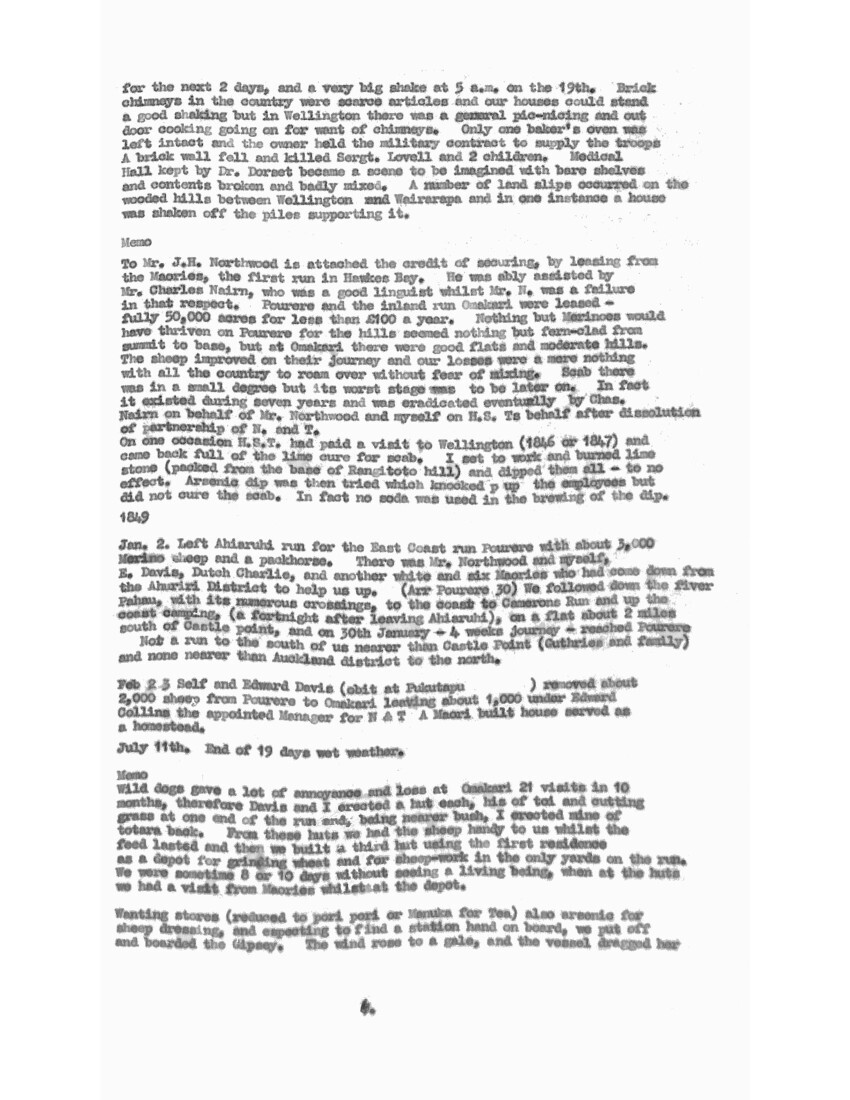
Page 7
anchor and had to make sail, having our boat in tow intending to land at a hill sheltered spot further up the coast but before the haven was reached our boat broke adrift leaving us no alternative but to go on to port Ahuriri which we did. The only house was on the western Spit. A store and trading station, it was where quantities of pigs from all parts were slaughtered or made into Bacon by Messrs. Alexander and Ankertell.
1849 July 20th ?
My first and involuntary visit to Port Ahuriri, in Schooner Gipsey, a Westerly gale having sprung up on boarding the schooner in Station whaleboat only myself E. Collins and dutch Charlie taking the boat out and lost it (see Memo on left)
We three left next morning for Pourere on foot. Called at Waitangi upon Rev. W. Colenso thence across Tuki Tuki river and along the beach to Kidnapper cliffs ascended the track there and across the hills to the Southern part of the cape to Waimarama over more hills to Te Apiti and along coast hills to Pourere. I carried a small bag of arsenic with me as my portion of the requirements about 20lbs I should say, and it gave me a nice sore neck chafering the skin and rubbing in the fine powder which percolated the calico bag.
At Tui-gna-ra (sew the sails) there was a branch trading station of Alexander and and Ankertells, kept by one Jack McAllister who bought and pickled a rare lot of pigs, an [a] vessel coming once a month to take away the meat and bring fresh stores and shop goods.
It would be as well in future to write the journalistic parts and the Memo’s straight on end.
1850. May 20
Left Omakari on foot (carrying 3 days provisions & blankets) for Wellington in company with Police Sergt. Scott who had been despatched from Wellington with a subpoena for me (also Mrs. Guthrie at Castle Point) to appear at Supreme Court to give evidence on a trial of Murder against Wm. Good Jones and McAusland. A large vessel the General Palmer was condemned as unseaworthy, anchored in Wellington having a young man named Jones as Caretaker. He was subsequently found stuffed into a pork cask, and the supposed Murderer was tracked up the east coast from Wellington, Police Constable Oxenham following him up. He arrived at Pourere where I was. He, Oxenham, got Morena and another Maori to accompany him and soon after daylight I noticed a couple of Maories, being on foot early, about half a mile distant. I had some sheep drafting to do that day so we (self, Davis, Porter a deserter from 65th Reg,) and Good were about extra early. On came Morena and the other Maori, Constable Oxenham keeping out of sight. The former gave me a printed placard headed Kohuru (murder) £100 a hutu (£100) reward) Morena said tera taka (the other side) and whilst I was reading the English version he collared Good, and told the other Maori to “Mau tetahi” (take the other) and he collared the deserter, communicated with Oxenham and marched them away to Pourere, so with the loss of two hands I don’t expect any sheep-drafting was done that day.
Good had been engaged by me 2 or 3 days ago and I had swapped away a serge shirt for a little coat I thought I looked well in. He gave the name of F.W. Anderson and really his company was well appreciated by us. He was an adept at Whistling and believed to be a military deserter from Australia. Jones and McAusland had gone on towards Port Ahuriri as I wanted only one hand. They were taken to Wellington likewise by some means I forget, but they were acquitted of the crime. This gave me a 300 mile walk. Sergt. Scott was a good walker and we gave the 2 or 3 Maories who started with us as much as they could do to keep pace with us. They dropped off declaring that we were Manu (birds) and we saw no more of them.
h1850 May 24th
Third day from Pourere brought us to Castle Point and in the evening a
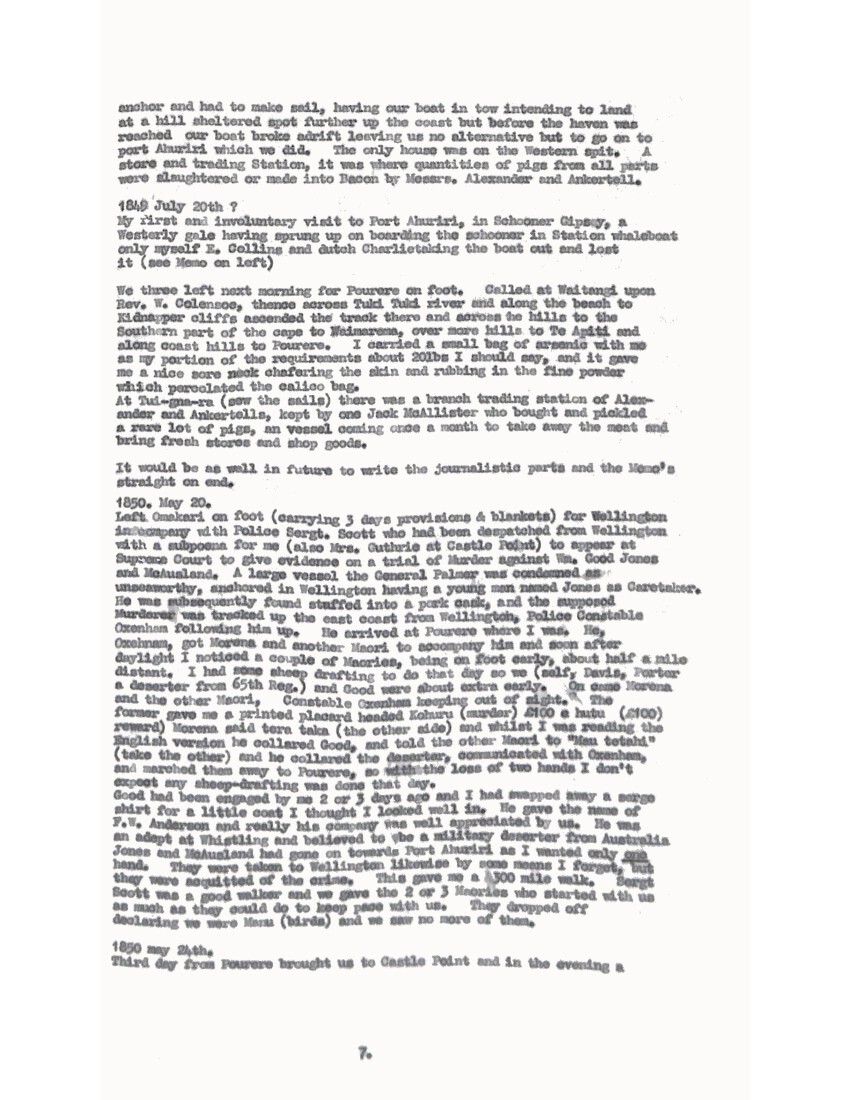
Page 8
schooner arrived there from Wellington for Mrs. Guthrie who had been subpoenaed on same business as myself she having received a pair of shoes or boots from Good whilst mine was the receiving of a coat.
Sergt Scott and Mrs Guthrie took passage by the schooner but I wanted to call at Ahiaruhi to see the partners N & T so I footed it, two days to Ahiaruhi, stayed a few days and got into Wellington on June 1 in time for the trial. My coat nor the boots which Mrs. Guthrie obtained threw no light on the murder case and in settling with me the Govt. refused to pay mileage from Castle Point as I should have taken passage in the schooner they had chartered. In that I dare say they were right but I did not think so at the time. Good was executed in Wellington a few days after the trial.
From the time I passed Castle Point on the way up with the sheep on 17th Jan (49) to my arrival there with Sergt. Scott (May 24/50) I saw neither white woman or child, nor a dozen white men.
1852 Jan 10.
Left N & Ts. service intending to see a little civilised life, having been about 3½ years in Wairarapa and 3 years Omakari.(This too Premature). Hawke’s Bay at this time and years back was great for whales but Poverty Bay was the favourite spot. All deserters from the 65th and other Regts. in Wellington and all minor criminals used to make for the Bay which got the name of Save-all and it was from the deserter element we got our white labour. At one time we had 3, Porter who was taken at same time as Good was taken, rendered the Policeman such good service on my way to Wellington that he received no punishment. Now about the above mentioned 3 deserters Claridge, Moor & Green.
It was shearing time 1850 I had been shearing and went to bed tired and with a bad turn of tooth-ache, was lying half-dressed when I received a shaking, opening my eyes I saw Collins, the boss, sitting up on his bed and standing by mine was Sergt. Sculley went to Omakari and afterwards made a cut across country to the coast striking it 5 or 6 miles north of Pourere thinking he might intercept any escapees. Claridge the third deserter had taken up his quarters in the wool-shed that night, and escaped capture at the outset, or by Sculley’s stratagem. Next morning Collins and myself bribed Morena to let the deserters Moor and Green escape. Corporal Ben, after breakfast, absented himself for a short time giving Morena his pistol. No sooner than the Corporal was clear of the house than off went the captured as free as a bird, whilst Morena followed up behind making a great display with the pistol and his lungs, and it was truly a picture to see the Corporal rushing round the corner of the house in an undressed plight. Morena got a far greater reward for letting them go than had he any chance of getting by retaining his prisoners.
1850
Soon after the bolt I left for Omakari and from the high fern along the track the deserters crept out and we laid our plans in a very few minutes, as we were in fear of meeting Sculley any moment, not knowing he was at that time traversing fern hills miles away.
I reached my hut and slept the sleep of the righteous. In the night – a moonlight one – they came to my hut, opened the door (it was never fastened) and lifted a boot of mine, which was close to the door, which they identified as belonging to me through being trod over on one side, they then woke me up and, as arranged, went into the bush close by, where I arranged to feed them for a few days, expecting the arrival of Mr. Northwood from Ahiaruhi when the few shillings owing to them, after deducting the bribe, could be paid. Getting tired of waiting in the bush they agreed to take stope and tobacco which serve as currency therewith to pay their way to
Saver all.
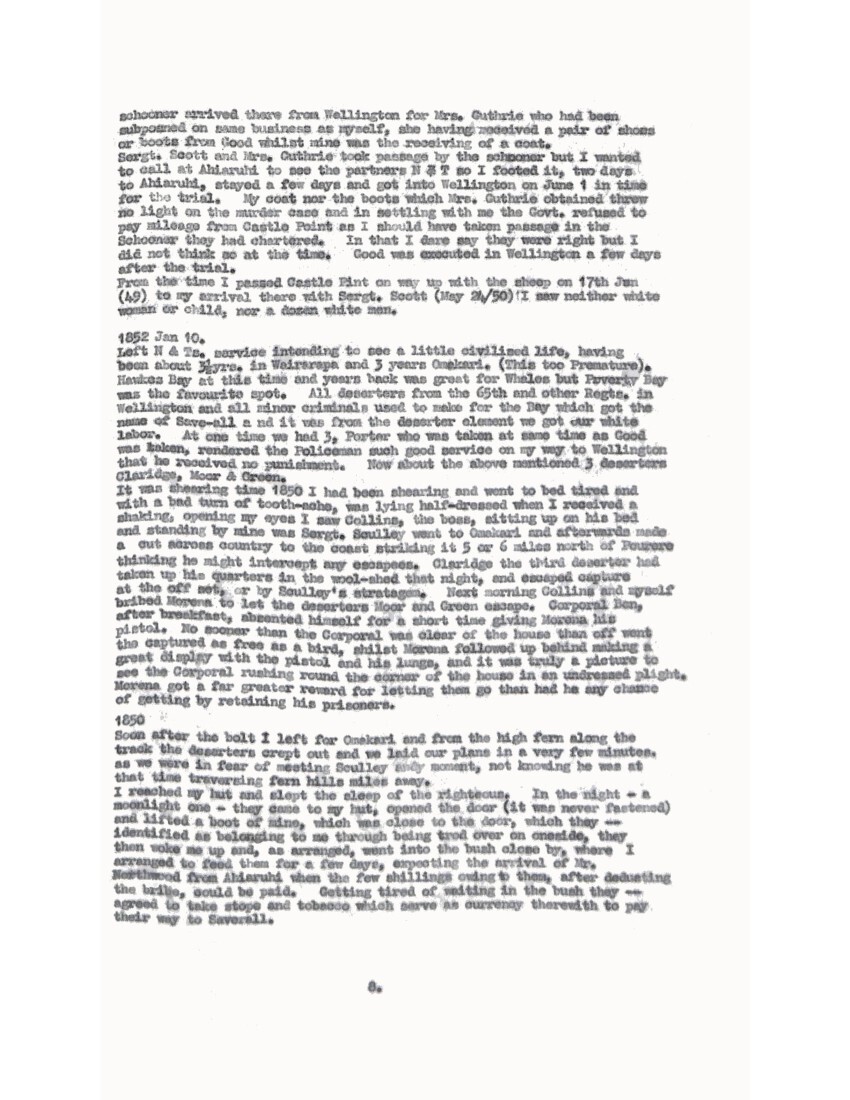
Page 9
1851
During a visit made by H.S.T. to Wellington, Dr. Featherstone, Superintendent of the Province, expressed an inclination to see a bridle track opened through the 40 mile bush to Ahuriri, then part of Wellington Province (which was the general name given to the whole of the country north of the said bush at the time). £100 was the sum arranged upon for an 8 or 10 feet track through the bush.
1852. Jan 10.
Left Northwood & Tiffens service after being with them 3½ years in Wairarapa and 3 years at Omakari. Intended going to Australia to see a little more life than I had hitherto seen in New Zealand. This time I intended going through the 40 mile bush to Wairarapa, having a look en route what sort of a job cutting the track would be.
The first day’s walk was to Waipukurau Pa where I picked up a Maori guide for part of the way, next day made Takapau, on 13th entered the bush nearer the hills than the present railway line, and camped under a big tree rain having made its presence unpleasantly felt. On 14th a short journey brought us to the Hautotara Pa where we were glad to halt and get dry. Jan 15, left Hautotara Pa with fresh guide, passed Pututahi Pa and slept at Ngawapuru Pa and next day arrived at Ahiaruhi. This days journey being an open country one.
I estimated the extent of bush, by the track I journeyed, to be fully 70 miles. A Report on this route was subsequently asked of me, and here it is. addressed to Mr. Ludham who was then Member of Provincial Council for the Ahuriri portion of the Wellington Province.
Before giving it however I will remark in addition to its being a heavy task to widen the track as for £100, I found the natives strongly opposed to its being done, they believed it was all the same as taking possession. I believe one European only had traversed this route before me, and one other European had journeyed part of it and struck off to the right via Manawatu Gorge to the west coast. Further than this the route was untrodden except by Maories.
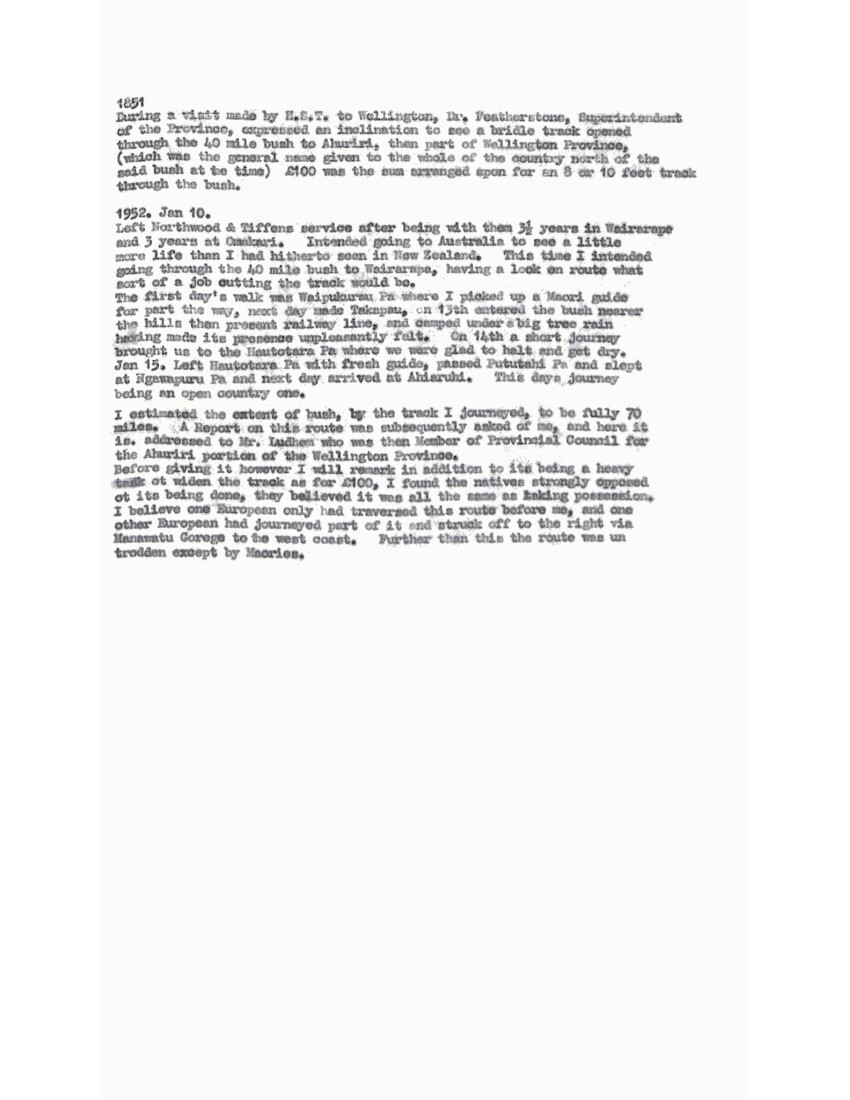
1853
Copy of Report on route Ruataniwha to Wairarapa (then known as 40-mile bush.) September 1853
Alfred Ludham Esq., M.P.C. Hutt.
Sir,
In conformity with your request I have the pleasure of forwarding a description of my route from Ahuriri to Wairarapa.
On leaving the Waipukurau Pa the native path leads for about 22 miles through open grass land nearly level and of very fine soil. The footpath diverges slightly from a direct line to avoid some limestone ranges, at the termination of this tract of open land the path enters the forest: at a distance of about 1½ miles it emerges on to a plain of about 500 acres, when it re-enters the bush and in about 7 miles opens on to a small plain of about ½ a mile in diam. which, being crossed, the path leads through about 2 miles of forest and again comes into a grass plain which it keeps for about a mile. After proceeding about 5 miles through a bush called “Te Ohu” it leads to Hautotara a small Pa on the edge of a grass plain (on the banks of the river Manawatu) containing about 150 acres, which passed it goes through a bush of about half a mile, after which it proceeds 7 miles through an open plain (with a small river running through it to Puhitahi Pa) from which point the track from Ahiaruhi to Manawatu diverges. The path then enters the bush again and after a distance is passed of about a mile it leads into an open space of about 500 acres and re-enters the bush and crosses the river Manawatu 9 times. This however might be avoided by a side cutting of about 1½ miles and I should judge from the absence of cliffs in that distance not expensive work would be necessary to accomplish it. At the end of about 5 miles the path comes to Ngawapuru Pa on the Manawatu river. After leaving the Pa 13 miles brought me to a small opening of about ¼ mile long and rather wider, at the end of which is Te Awera Pa. Very soon after leaving this Pa the native track ascends a hill called Ko Tuku-tuku of about moderate elevation and of easy ascent. From Te Awera Pa to the Wairarapa plains I calculated to be about 18 miles of bush towards the end of which the character of the country is undulating.
In conclusion I should mention that with the exception of one swamp, about 100 yards across, the whole distance is sound land, that the bush is of open nature and the different rivers, with the exception of the Manawatu, might easily be bridged.
I am, Sirs,
Yours very truly,
Frederick John Tiffen.
Miles Miles
Waipukurau to 1st Bush 22 Plain ¼
1st Bush ½ 8th bush 18
Plain 1
2nd Bush 7
Plain ½
3rd bush 2
Plain 1 Total Bush 52
4th bush Te Ohu Plain 33¼
Hautotara 5
Plain ½
5th Bush ½
Plain 7
Puhitahi
6th Bush 1
Plain 1
7th bush and 9
crossings Manawatu 5
Ngawapuru Pa
7th Bush Cont. 13
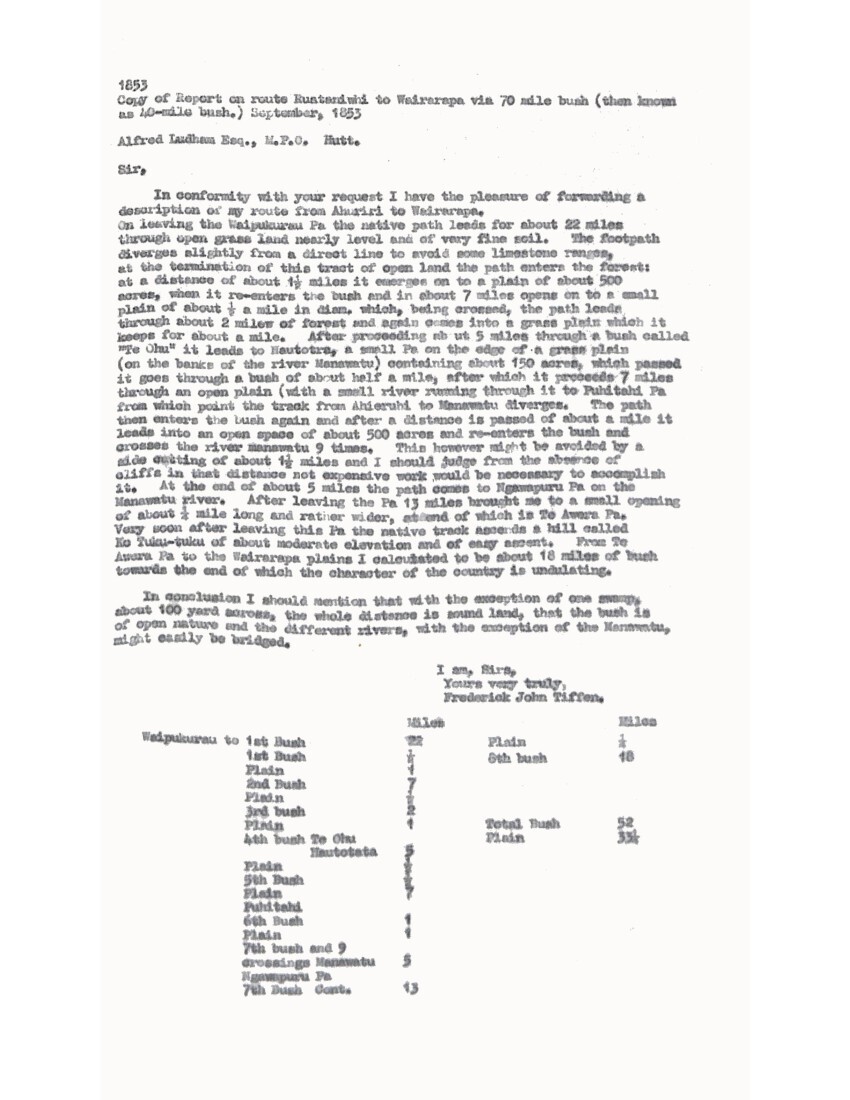
Page 10
1952 [1852] Jan 20. to Feb 11.
I was in Wellington waiting for a vessel to take me to Sydney. On that day I sailed in the brigantine William Alfred, Captain Tinley, with a number of passengers, most of whom had caught the gold Fever. The passage took 14 days, when I first saw what I considered a great city so far away from home, here I remained idle until April 18 when I joined on approbation as trooper of the mounted Patrol, took up my quarters in Carters Barracks (near the present Railway Station) and underwent sword and mounted drill until end of April.
May 1. – was sworn in by Captain Mayne and Sergt Darby at Sydney, referred to Captain Batty at Parramatta for locality, and proceeded in mail coach (used also as conveyance of gold and gold escort between Sydney and Bathurst and Turon) to Penrith,
May 2 – Walked from Penrith to Weatherboard P.S. (near Wentworth falls) where I was to receive accoutrements -carbine, sword and brace of pistols and horse. Remained all next day cleaning saddle end accoutrements.
May 4 – Left weather board Patrol Station well mounted and armed and, no doubt, felt very important. Reached Hartley P.S. Passing Blackheath Patrol Station en route.
1852 May 5 – Hartley P.S. to Diamond Swamp P.S. and next day arrived at Bathurst Patrol Station, my destination, and reported myself to Sergt. McGarth [McGrath?], the officer in charge.
On 24th May (Queen’s Birthday) it came to my turn to form one of the escort to proceed to Turon for Gold and return next day to Bathurst with the precious metal for Sydney. On arrival of the mail coach at the Turon the escort received the gold from the Commissioner and took it to the Gold Police Barracks for the night and guarded it. I had from 8 o’clock to midnight on this occasion on guard duty. There was a good fire and the troopers snored whilst I had to keep awake, a loaded pistol on the table and two iron boxes about 18 inches long by 9 x 9 in. for a seat. Besides these 2 boxes there was a small bag of gold about the size of my fist. When in my jacket pocket it became unpleasantly heavy and whilst on the table I was afraid it might be collared, for I felt very sleepy after a long day’s ride, military fashion, and a log fire by which I sat. However my relief came at midnight and I was mighty glad. Lots of gun firings shouting and other noises were in evidence until a late hour as the miners were keeping up the anniversary of the Queen’s birthday. The Gold Police were mounted men having similar arms and uniform, hip jacket of pilot cloth and trousers of same, strapped with bazil but the cap of the G.P. had a gold band round it whereas our head covering was a black cabbage tree. A pair of cloth trousers strapped with same material was worn by us troopers on Sundays and on State occasions.
May 25 – The mail coach with its 5 men of the escort and 2 outriders made escort on the Sydney road until relieved by two of the mounted patrol further on and so on to Sydney.
When we were not required on this weekly escort duty we, in couples controlled the highways leading to and out of Bathurst – but I saw no results from these patrols, nor heard of anything of note transpiring before my advent.
1852 June 7 –
My second visit to the Turon Gold Fields. Between these two visits it happened to be my duty to keep awake four hours after midnight so as to arouse a trooper whose duty it was to form 1 of the 2 outriders to the car conveying the gold to Sydney. At the appointed time I left the barrack room and crossed the road to the quarters where the man and his wife resided. Rapped him up and received an “All right” and turned in. Very early a corporal came to my bed ascertained if I had undressed and turned in, or whether I had dropped off. The former was the case and I learned no out rider had accompanied the gold as was the rule, at daybreak. An enquiry was made, and as a fellow trooper heard me passing his cottage, whistling a certain air, I kept my billet and ‘t’ other fellow got a reprimand.

Page 11
I was about the only grog abstainer amongst the 10 or 12 men, and pay day meant some sort of trouble or other and an occasional discharge. They were a decent lot of young fellows who liked light work or none at all. The flies were a great pest – houses swarmed with them and the shady side of our clothing and horses carried them by thousands, small ants insinuated themselves into sweets in numbers also.
1852 June 16 –
Applied for and obtained my discharge from the Mounted Patrol. Either the occupation or the climate not agreeing with me. There were any number of foggy mornings in the six weeks I had been in Bathurst and I used to get many attacks of cramp. Dr. Bushby furnished the necessary certificate, and I was given a pass by Capt Batty which enabled me to get quarters at the various M.P. Stations en route to Sydney.
On June 19 I left Bathurst on foot and at night got quarters at Diamond Swamp Patrol Station, next day reached Bowens Falls (Now Wentworth Falls) on the Blue Mountains.
June 21 – from Bowens Falls to Hartley, thence to Blackheath next day (now ). Here I remained 2 days on account of rain and snowfall.
June 25 – Blackheath to Penrith to Sydney intending to return to N.Z. as soon as I could.
1852 July 8 –
Left Sydney for Wellington via Newcastle on the Ship Duke of Roxburgh Capt. Collard. arriving at Newcastle N.S.W. on following day for cargo of live stock.
This vessel was the fine immigrant vessel that arrived in Wellington in 1849 in which the Hunter and Monteith families arrived. She was now reduced to a stock-carrying ship, and I applied for and obtained permission from Mr. Sidey, the Charterer, to partially or wholly work my passage. In event of the trip being a successful one I was not to be called upon to pay anything, but, as the sequel will show, it proved the wrong way for me, and I paid a trifle of my trifling balance in hand.
It took a fortnight (including filling) to load up with 1,200 sheep, 50 horses and 40 cattle.
July 23 – The Duke of Roxburgh sailed from Newcastle. Had a lot of bad weather, was a bad sailor and the sheep suffered much especially those on deck which got many a soaking. I assisted to feed and water them and to keep the pens free of dead. It took up lots of time and it was occasionally very dirty work. The skipper had lots of oranges on board and my best work was picking them over for him. So bad was the passage that we could not face Cook Strait so as to reach Wellington, therefore a fair wind was made of it by shaping south about and so make Port Cooper the first Port. The flock had by this time dwindled to less than half their number and the cattle and horses the same. They were landed here but whether they were intended for Wellington I know not. Captain Collard remarked on his entrance to Port Cooper, that it must be a very good place; there was Capt Parsons the Pilot, Godley the founder and Christchurch a town.
Sep. 4 – Sailed from Port Cooper and on Sep 8 arrived at Wellington having been on board the Duke of Roxburgh 32 days. This vessel appears to have been six months on her way from England to N.Z. in 1838-9 therefore this voyage from Newcastle to N.Z. may prove against her character in that respect. After being 4 days in Wellington Sep 12 found me footing it to the Ahuriri District again, my stages being first day Taitai about [ ] miles,
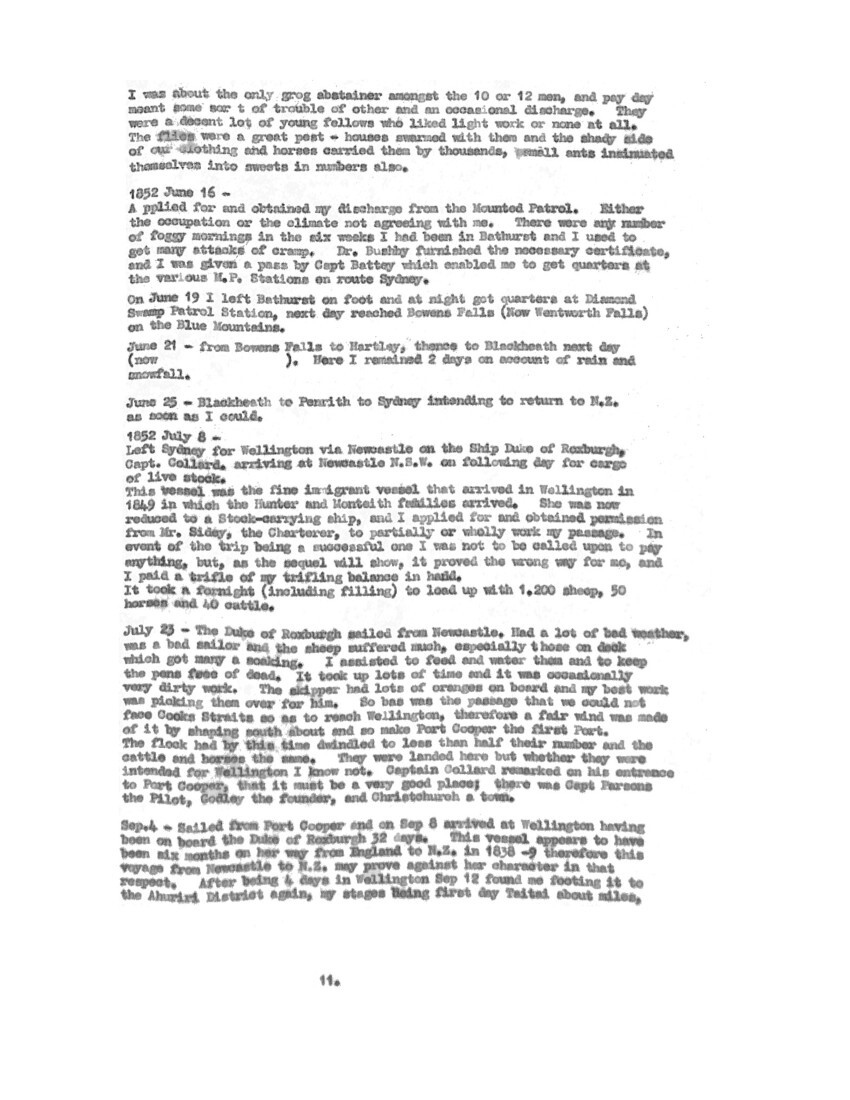
Page 12
second day over the Rimutaka hills to Burlings at the foot, and third day across the Tauherinikau [Tauherenikau ?] Plain, Morrisons and Ahiaruhi (Mr. Northwood’s late Northwood and Tiffen) Miles
1852 Sept 15 to 20th – remained at Ahiaruhi.
Sep 21. – Rode my mare, Black Bess, from Ahiaruhi to Manaia (W.H. Donald) left mare here. Why or therefore I cannot say; next day on foot, and camped out near the coast.
Sep 23 – arrived Castle Point – Always an hospitable place to reach, stayed 3 days, On 27 made Akitio 28 Porongahau [Porangahau ?] Pa and on 29th Waipukurau and Waitukai, the first residence on Homewood run of H.S.T. During my absence the 7 years partnership had come to an end; Mr Northwood taking Ahiaruhi run in Wairarapa as [and?] also Pourere and Omakara Runs in the Ahuriri (or Hawkes Bay District) and his late partner H.S.T. taking Homewood run of about acres. Waitukai on the banks of the Tuki tuki river was selected as a convenient spot for a woolshed and residence, as station stores and requisites had to be brought up that river from Napier, then known as Ahuriri, by canoes and the wool taken down by same means. Four bales of wool were generally taken by each canoe and it required steady balancing of the canoes to avoid getting the wool wet. On one occasion I had to go to Port Ahuriri to dry and re-pack wool which had so become wet.
1852.
Shearing was got through, self and others shearing at Waitukai H.S.T. self and Henderson and wife and 2 shearers occupying the residence whilst 2 shepherds occupied a clay-and-batten cottage about 4 miles to westward (afterwards known as “Homewood” Proper).
I was at Waitukai about 3 months Oct-Dec shearing, lime-burning and dipping in the new lime-dip H.S.T. had throught [thought] proper to adopt – Result a failure Sheep-dipping in arsenic was also tried later on at Homewood. The brewing was strong enough and the fumes arising therefrom was effectual only in knocking the operators up. Each sheep was caught and a man on each side, holding 2 legs each, immersed it in the dip-tub and tossed it up on to the draining stage. The men’s hands were constantly wet and parts of their body also and before the work was through they found it a difficult task even to button their coats or lace their boots.
1852 Jan 5 –
H.S.T. and self rode to Ahuriri (Nap) from Waitukai by middle road and next day returned thereto.
Jan 7 – I made a start for Wellington on foot, reached E. Paraima Pa.
Jan 8 – From E. Paraima Pa to Porangahau Pa and over hills to Tautani (Wallaces) near the beach (now further up the valley)/
Jan 9 – A very long walk, reached Castle Point (Guthries).
Jan 10 – Camped out in the fern at a spot near Kaumingi (?) Pa and on next day made Manaia Station (Donald W.H.) rather a short day’s Journey.
Jan 12 – Got my mare, Black Bess (which I left here on Sep 26 Last) and rode to Taitai (G. Bucks “Travellers rest”)
Jan 13- Coach to Wellington where I remained a couple days.
Jan 16 – Left Wellington en route Waitukai where I arrived on 31st.
Feb 20 – Left Waitukai en route Port Ahuriri.
Feb 22 – Visited Tangoio, Maori Guide, intend looking for a run, struck river petons (?) named Wai Inanga (lot (?) Water Whitebait) and followed down the valley to the Pa arriving home a few days later.
Feb 27 – Left H.S.Ts service in which I had been five months (since 30 Sep Last).
March 3 – Left Waitukai on foot intending to go to Wellington way, met J.D. Canning at Eparima and next day returned with him to Canning and Hardings Station between Waipukurau and Waipawa (now Mount Vernon) R. Pharazyn, T. Tanner & G. Wargan got river-bound with their sheep from Waterangi Station.

Page 13
Wairarapa to Te Aute whilst I was at Mount Vernon and we took turns to do the cooking for about a week. Grinding wheat into flour being a big job for 7 or 8 mouths.
March 24 – Accepted employment from F.S. Abbott, Waipawa, where I remained nearly 4 months ending 18 July part of the time spent in a tent at back of the run where I was engaged building an outstation whare.
July 18 – Finds me back to Waitukai “boss” of the work, about a month which place he returned on Aug 26th.
Aug. 31 – From Waitukai (now Witherows) for Ahuriri for spirits of tar and damaged tobacco for scab curing. Returned 2nd appx.
Sep 3 – On the road again for pack of Station necessaries.
1855 [1853?] Sep 13 –
Commenced upon a big undertaking, that of curing the flocks of scab from which disease they had not been free during the full 7 years partnership of Northwood and Tiffen. There were over 2,000 sheep shorn at this time
Sept 19 – From Waitukai to Ahuriri to examine some bales of wool more or less damaged in transit to port by canoes, retd. 22nd.
Nov 1 – Finished scab dressing which was commenced on 13 ult. Total 2,122 sheep.
Nov 9 – H.S.T. from Waitukai for Wellington.
Nov 19 – To Ahuriri to examine water damaged wool per canoe, retd 22nd.
Dec 2 – I examined — Market Wethers, trimmed old scab marks,
Dec 31 – H.S.T. having learned whilst in Wellington that a lime dip was effectual in curing scab set to work breaking lime stone (packed from about a mile off) and burning same in an imprompt [impromptu] kiln at Waitukai, and on Dec 31 lime-dipped part of flock. (Not a success, was whitewashing.)
1854 April 10 –
Dennis Hearn and another with 400 fat wethers for Papawai (Borlases) Wairarapa.
April 29 – Self Clarke and Seale (of Australia) left Waitukai for Wellington arriving at Castle Point May 2nd.
May 5 – Overtook the 400 wethers at Tawaiti (Riddifords) G.D. Monteith there. Camped with drovers inland by bush.
May 6 – To Hautotara (Kellys) an outstation.
May 7 – Ahiaruhi (Northwood and Tiffen).
May 8 – To Papawai and Built sheep pen for dipping sheep and as further precaution.
May 10 – Drovers at a bad stream crossing in bush adjoining Papawai lost a number of the 400 wethers – recovered same next day.
May 18th – Left Papawai for Wellington for Tobacco – river Waiohini Dennis Hearn slipped off his horse, and, assisted ashore by and of myself and horse.
May 29th – Retd from Wellington with damaged tobacco. Found several wethers had been killed by dogs.
June 7, 8, 9 – Sheep dipping at Papawai (Borlesses)
June 10 – Walked from Papawai to Manai [Manaia?] (Donalds) next day to Te Ori Ori about 6 miles (Collings) and on.
12th to Kaumingi with Holland.
Aug. 17 – Joyce and self commenced sawing timber – self top sawyer) for woolshed near Patangata Pa.
Oct 28 – Joyce finished building woolshed.
1855 Jan 23 –
Severe earthquake 9 p.m. worse than that of 1849
Feb 22 – Self and hands ( ) left Waituki for Papawai Wairarapa (C.B. Borlesses) with 46O wethers for market. Arrived at Castle Point 7th Prox. Drove inland through a newly cut road (by R. Collins, Te Ori Ori) through 2nd and 3rd bush on 14th March passing R. Collins flock on route Porongahau and in one of the openings Paitu Mokai.
March 16 – arr at Papawai started for Wellington on foot arr H Burlings (Featherston) and on to Hutt next day.
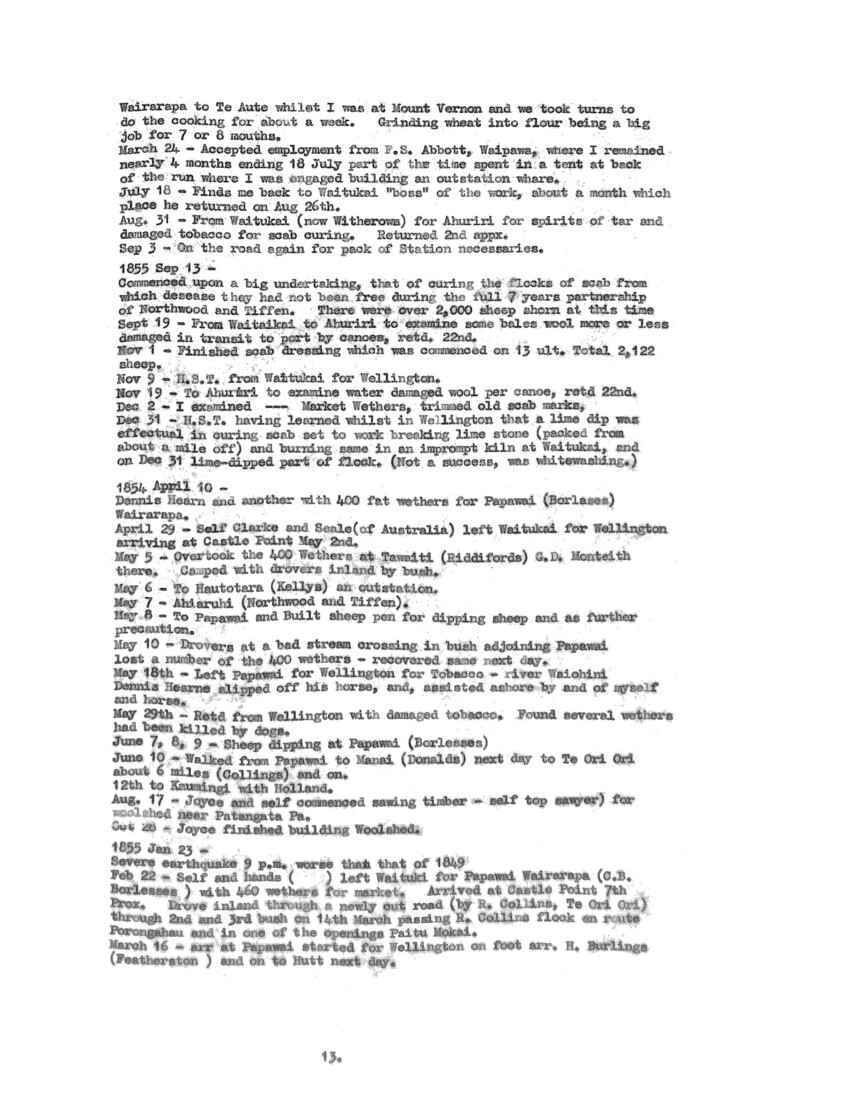
Page 14
March 19 – my tenth visit to Wellington.
April 7 – Hutt to Wellington and to Taitai with “Skylark” mare.
April 11 – Benighted on hills overlooking entrance Warehama river, having gone astray at the trooper in dense sleet and storm. Camped in flax bush “Skylark” tethered.
April 12 – Reached Castle Point and on 17th Homewood.
May 11 – Went to Napier to see Commissioner. Domett re P. Russells trespass cutting timber on Waipawa bush – part of Homewood owned by Hon. A.G. Tollemache H.S.T being then in England.
April 18 – Stopped P. Russells sawing by levering a log off the skids into the sawpit.
August 7 – Left Homewood for Napier to catch “Shepherdess” schooner for Wellington.
August. 22 – Left Port Ahuriri for Wellington per Schooner “Shepherdess” Capt. Douglas – 7 days voyage.
September 12 – Left Wellington “Shepherdess” 4 days voyage.
October 4 – In difficulty getting rams across Tuki tuki (near Te Mata) from J. Rhodes Clive grange. Herrick and McKenzies river punt on way up river came to rescue and punted them across.
October 18 – Lucena with rope for lever wool press then being erected at Woolshed Patangata.
(Mrs and Mr. H.S.T. from N. passed to Homewood during operation)
1855 Nov. 15 –
Maories by canoe took 4 b/wool 1108 lbs to Waipureko (Clive) cost thereof £3. 10. 0, other 51 B/W followed later on by Herrick and McKenzies punt. headquarters Patangata.
Nov 16 – 17 – Rode Napier and back about wethers sold on 3 October.
Dec 14 – Rode Homewood to Waipureko (Clive) with George Buck of Taitai Horse “Boots” threw me (about a mile on return journey home) broke left forearm, walked back to Waipureko (Clive) just in time for someone to trail
Buck who had just crossed the river, to report my accident to Dr. Hitchings in Napier, who came out.
Dec 15 – Conveyed, by flat bottom punt belonging to Hollins (who with wife and family had a small refreshment (and sly grog) shop near Awatoto) by Mr. Hitchings and Mr. Booking by inland channel to Munns Royal Hotel. (This channel, which was used by punts from Waipukero [Waipureko] – Napier there being no ferry service then, nor did drays go to Napier).
Dec 28 – Commenced return journey to Homewood on foot arriving there on 30th
(Whilst Wool cargo rolled a good deal going down river the return journey of canoes required to the [be ?] poled up nearly the whole way).
1856 Jan 28 –
Left Homewood for Wellington on foot arriving at Hutton 4th Prox. In Wellington 19 days.
Feb 23 – From Hutt for Ahuriri all afoot.
Feb 27 – Kaumingi to Flat point.
Mar. 1 – Castle Point and on 4th Homewood.
Apr. 29 – J.D. Canning and P. James Lawrence arr Home wood 4 negretti rams (1 a wr) coming on by dray from N. Having arrived per “Westminster” from England Capt Westgarth, accompanied by H.S.T. and wife and L. Ansell T. with Mary E.T.
Apr. 30 – Left Homewood on foot, for Wellington to see Mary E. Westgarth nee M.E.T.
May 3 – Warehama to Flat Point 4th Pahau (Camerons) 5 Waterangi (Pharazyns)
May 6 – Whaterangi to Orongo Orongo (Riddifords) other station – thousands of rats in house.
May 7 – Orongo Orongo to Taitai (Bucks Travellers rest) found Westgarths on their honeymoon.
May 8 – To Wellington. 14th visit. There found H.S.T. and wife and L.Ansell T.
May 16 – To Hutt en route Ahuriri
May 18 – Hutt to Orongo Orongo on foot, next day.
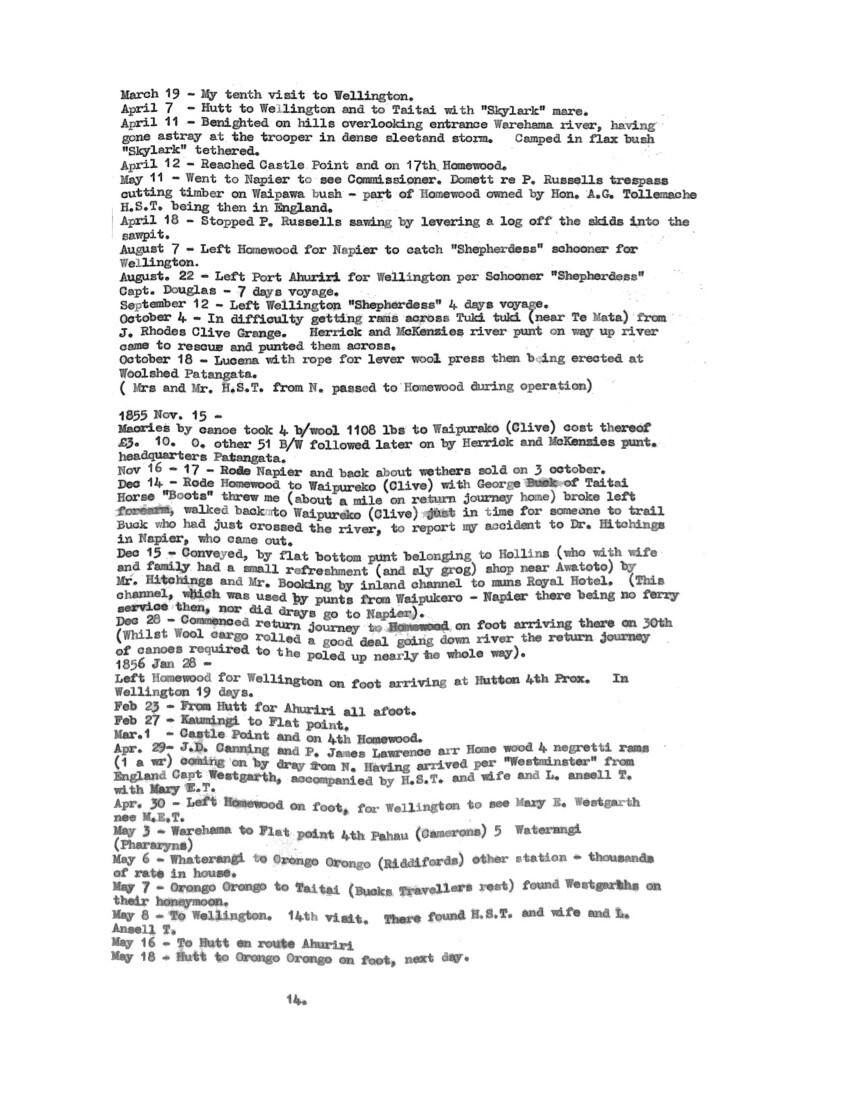
Page 15
May 19 – To Whaterangi (Pharazyns).
May 20 – Passed White Rock Station (Bartons) to Te Awaiti (Riddifords).
May 21 – arr Flat Point (March and Hales)
May 30 – Warehoma Station (Moors) arr Castle Point 31.
June 1 – Akitio Station Next day Porongahau Pa.
June 3 – Porongahau Pa to Homewood afoot.
June 25 – L. Ansell T arr Homewood from Wellington fr. England. Brought Remboulet Rams with him. One a wether discovered by J.D. Canning at
Waipureko ferry.
1858 Aug 1 – [note “8” deleted in original , replaced by “6”, therefore 1856]
Appointed Inspector of Sheep by Prov. Govt. Boundary of District Te Matina (Mahia?) Northward and Wainui (between Porongahau and Castle Point) Southward. Salary £100. (see my first official report of Number of Stations sheep.
Aug 5 – To Napier 6th retd Homewood
Aug 11 – ditto 14th retd.
Dec 6 – Left Homewood for Wellington afoot, arr Porongahau.
Dec 7 – Porongahau, to Oahanga river (slept out)
8 – Castle Point 7 – Flat point
10 – Te Awaiti (Riddifords) 11th – Matthews past Wairarapa Lake.
12 – Hutt 13 – Wellington
17 – Taitai on return, afoot, to Ahuriri. Arr Burlings (Now Featherston)
18 – Te Ori Ori (R. Collins) next day Castle Point.
20 – Inspected D and W Hunter’s sheep about to proceed to Porongahau afoot.
21 – Castle Point to Akitio 22 – To Porongahau,
23 – Porongahau to Homewood.
1857 Jan 8 –
Resigned management of Homewood – James Lawrence succeeding,
Jan 9 – Left Homewood for Taupo (Horseback) run-hunting. Chiefly at instance R. Stokes – reached Te Aute Station (R. Pharazyns) thence to Puketapu (on Tutaikuri [Tutaekuri] river) obtained Maori guide returning to his home Waikoeto afoot.
Jan 10 – Camped out at a spot near Greys Station.
11 – ditto Onekoneho Stream
1857 Jan 12 –
First glimpse Tongariro smoking. Maori guide afoot and me horseback arr on Taupo plain, camped out Fog gave trouble to find horse.
Jan 13 – Wakatahi mui [Waitahanui ??] Pa on margin of lake.
14 – Source of Waikato river junction with lake. Met Simpson and Kendal there.
Jan 15 – Hiruharama (Jerusalem) Pa on lake near junction of Waikato river with Taupo lake.
Jan 16 – Kopia hot spring.
Jan 17 – 18 – At Rev Spencer, Te Mu, Wairoa.
Jan 19 – Visited White Terrace, Rotomahana and slept on road near the coast
Jan 20 – Pukemairi Pa. 21 – Whakatani Pa (coast)
22 – Pa on Rangitaiki river. Not a guide to-day.
23 – Warohau Pa. 24 25 – Tawawa Pa 26 – Hermona? Pa,
27 – Hopomutu Pa. 28 – Tarawera encampment (native)
29 – Te Haroro Pa (Bush) 30 – Titi-o-kura Sheep Station,
31 – M. Arthurs accom. house Petane.
1857 Feb 1 –
arr Napier from journey Taupo Whakatane.
R.M. Court N. Ins. of sheep v D and W Hunter for driving sheep from Castle Point within month of dipping.
Feb 5 – Homewood.
20 – Inspected D and W Hunters sheep at Porongahau.
March 23 – Inspected Roys sheep near Takapau (en route Ruataniwha) Insp Ormonds and R. Collings sheep from Wairarapa.
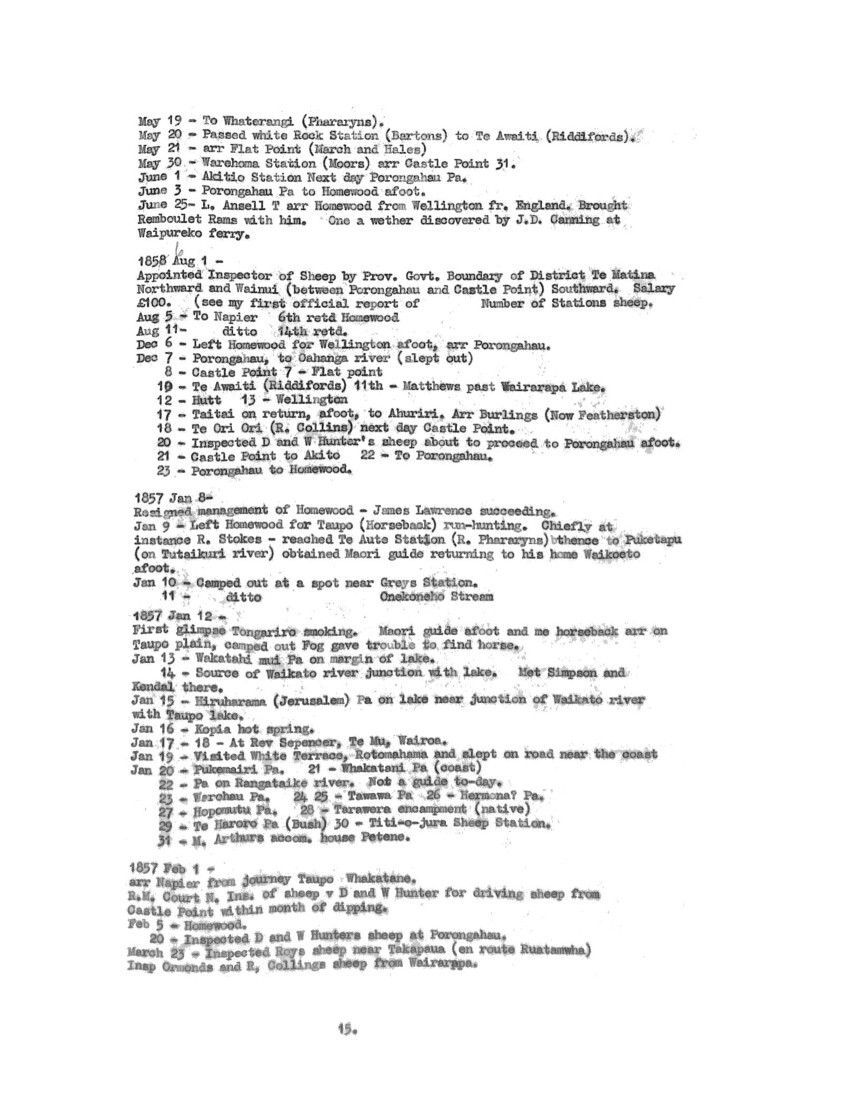
Page 16
Mar 16 – Insp Masons sheep near Porongahau
Apr 1 – Napier R.M. Court Insp of sheep v J. Roy D and W Hunter. Manson
27 – Started with sheep from Homewood for Tukes Aorangi by Te Aute Road – 4 days journey.
May 4 – From Tukes Te Mata residence to Napier.
8 – To Tukes Aorangi run to assist building his house. Remained about 3 weeks and about all July.
Jun 24 – From Aorangi to Poporanga run hunting, camped on river bed.
25 – Examined country foot of Ruahine and returned to Aorangi.
Aug 30 – Left Homewood for Wellington on foot.
Sep 1 – Received appointment Registrar of Brands for Ahuriri
Sep 3 – Castle Point 7th – Wellington
Oct 3 – Left Wellington horseback for Ahuriri. Frank Knowles accompanying and Castle Point 9th – Homewood 11th – Napier.
Nov 1 – Homewood to Napier.
Dec 25 – Mangakuri (Hargreaves)
1858 Feb 2 –
Homewood to Napier.
Feb 20 – Insp Munto and Blairs sheep en route Mangahoni.
Mar 1 – With R. Stokes over Tanners Run Ruataniwha returned Napier next day.
Mar 5 – Insp G.D. and J. Monteiths sheep (from Akitio) at Kaurakau en route. Elsthorpe.
Mar 13 – Ins. R. Prices sheep from Porongahau en route Tuki tuki Station
24 – Napier.
25 – Com. Duties Mgr. Gwavas Station (Carlyon) and Milbourne (Stokeslers)
Mar 27 – Ins sheep at Mount Vernon lately arr from Castle Point.
29 – Visited Elsthorpe Monteith
Apr 12 – Ins at Te Aute a mixed flock of contribution to Te Aute School, settlers having donated a few at every station
Apr 26 – Napier
May 2 – To Gwavas to take over stock and property from Charles and Edward Pharazyn for Captain Carlyon.
Jun 5 – To G. Coopers on Harding Mount Vernon run. Inspecting sheep lately arrived from Te Awaiti (Riddifords)
Jun 11 – Napier awaiting arrival S.S. Wonga Wonga from W. Left on 18th for Wellington – 32 hours trip,
Jun 28 – Left Wellington per S.S. Wonga Wonga for Napier.
29 – Castle Point 30 – Napier 36 hours from Wellington.
Jul 7 – Elsthorpe 11 – Rtd to Gwavas.
Aug 20 – Napier Dec 23 – Napier
1859 Jan 13 –
To Napier en route Wellington
Jan 17 – From Napier Wonga Wonga for Wellington on Matrimonial intent:
19 – Arrived W.
Feb 2 – Married Lucy E M Born July 1839
22 – Left Wellington for Napier Per S.S, Wonga Wonga arriving on 25th
26 – Te Mata 27 – Homewood
Mar 1 – We two to Gwavas
24 – Ceased managing Milbourne (Stokeslers) end of years agreement
Apr 6 – We 2 Gwavas to Aorangi L.E.T. remained (Tukes) en route Mohaka to inspect Allens sheep.
Apr 7 – Rode to Petane left horse here
8 – To Arapawanui Pa left horse with Maori horses in the valley. Walked to Waikare and on next day to Allens (inland)
10 – Arapawanui 11 – Walk to Petane rode to N.
13 – To Aorangi (Tukes) 14 – We 2 to Gwavas.
Jun 19 – We 2 visited Wargans (Springhill) returning in evening.
Jul 4 – Gwavas to Napier 6th returned.
7 – Elsthorpe and Aug 15 – Gwavas to Napier 17th Returned.
Sep 15 – Waipukurau and back Court.
Oct 13 – ditto Meeting.
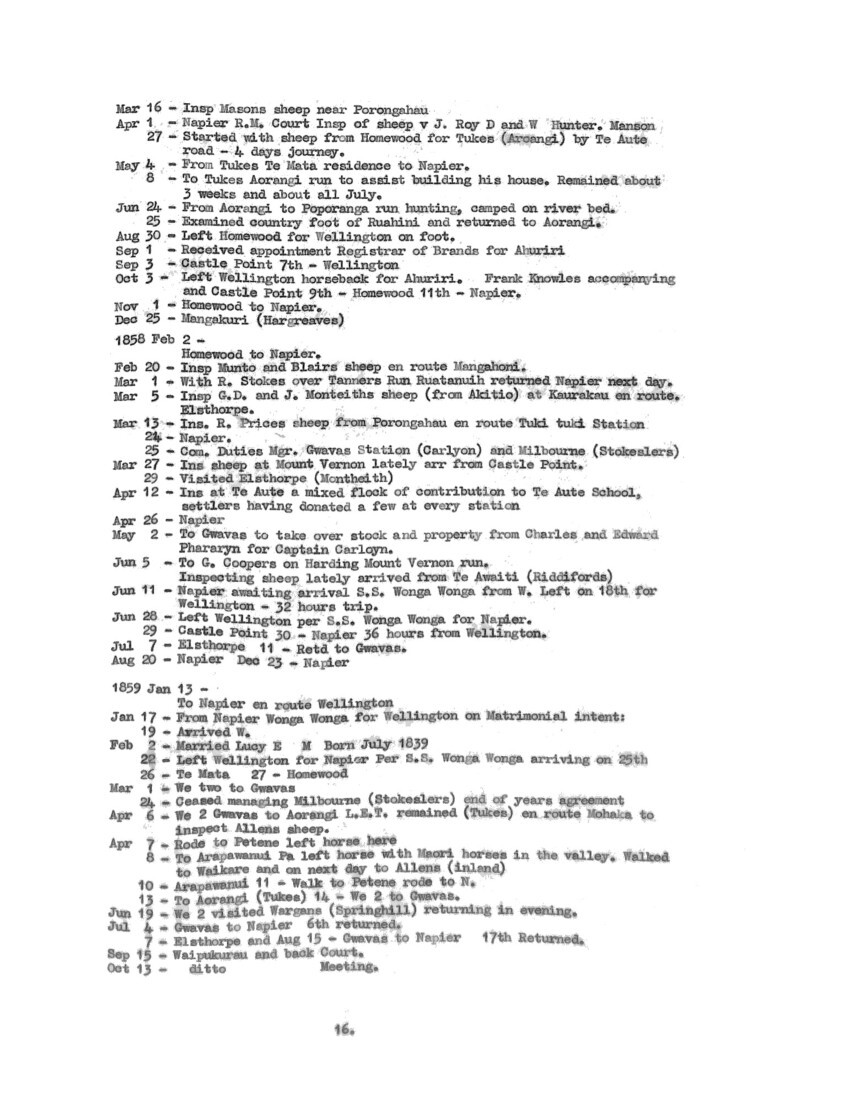
Page 17
Oct 30 – Chapman and wife visited Gwavas and on following day took L.E.T. Back with them via Rocky Point
Nov 1 – Left Gwavas on route Mohaka (Riddles)
2 – Napier to Petane 3rd – Left horse Arapawanui [Aropaoanui] valley, walked Mohaka – beach road.
Nov 4 – Left Mahaka [Mohaka], slept on hills over Arapawanui Pa.
1859 Nov 5 –
From fern hills over Arapawanui. Caught horse and rode to Napier.
Nov 8 – Napier to Homewood Milbourne and Gwavas
12 – Homewood 13 – Homewood to Edenham (Rhodes and Chapmans) Spotted future Elmshill – thence to Mount Erin Station (Munns) Waipureko)
Nov 14 – To Napier applied at Land Office for 950 acres on Edenham and made accom. house (Dyett) 15th – returned to Gwavas.
1860 Jan 2 –
Olivers Maraekakaho to N.
Jan 23 – Stokes v Tiffen Arbitration case Waipukurau H.R. Russell Stokes D. Gollan self.
Jan 26 – Ceased management Gwavas Station. We two to Homewood.
Feb 7 – Lambertford 8th – Drafting G. Bucks sheep from mine depasturing on terms.
Feb 9 – Drove G. Bucks sheep to A. Grants yards returning to Lambertford
Bucks sheep delivered to J.D. Canning.
Feb 13 – We 2 Homewood to Kohumuiarakau [?] (W. Cooper) 15 – return to Homewood
20 – We 2 Homewood to Pourere (Nairns) en route Castle Point
23 – 24 – Porongahau river (Lambs)
25 – Wanui [Wainui] (Herberts accom. House) 27 – Akitio.
28 – We 2 arrived Castle Point
Mar 7 – Akitio en route Homewood 8th – Wainui
10 – Oakbourne (Cannings) 12 – Captain Newmans Waipukurau
13 – Homewood
24 – Aorangi (Tukes) to Okawa (Lowry) and
Apr 1 – Sheep District being now divided the Southern portion allotted to me with my residence to be at or near the Southern boundary
5 – We 2 Homewood to Edenham.
6 – Com. removing by pack horse our belongings from Homewood and Te Kopanga Woolshed (on bank of River below Patangata) to Whare at Elmshill.
Apr 10 – Com. assisting Alfred Chapman to pack lambs wool from Edenham through Oero bush track to Kopanga Woolshed, on bank of Tuki tuki river below Patangata Pa.
Apr 15 – Our first days residence at Elmshill
19 – 20 – Woodlands (G.S. Coopers) drafting my sheep Apr. 25 – We 2 N. LET for Wellington. First fall of rain since August Waipawa River perfectly dry for 3 or 4 miles above gorge.
Jul 18 – Homewood to N. on Crosse v Tiffen sheep case. 29th – Case heard at District Court N. Verdict for Plaintiff £25 detained in N awaiting case 11 days 31 – Homewood
Aug 29 – Homewood Elmshill.
Oct 8 – Elmshill to N. 24 L.E.T. from Wellington 25 – Te Mata
26 – Reynolds Havelock 27 – We 3 Elmshill.
1861 Jan 1 –
To Napier Subpoena as witness under Native Land purchase Ordsance via Sealey Returned to Elmshill on 6th.
Feb 1 – Inspected Hunters sheep at Pukutu.
20 – ditto Wallaces sheep at Wainui.
22 – ditto Hunters sheep at Wainui.
Mar 5 – Took delivery 634 mixed sheep and sold 170 wethers at Woodlands (G.S.) Coopers on Mount Vernon where they had been depasturing on terms. Drove to Homewood en route Elmshill – 950 acres.
Mar 6 – Placed 633 sheep on my 950 acres Elmshill.
7 – Havelock 8 – Napier and Grange (Clive) 9 – Elmshill.
18 – H.S. Tiffen and wife and Ansell visit to Elmshill returning to Homewood.
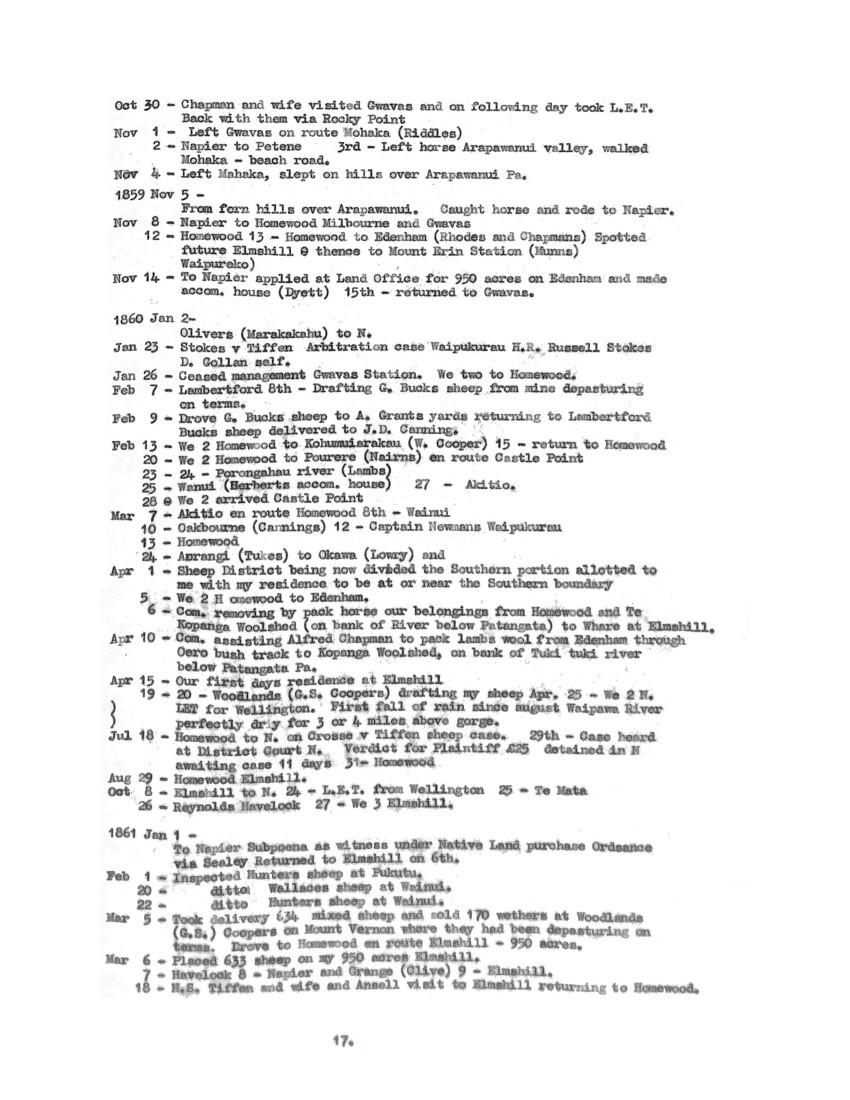
Page 18
Mar. 23 – Inspected Hunters sheep from Castle Point on their return at Porongahau.
Apr. 5 – G.D. Monteith for Wellington on my hores [horse] “Roaney”.
20 – J. Lawrence visited Elmshill.
May 10 – Inspected G.S. Coopers Rams at Woodlands lately from Riddifords run.
Jun 1 – Severe adze cut on right leg.
Appointed Ins. of Sheep and Reg. of Brands over extension of District
Oct 8 – G. Lock finished survey Livingstone land lately sold to me.
230 acres at 30/- 15/blk 46.
Nov 13 Inspected Hunters sheep in pens and on run.
19 – Brook-washed flock for shearing.
30 – L. Ansell T purchased on my a/c at Govt Auction 100 acres at 6/6 Block 51 Elmshill
Dec 9 – First shearing at Elmshill – 419 mixed. having brought in March last 533 sheep and afterwards sold J. Knight 200/422 E.
Appointed Returning officer for Waimarama District this year
Conducted 2 Elections of Members of provincial Council.
1852 [1862?] Jan 10
Conducted Election at Curtings Woolshed – Fitzgerald returned.
Jan 13 – To Napier and Havelock having taken Mrs. Welsh from Edenham to Clive yesterday.
Feb 7 – To Napier for Gov Land Sale. Purchased so called 740 acres at 5/0¼ applied No 851 by W.B. Rhodes forcing me to buy or he would do so! This block was found to contain 100 acres less than stated. 50 acres 10/- land secured to me later on as compensation
Feb 12 – Inspected Hunters sheep
Mar 3 – Heavy rain and flood about 400 Edenham sheep drowned on flat adjoining stream.
1862 May 26 –
Purchased of [off] Livingstone and McNaughton 220 acres. Residing much at Oakbourne (J.D. Canning) for fulfilment of Inspection of Sheep duties.
Jul 14 – Over hills to Mohaka 15 – To Spooners Wairoa Insp Riddles Sheep
Jul 16 – To Waikokopu (Fannins)
17 – To Mahia and return to Sturms Nuhaka
18 – Wairoa
19 – Spooners Wairoa to Mohaka 20th – re Insp sheep walk Coast to Waikare.
21 – Waikare to Arapawanui, caught horse rode to Petane.
24 – Elmshill
Aug 21 – Elmshill to N. Court case.
22 – Proceeded against W. Morris (Mahia) and R. & W. Riddle under Scab act. Believe I was in error here!
27 – Elmshill Prongahau. [Porongahau] Inspected St Hills sheep reported scabby.
Sep – Timber sawn for dwellinghouse Elmshill (since burned down)
24 – Left Elmshill for Mahia,
27 – Arapawanui now McKinnon the Maori – left horse in valley, walked to Waikare and Mohaka.
1862 Sep 28 –
Walk Mowhaka [Mohaka] to Wairoa.
Sep 29 – Crossed Wairoa river to Lawrences.
30 – To Fannins, Waikokopu
Oct 1 – Fannins to Morris (Mahia)
2 – With Campbell walked to Kuri Kuri by moonlight.
3 – Coast walk to Black reef (Walkers) Inspected sheep.

Page 19
Oct 4 – Returned to Kuri Kuri 3 – Mahia.
7 – Waikokopu Inspected Fannins sheep returned Mahia.
8 – Dressed 5 sheep showing Morris modus operandi thence to Sturms Nuhaka
11 – From Mohaka (Sims Accom. house) to Arapawanui – caught horse rode to McArthur’s, Petane.
12 – Sunday – rode to N in evening.
13 – Elmshill
Nov 6 – To N. Court Tiffen v Fannins Tiffen v Walker Lost case v Fannin.
9 – Inspected Munroes sheep reported scabby. Not so.
30 – Elmshill for Wairoa (Horseback to Arapawanui).
Dec 1 – Petane 2nd – To Waikokopu arrived midnight.
6 – Fannins shepherd J. Mitton refused to muster, returned Wairoa. midnight total eclipse of moon delaying.
9 – Left Sims (Mohaka) midnight for N hill road to Arapawanui, lost 3 hours finding horse. Rode to Charltons accom house, Western spit left horse, to N.
10 – Napier to Elmshill. Recd. appointment returning Officer for Porongahau.
1863 Jan 5 –
Conducted Election Curtings Woolshed E.S. Curting returned M.P.C.
Jan 6 – R.M. Court case Tiffen v Fannin Judgment for Plaintiff £7. Costs £2/11/8
7 – Fire in bush close to Elmshill Whare.
9 – To Porongahau to conduct election only 1 elector present, no result travelled all night arr Elmshill daylight.
19 – J Collins dray took Elmshill wool clip 1892 away from Napier 7 B/W.
24 – Inspected H. Bunnys sheep previous to their removal to Wellington.
28 – R.M. Court Waipawa – Alexander v Tiffen cost Plaintiff 19/- Defendant 9/-
31 – Conducted Election M.P.C, Porongahau in lieu of no result on 9th
J.D. Ormid [Ormond] elected – arr Elmshill 11 p.m.
Feb 9 – The second scotch thistle found on E.
13 – End of severe drought.
27 – Inspected Hunters sheep landed at Blackhead.
Mar. 2 – Porongahau to Elmshill arr 1 mid-day. Picked up between E. Parima and the gorge a small bag containing £201 (80 sovs). Met A.H. Price and Maori woman. Gave bag to Price to deliver to owner. Met Ihaka near Gorge who had dropped it, referred him to Price.
1863 March 14 – To Porangahau to inspect Hunters sheep landed at Blackhead two days ago.
Apr 8 – Left Napier for northern district on Inspecting duty. Rode to Arapawanui and walked remainder of journey arriving on 13 at Black Reef Walker, and on 20th Napier.
23 – Elmshill
May 26 – Royal salute fired N. heard at E.
Jul 14 – J. White arr C. to build house.
28 – To Porongahau on Reg of Brands and Earmarks duty.
30 – Waipukurau Aug 1 – Alex Grants Ruatanu,
Aug 4 – Waipawa 10 – Maraekakaho.
12 – Napier.
13 – Inspected Leicester Rams and Paraiti.
21 – Elmshill to N. and Havelock bundle trees.
Apr 25 – Militia meeting held at E.S. Curtings, lapsed for want of attendance.
Oct 5 – 3rd days drill (twice a week). Appointed Corporal and Acting Sergeant No. 5 Coy.
17 – Arms served out.
Nov 28 – To Maraikakahu [Maraekakaho] en route Te mahai and Black Reef.
Dec 11 – Elmshill – Militia paid self £6/7/6 Privates £2/2/0
25 – Gathering at Edenham, 5 sisters, Mr. and Mrs. Hargreaves, J.L. Herrick, J.E. Knapp, D.S. Hunter, F.M. Chapman Alf Chapman J Monteith
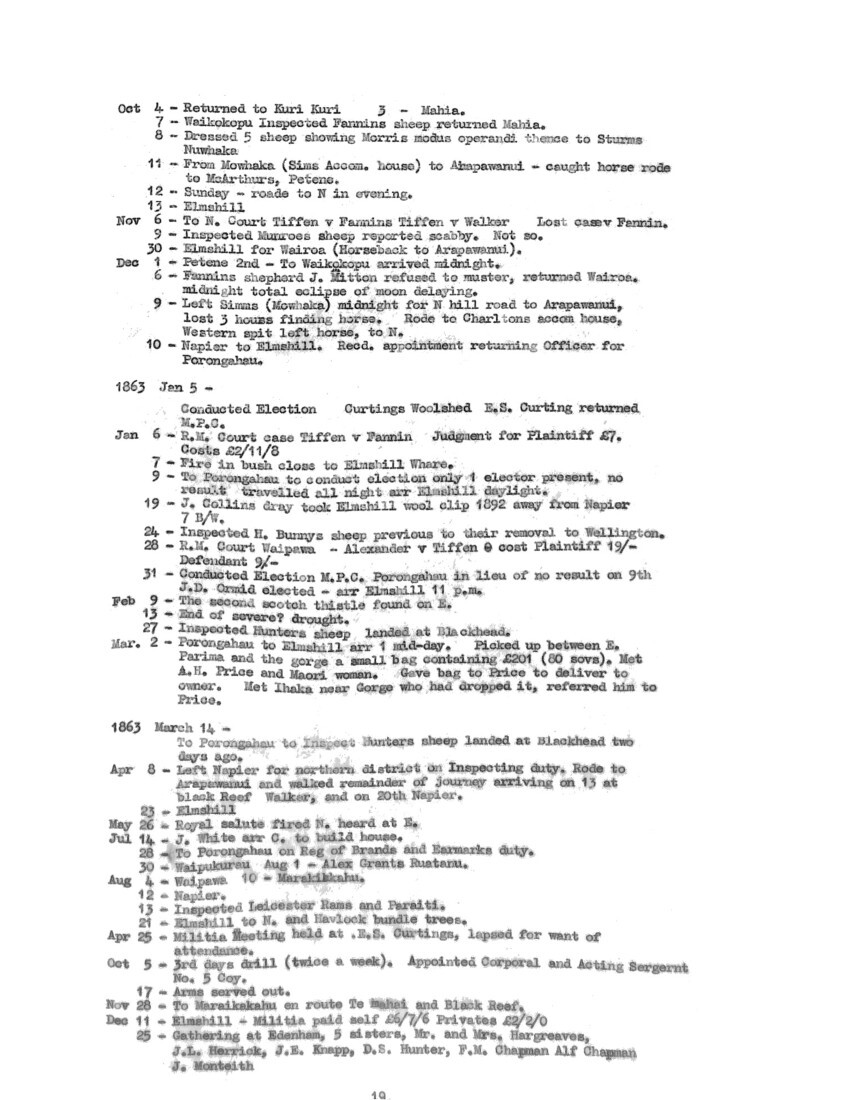
Page 20
1864 Jan 8 –
Elmshill to N. Applied for 160 acres.
Jan 11 – Inspected at Mount Herbert lately imported Ra.
Mar 9 – Boarded S.S. Lord Ashley in Roadstead to meet G.J. Neill.
10 – Wedding G.J.N. M.M.
26 – Met and inspect Hargreaves 900 Wainui.
May 25 – Resumption of Drill No 5 Company and self drill instruction to recruits (awkward squad) and occasionally full squad – 8 to 24 men ten drills.
Nov 13 – L. Ansell T. visit Elmshill
Dec – Population H.B. 3,770 N 1,337
1865 Jan 12 –
Inspected Cheviot sheep imported by Tucker (A Dean)
Feb 3 – Self, sun-stroke between Elmshill dwellinghouse and first woolshed.
28 – Inspected Edenham rams lately arr W.
Mar 4 – Purch. 160 acres 5/- land applied for on
20 – Took L.E.T., G.W.T. and M.E.T. to Homewood en route Napier by Tathams coach. F.A.T. previously taken by Barbara McKay to McKays res. Near Tanunui Pa.
Apr. 11 – Return to Elmshill.
May – More Drills commenced.
Sep 2 – Drills finished.
3 – Nov 26 – Dec 14 – E. to N,
1866 Jan 3 –
Purchased 60 acres bush (47 B) of John Wilkinson at 30/- per acre.
Jan 8 – Brought Mrs Henderson to Elmshill.
Mar 7 – Rifle Match Patangata (Kellys) Prizes my colt and tea service. J. Weston won colt. R. Small T’other,
12 – My flock mustered under warrant by Chapman to recover his stray sheep.
Apr 12 – Waipawa R.M. Court Tiffen v Samll [Small] (E.S. Curting) for droving without giving notice.
May 1 – G.D.M. obit N.
15 – Chapman and family removed from Edenham for residence N where they remained until end of Sep.
Jul 5 – Drafted 54 Edenham sheep from my flock. Impounded them in my pens (allowable by Act then) claimed impoundage 0/- costs drafting 24/-. Impounded also 8 (?) working bullocks. Claim 5/- at Waitukai pound. A. Chapman and Men to Elmshill to rescue them
Assault made with ship handle by A.C. resented with interest with spade blood flowed freely, self brought to earth and nearly choked besides receiving a christening of gore.
11 – Self Waipawa to obtain summons for assault A.C. preceding me on similar mission. Bound over to keep the peace.
13 – Served summonses on A.C. Per J.M. A.C. Being in Napier.
1866 Sep 2 –
A Chapman’s slut and pups attached [attacked] my sheep, followed them up and got a shot at them. Went to Edenham and reported same to T. Crouch (A.C. being ill in Napier) Several lambs bitten and 3 killed. Took the dead lambs to Edenham and got Peter Hart to come and look round – another dead lamv [lamb].
6 – Penned 115 sheep and 18 lambs of Edenh. J.M. came and redeemed them paying £2/6/2d impoundage.
Oct 3 – Chapman’s dray to and from Homewood with family after 4½ months res in Napier.
Dec 29 – Served summons on A.C. and subpoena on P. Hart Damages claimed £3/10/0 (A.C.)
NOTE The past year’s squabble and retaliation (see next entry) was based on A.C.’s action in mustering my flock under Magistrates’ Warrant on March 12 – just to suit him
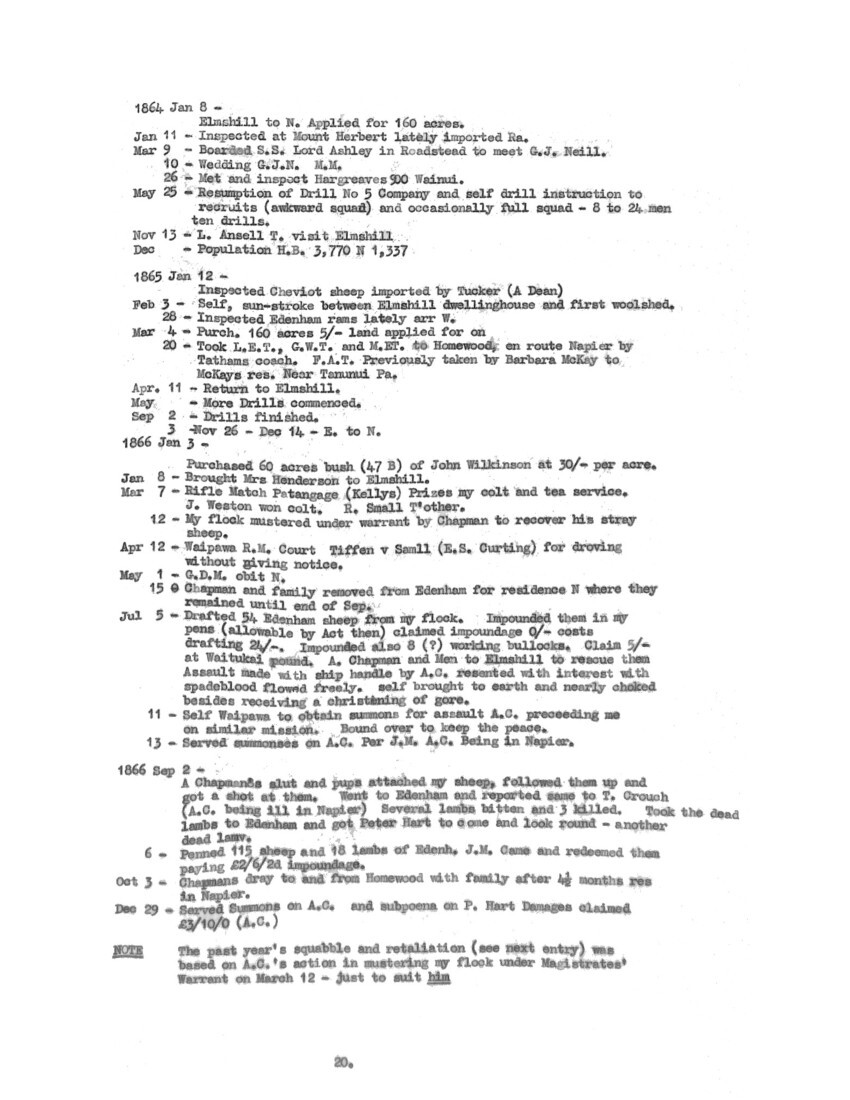
Page 21
1867 Jan 9 –
Waipawa Court. Tiffen v Chapman. Self obtained Judgement 3. 2. 0.Damages also costs. This case postponed from Sep on account A.C. illness in N.
Jan 20 – Mrs. D.S. Hunter resting at Kellys (Patangata)
21 – K.M.M. Edenham to Kellys en route Porongahau.
Mar 11 – Conducted nomination Curtings Woolshed. J. Weston returned M.P.C. for Waimarama,
Apr 1 – Visit for Ashton St. Hill to Elmshill on Registrar of Brands Business.
25 – Inspected a few Leicesters at Wm. Nelsons (Capt Newmans) also 1 imported Ram at Ormonds.
Also next day 1 Ram and a few ewes at Hunters.
27 – Inspected 4 Cotswold Rams at Pourere and retd to Elmshill,
May 4 – Mr. Ellison senior and his son laying off 80 acres swamp at Rocky Point prior to Auction. Application 1768 pt blk 83.
6 – Inspector G.S. Coopers sheep lately from Te Awaiti also on 9th (G.S.C. held land on Mt Vernon)
19 – G. Peacock Inspected Sheep Middle District to inspect G.S. Coopers sheep Declined to accompany him (Agitation floated by meddlesome Lord Henry. H.R. Russell) much private and public correspondence).
26 – Purchased on my a/c by Newton Irvine and Co. my Agents 80 acres at 5/ applied for by me on May 4.
Jul 8 – J. Monteith removed from Edenham to reside at Elmshill.
1867 Sep 10
Self and wife Witherows 11 – Porongahau
Sep 17 – ditto 18 – Elmshill
29 – K.M.M. to N. Oct 1 – Te Mata 2 – Elmshill
Oct 4 – J.M. LET AND K.M.M. Pourere en route Porongahau
17 – Self E.W. Porongahau, wife ill.
28 – Self and wife Porongahau to Mangatarata
29 – ditto Elmshill, Gollans.
30 – Mrs. D.S.H’s child Mary to Elmshill K.M.M. to Edenham,
Oct 31 – My last days Inspection of Sheep and Reg. of Brands – refused subinspectorship.
Nov 8 – K.M.M. by Cobbs Coach to Napier
Dec 5 – K.M.M. to Elmshill.
1856 – First return of Sheep Porongahau river to Ahuriri 55,097
Last return of Sheep Waimata (Southern boundary)
Mahia (Northern) 459,694
1868 March 25 –
Pourere purchd 27 half bred Cotswold rams
Apr 10 – J. Lawrence with sheep for grazing a year.
May 4 – First fall of rain since Aug 15.
Jun 1 – Purchased at Napier 10 acre bush land Oero 1O/- also 269½ acres 10/- app 2104 Blk 95.
3 – Liberated 1 cock and 2 hen pheasants from Napier
17 – Course of River Waipawa altered through heavy flood.
Dec – Militia drills ? Ida Zeiglar wrecked N. 33 B/W F.J.T.
1868 Jan 4 25-
Drill a good deal.
Feb 1 – Court of enquiry held at Waitaka drill ground sentenced to 48 hours detention Waipawa Court House.
20 – The first wheel vehicle through Oero bush road – Dillons dray
Mar 15 – Self and wife Homewood en route Porongahau
26 – Delivered Lawrences sheep grazed since 10 April last year.
May 11 – July 2 – More Drill – constantly absent.
31 – Self and wife N. June 7 – returned Elmshill.
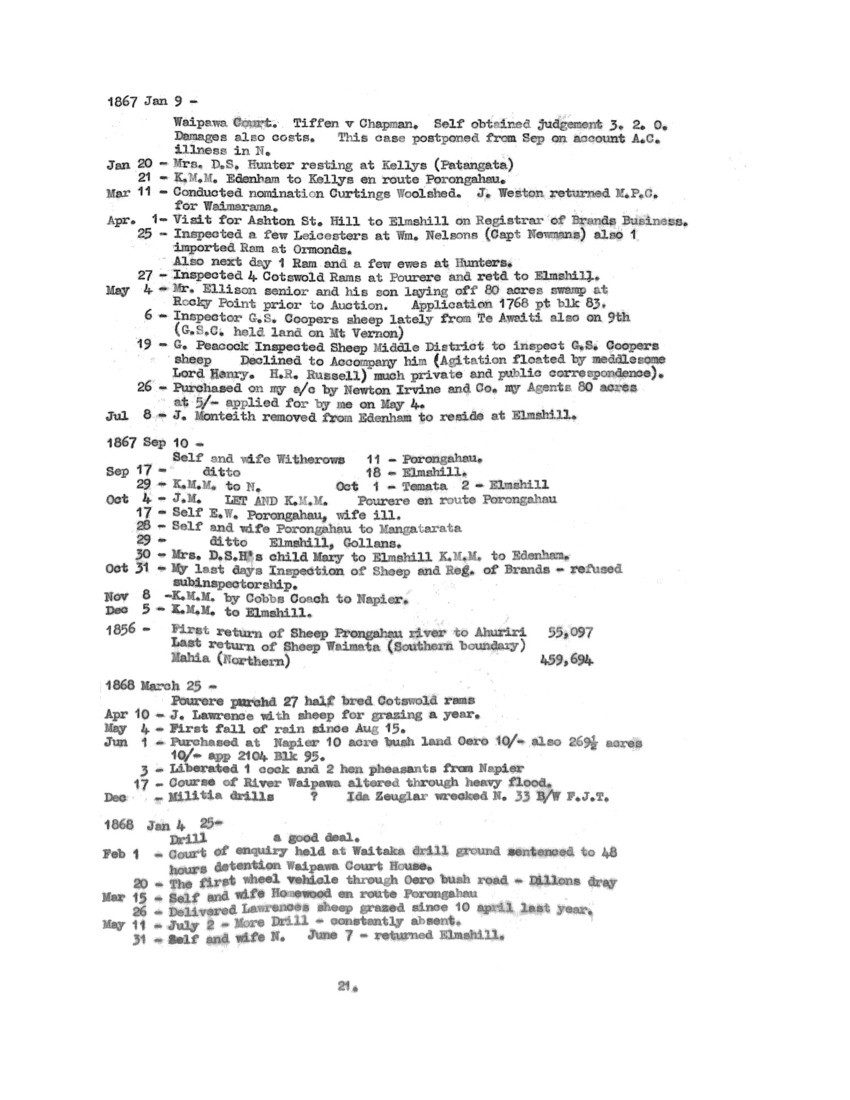
Page 22
June 24- Land Sales Napier.
Sep 20 – K.M.M. and M.E.T. Homewood en route N.
Nov 9 – Conducted nomination Curtings Woolshed W.R. Russell retd M.P.C.
30 – Jones for Mrs. Henderson. Self Hampden to Pur sheep dog.
Dec 1 – Retd from Hampden with dog.
1870 March 6 –
Self and wife Elmshill to Oakburn for dance, given by J.D. Canning and Mrs. George Moor (his sister) 7th – Dance Hunters, Self left day light for Elmshill having pre-arranged to meet sheep Inspector Peacock to pass Newmans 183 sheep as free from footrot, they said sheep having been grazed by me.
Mar 10 – Elsthorpe over trouble between J. Buchanan and Watts Brs.
12 – Self E. to Porongahau for wife, Retd. to Elmshill via Pourere and Atua Hill on 14th.
16 – Elsthorpe sheep mustered under Warrant obtained by Watts Brs.
Thorn and J.B. made prisoners for obstructing. Self slept at Elsthorpe to look after Jim. J.B. returned at midnight. Let the mustered sheep out of his yards wounded (by shot) one of the musterers dogs. The musterers, Roper, Trask and Kebberley, being at Edenham for the night.
17 – Self served summonses obtained by J.B. on Kebberley, Roper Trask and Wheeler for breaking roof Elsthorpe Woolshed which they did for a peephole, and other 3 with breaking gates with view to removing wool from Wool shed carted by A. Dillon. Self to Edenham to declare before a J.P. (A. Chapman) that I had served the summonses.
1870 Sheep re-collected on Elsthorpe at 5 P.M. J.B. ordered the musterers off.
Mar 18 – Sheep musterers and constable Hebberly left for Napier
May 16 – Self and wife and Fred Elmshill to Homewood en route N.
Jun 17 – L. Ansell T. visits E.
22 – Periodical booming as of big guns (Eruption of Tongariro)
26 – Boomings at intervals of 3 to 10 seconds,
30 – The 8th day booming
Jul 2 – Earthquake.
7 – Booming at long intervals when 3 explosions at about 2 seconds interval occrd.
9 – Similar triple explosions about 5 min between each 3
14 – Accidentally shot my sheep dog “Stranger” whilst pig hunting – the 50th pig since June 1 (Fencers by Block 47B also shot about 30 same winter).
17 – The last booming of Tongariro.
Aug 5 – Shot 4 wild pigs, the 64th since June 1
6 – Shot 6 wild pigs 15th – Killed the 80th
27 – Killed the 90th
29 – Tongariro again heard, the second erup being from 20 June to mid July.
3 – Still Booming – killed the 100 wild pig. Total self and men 134.
1870 Oct 20 –
Sheep washing in these days. Sub Inspector A.H. Price called en route Elsthorpe to inspect sheep.
Oct 20 – To Terawera [?] Brought Mrs. Ford to E. 24 – F.L.T. Born.
1871 Jan 9 –
Self and May to Kaikora en route N. on visit to Louisa. Remained here years
Mar 8 – Nomination Member Prov Council Arthur Edward Russell and J Buchanan nom.
21 – Poll in Elmshill old Woolshed J.B. retd.
Jun 13 – Rev S. Williams to Elmshill Christd. H.E.T. F.M [“L” handwritten].T.
21 – Stated [Started ?] boiling down for Tallow. Warranga and Hoani Killing. Plant consisted of a 400 gal iron tank. 40 wethers at a boil.
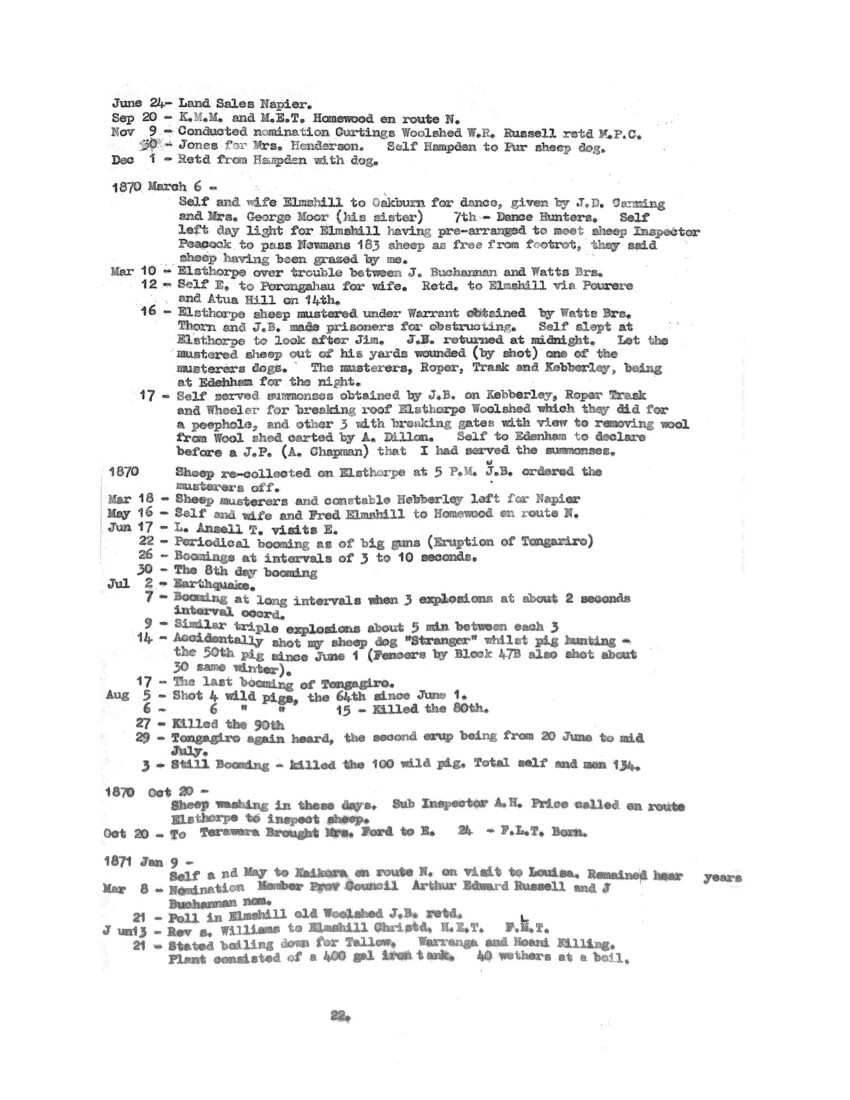
Page 23
Aug 27 – Court of Petty Sessions Waipawa Harrison v Tiffen claim £5.
Verdict for Plaint £4/11/-
1872 March 19 –
A.H. Price Insp of Sheep inspected 850 Sheep at Elmshill belonging to J. Monteith prior to removal to Pourere. Any suffering from footrot not allowed to go. This measure soon allowed to fiz out.
May 6 – 14 – Self and wife Homewood Napier Porongahau Waipukurau
29 – L. Ansell T 3 days visit E.
Nov 11 – Self and wife rode to Pukatu [Pukahu] S. Collins Cobbs coach to N. There 4 days.
Dec 10 – E. To Waipawa Costello and Curtis v Tiffen Verdict Plaintiffs my witness too drunk to appear.
1873 April 24 –
H.B. Sealey (Com Crown Lands) on Elmshill certifying to land on Edenham applied for by.
Apr 26 – Self E. To N. via Kaukora [Kaikora?] flooded river and roads at K. and Pukatu reached Havelock (Reynolds)
28 – Applied at Land Office for the land applied for Found H.B.S. Com Crown Lands had connived to allow A.C. on a/c Rhodes and Chapman to purchase same before the appointed time. This formed a Court case later on amongst other charges preferred against the Com Crown lands.
May 4 – Self E. to N. to interview J, Buchanan in reference to Com Sealey’s action.
Jun 10 – Rhodes and Chapman dissolved partnership Edenham run.
1873 June 20 –
Self J. Buchanan and Surveyor Ellison over Edenham run examining the various blocks for sale.
Jun 27 – Self J. Rhodes junior and Ellison ditto
Sep 7 – Self over Terawin (Curtings run) examining land advertised for Auction on 25th.
24 – In Napier for to-morrow’s Auction of Gov Land purch of A. Luff his bush section part blk 18 Oero. Sold to him part suburban sec No. 412N. (Top Milton Road)
25 – Gov Land Sale N. purchd, 1556½ acres on E.S. Curtings run. By Memo of adjustment with R Curting’s agent (Rev J.C. Andrews) exchanged portion of my purchase for River Paddock and part of Terawin Agreeing to sell balance to R. Curting’s agent. Paid receiver Land Revenue, John Curting (no relationship) following day Hon, A.G. Tollemache’s ch on B.N.Z. £2471/10/3
1874 Jan 3 –
Recd telegram A.C. [“A Chapman” handwritten] death Self and wife left Elmshill at 8 p.m. arr Pukahu 2 a.m.
Jan 19 – Self and wife and Willie to Patangata (Dillons)
20 – A. Dillon drove children to Pukahu Self and wife and Willie riding. Self Cobbs coach to N. occupying residence in Clyde Road.
22 – Lucy to Napier road with J.D. Canning children followed afternoon by Hunters trap.
Feb 12 – Attended Auction Crown Lands Self J. Buchanan and J. Rhodes Purchased the whole 38 lots of Edenham lots with view to an adjustment following purchases were made by alternate bids Tiffen – Rhodes Buchanan. Adjustment followed, J.B. and F.J.T. having each 2,000 acres secured to them, they abandoning to J. Rhodes all interest in excessive areas purchased by them.
Record of Sale F.J.T. 12 Lots 2820½ ac. £ 708 1 3
J.B. 13 Lots 2106 851 6 11½
J.R. 13 Lots 3229½ 810 19 9
156 £2370 1 11
24 – Ac@ 5/- Ac 5/0¼
As Executor late A. Chapman purchased James Irvines house ¼ acre Emerson Street Napier for £300 for Mrs Chapman and family
Jun 1 – Killed first wild pig of season 21 during June.
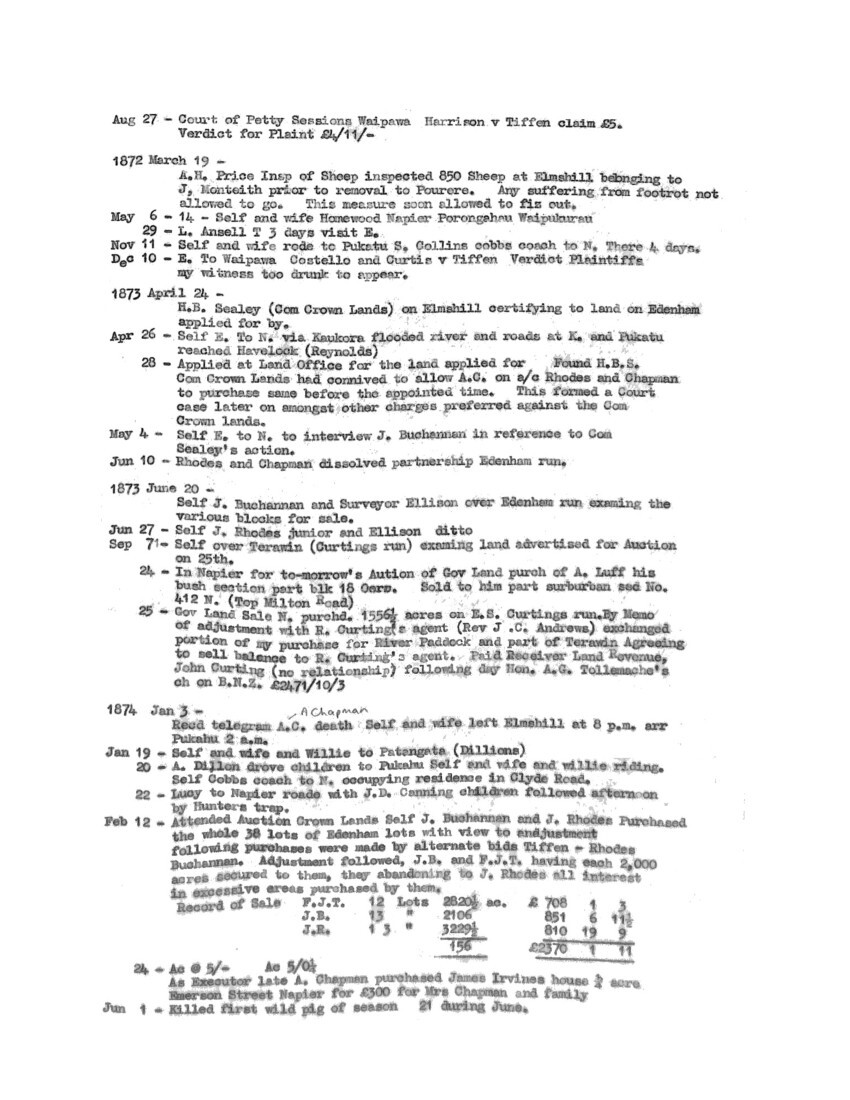
Page 24
June 3 – Killed 5 wild pig within radius of 10 yards.
30 – G.W.T. in truck N. to Waitangi the Railway being constructed to there.
1874 Sep 4 –
Measured for payment Rhodes – Tiffen fence over the Downs, 238 chains.
Sep 29 – E. to Kaikora to meet wife from N.
Oct 5 – Took wife to Kaikora – coach to N self following on 14th
18 – Self N. to E. shearing retd 19th
30 – ditto retd Dec 24.
Dec 31 – H.S.T, Conveyed to me Sec 37A Homewood 19 acres 1 rood reg. No 9052 Since sold Butler.
1875 Jan 5 –
N. to Greenmeadows Elmshill 5th
Jan 6 – J.E. Knapp to Patangata Pa for shearers.
Apr 7 – N. To Pakipaki by rail to K. by coach Walk E.
26 – Appointed Dep Ret Officer to take poll on 17 aprox J. Buchanan E Bennett.
May 18 – E. to K. en route Napier Cobbs coach full rode to Pakipaki train to Napier found wife and 4 children ill of scarletina – a fifth next day and 7th and self following my firs [first] days confinement to house for over 20 years.
25 – Subpoena Grand Juryman for 31st inst.
Jun 7 – Special Juryman (cast) Paora Torotoro v Sutton
11 – Special Juryman – Seal v Steel libel case
Jul 29 – N. to E.
Aug 19 – E. to N.
Sep 8 – L. Ansell T left N. for Wellington by rail and arr 8 p.m. 10th
10 – Self left N. per S.S. Rangatira for W.
11 – Arr per S.S. Rangatira met Ansell on wharf L.A.T. obit at 11p.m. 10th my first visit to w. for 16 years.
13 – Funeral Louisa Anne Tiffen.
20 – Self left W per S.S. Rangatira 24 hours trip.
30 – Rail to Pakipaki coach to K. rode to E.
Oct 15 – Peter Hart to K. meeting Willie and Fred from Napier.
16 – E. to Havelock, left horse there, walked to Hastings, rail to N.
1875 Oct 23 –
N to Hastings by rail Havelock by coach, rode to Elmshill for shearing,
Nov 7 – Self and boys G.W. and F.A. over Silver Range re Tiffen – Buchanan fence saw H. King the erector.
25 – Shearing ended.
26 – Self E. to Havelock, walked to Hastings. Train to N.
Dec 13 – N. to E. for grass harvest (obtained 150 bush unwinnewed) [unwinnowed?]
1876 Jan 1 –
Self rode E. to Hastings leading spare horse – to N by train
Jan 3 – Peter Hart killed by fall of tree limb in Oere bush whilst shearing. Injured at noon died at 8:40 p.m. G.W.T. to Waipawa and back for Dr. Todd Coroner.
Jan 4 – Self wife and 5 children and servant N. to Hastings en route Elmshill to remain awhile. Stopped at Hastings all day expecting trap. Cracknell arr at 3 p.m. instead of previous day. News of Peter Hart’s death.
5 – Left Hastings ¼ to 6 a.m. arr E. 2 p.m. Funeral same afternoon and heavy rain all night. Grave left open upon chance of father arriving. Did not arrive – grave full of water and coffin floating. Much trouble filling in.
Feb 14 – Self E. to N. returned on 19th.
Mar 2 – H. King and self measuring Tiffen Buchanan give – and – take line
Silver Range, also cross line Terawin – Tiffen – Curting.

Page 25
1876 March 3 –
V Hitchens dray with 5 children from E. to River by dray. River to Hastings in trap. Self and wife riding – Rail to N.
Mar 6 – Self N. to E. leading spare horse.
Mar22 – Self E to N
May 8 – Self N. to E. leading dog Toby. Tuke tuki [Tukituki] so low at Ngawakatatara that Toby had not to swim. He deserted on 13th.
21 – J Britton with 30 head cattle for grazing on Elmshill.
24 – Self and man widening outlet drain.
Jun 14 – Rode to N. on “Princess”. Peter Hart’s estate for sale.
Jul 21 – Self N. to Te Aute by rail, Kaikura [Kaikora] by coach Elmshill horseback
26 – Rev S. Williams and 3 others through Elmshill en route funeral Mrs Nairn Pourere.
Aug 22 – Self N. to Te Aute and Elmshill.
27 – Self and 3 others killed 12 wild pigs on one mob wrot(?) home 3
Sep 9 – Self rode to K. Rail to N.
18 – Partial eclipse of sun.
21 – Self rail N. to K. rode to E. for docking
Oct 16 – Wife and Frank N to K K.to Patangata by express rod(e) to E
28 – Self wife and Frank by Hutchens trap E. to K. Rail to N. Self saw H.S.T. for first time since his return from England with niece (Mary Randall)
30 – Self N. to E. for shearing,
Dec 11 – Self N to K leading spare horse train to N.
14 – Self N to Elmshill J Buchannans nomination.
29 – Wife and 5 children servant girl N. to K by train K to Patangata by express, and to Elmshill by B. Hitchings dray (Bullock)
1877 Jan 8 –
First board Meeting Oero District held in Elmshill Woolshed,
Mar 19 – “Ocean Mail” Woolship wrecked at Chatham Islands 6 B/W F.J.T. lost
May 11 – Tidal wave from South Africa.
21 – Oero Road Board Meeting E Woolshed.
Jun 19 – On Special Jury Kennedy (Telegraph Newspaper) v Carlyle and others (H.B.H.) self held out against the 9 jurors until lapse of the 3 hour limit.
30 – Agreed to purchase lease Sec 197 Napier held by Mairia Nell from Mrs Withers for £11 goodwill and to pay owner £1350.
Jul 19 – Collector of Dog tax first visit in that capacity.
Aug 3 – Self wife and 5 children to K en route N.
Sep 7 – Self N. to E.
Oct 2 – Agreed to let house Clive Square (late M. Neils) to Working Men’s Club, purchasing price in 2 to 5 years £1700 (surrender lease after 2 years)
3 – Self Napier to Elmshill for docking,
26 – do N. to E. for shearing also Fred and Frank ret to N. Nov 14
Dec 10 – Grand Jury N
12 – Self and H.N. to K. By rail carrg [carriage] Henry in front to Elmshill
1878 Jan 12 –
Jan 12 – Started from N en route Elmshill with Mary Ida Winnie and Frank Miss Vaughan and Servant girl by rail to K thence by V. Hitchings trap
14 – Self to N.
18 – Auction of household furniture & Co by E. Lyndon at our Clyde Road residence.
21 – Self and wife N. to Homewood (4 years residence at Clyde Road ended)
22 – Arr Elmshill wet through.
Mar 11 – Contracted with O. Beil to dig outlet drain 2 chains long 8ft deep x 4ft across bottom x 5ft across top Price £20. and find himself and mate. Contract fell through, Andrew Steffensen came to take up the job, reaching deep water and deep mud.
Apr 12 – Self and wife N. to K. on next day to E.

Page 26
Jul 3 – Self E. to K. rail to N. Retd on 6th.
20 – Took soundings found 4½ft water arranged with Steffensen to lower drain a further 5ft for £45 with bonus of £5 if 6 ft of water removed thereby.
Aug 8 – T. Floyd and self on Rabbit Island (then being rapidly drained) 4 full grown and earmarked turned out by A. Chapman long ago were found also 3 or 4 young ones and next day killed a further 4 young ones.
11 – By aid of Manuka laid on boggy parts self reached Rabbit Island whilst others were there by canoe.
1878 Sep 30 –
Self E. to N.
Oct 9 – First 2nd and 3rd Draining Contract finished by Stephenson (Steffensen?) (Com 3rd April)
10 – Self E. to Hastings (Show) To Kaikora Elmshill next day,
15 – Took wife to Kaikora en route N.
21 – Returned by rail to K. Bullock dray to E.
Dec 16 – Stephenson (Steffensen?) and mate comm lower outlet drain a further 4 ft making 12. Self and wife E. to N.
19 – Self ill swamp fever and diarrhea.
20 – Self and wife N. to Kaikora late train.
21 – Retd to Elmshill (Self all right) on 24th
A droughty spring and summer sheep constantly getting bogged there draining was affecting the swamp.
1879 Jan 5 –
More rain fell to-day than since Aug 1877
Jan 6 – Self and wife rode to K. Self retd wife to N.
13 – Anderson and mate started swamp draining price raised to 3/- a yard.
Mar 14 – Anderson and mate completed removal 8 ch Papa and 24½ ch soil and mud.
16 – Self and wife to Witherows Next day to N.
25 – Anderson and Logan took swamp contract.
Apr 5 – Self rode to K. train to N. retd to K. rod(e) to E.
30 – Misses Luke and Mclnlay creek bound at Elmshill until May 10th
Jul 10 – About swamp-slips blocked drain contract for re-opened same.
16 – Wife, Henry and Frank to Waipukurau (Warrens) next day Kaikora and Homewood by dray to River (Wards) next day E by Bullock dray
30 – Self E. to N. retd on Aug 1.
Sep 4 – Final draining contract Anderson
8 – W. Russell shepherd Edenham sends a/c for dog shot 21st Jul £12
Dog wounded on 1st Sept £8 very true but a/c ignored.
20 – P. Diamonds infant 5 days old died, buried by Peter Harts grave on 22nd.
Oct 23 – Self E, to Homewood 24 – to N. 25 -E.
Nov 27 – Willie N. to K. walk to E. Dec 24 – W. Cotterill to E.
1880 March 20 –
Heavy flood causing Waipawa river to alter its course and pass through
Homewood run to Patangata.
May 19 – Self and wife and family (6) and servant girl N. to Kaikora by rail and to Elmshill by Limpust dray. (Remained at E. Until ).
Jun 26 – Drain contract let 100 ch.
Sep 22 – Rabbit rate first collected.
20-2 dogs amongst flock Anderson shot 1 and brought the other to me.
Killed it (these belonged to F. Floyd 6 dead and wounded)
Oct 23 – Prop tax farm Real £18170
Personal £5166
Nov 11 – Self E. to N. to see Ansell lately retd from his four (?) and suffering from dysentery.
13 – N. to Homewood 14 – Elmshill
Christmas Day. Self and wife and children at Elmshill. Mr. Wolf visit also.
1881 Jan 1 –
Hail shower – frost last night.
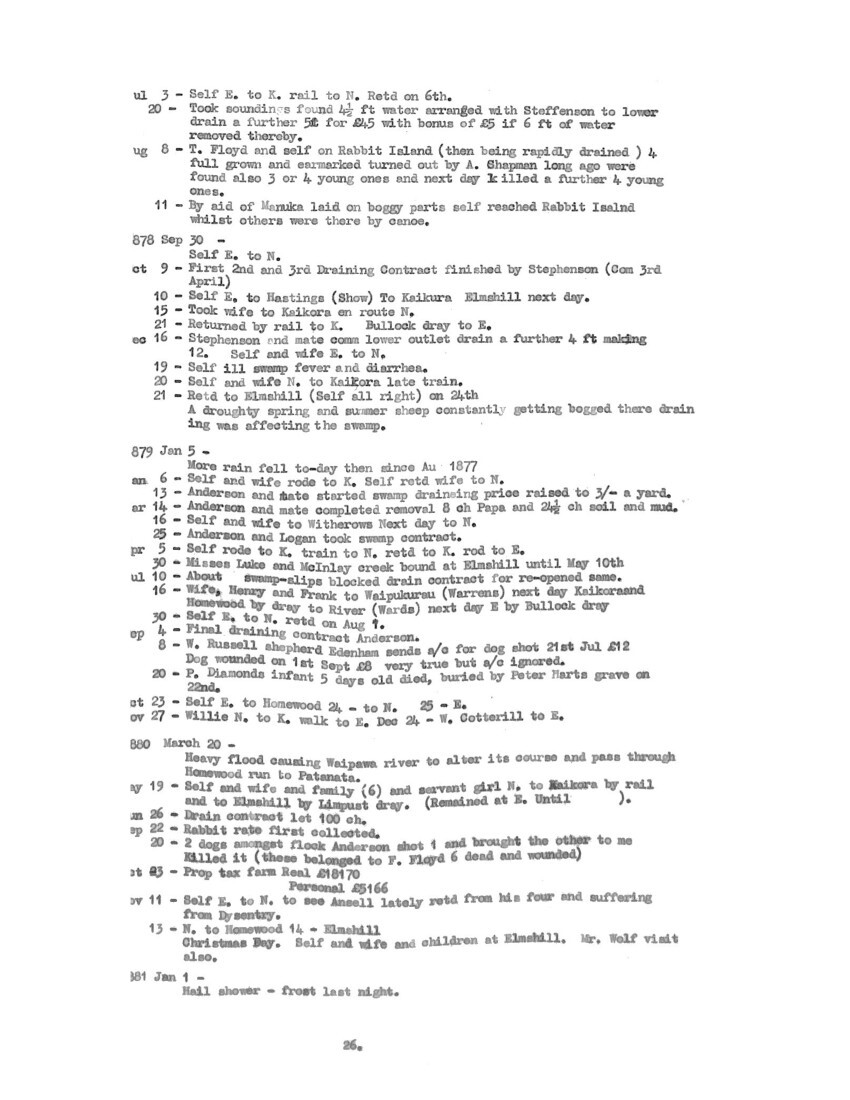
Page 27
Jan 15 – River paddock leased to J.N.W, for 3 months at £10 per month.
25 – Self and wife and family E. to N. (at Elmshill since Jan 12/78)
Mar 2 – Found about 240 shorn lambs in swamp drains.
13 – Self, wife and Mary left N. for Wellington per S.S. Arawata (22 hours passage).
24 – Self rail W. to Featherston, walk to Pigeon bush on visit to W.L. Lucena.
26 – Rode Lucena’s horse to Greytown, Carterton and Masterton Hotel Calling at Mania (W.H. Donald)
27 – Rode from Hotel at Masterton to Hotel at Hurunutorangi (a rough shop)
28 – To Bunnys on our old Ahiaruhi run, also to Buck and Kembles, old Ahiarui, Greytown, Featherston and Pigeon Bush W.L.L.
29 – Over W.L. Lucena’s Dairy Farm, and by train to Wellington
Apr 3 – L. Ansell T. arr W. (From N.) en route Melbourne and England.
8 – Self and wife and Mary left W. for N. (22 hours pass)
25 – Self N. to K. and E. May 14 – retd N.
Jun 7 – Do N. to K. and E. 18-19-20 and 29 – Earthquakes
27 – Self Henry and Frank E. to N.
1881 – Aug
Self N. to K.
Jan 18 – Self Henry and Frank rode E. to K. Rail to N.
Apr 1 – Henry and Frank E. from N. C Dunk accompanying from Homewood.
C Dunk returned to N.
15 – Possession of Willow paddock given J.N.W. for 4 years
May 3 – John Hard Anderson commenced raising house Clive Square 3ft for
£59.10.0 Filing (Filling (?), Piling (?)) in contract £69
May 15 – Self N. to E. 27 Retd
Jun 9-10-11 Heavy Floods. Railway com (from ?) N. to Farndon only Clive suffers
Jul 7 – Self N. to E. Aug 19 – Return.
Sep 9 – H.S.T. and niece, Wigington, Milly W and Ansell from England via Auckland.
14 – Self N. to E. 22 – Wigington N to E to 17th Oct
30 – Self E to N
Oct 1 – Witnessed the magnificent Comet
12 – Self N to E.
1882 Nov 7 –
Self and Willie E to N.
Nov 17 – First fine day for a fortnight.
Dec 5 – Self N to E lamb shearing
27 – Frank and Henry N to E 29 – Fred to E
1883 Jan 1 –
At Napier Self and wife and Winnie, at E Frank, Henry Fred
Jan 13 – Self E to N (at E since 26 Dec)
21 – Self N to E Feb 10 – Retd to N
Mar 1 – Self N to E
22 – Wife Winnie and Frank retd to N self following on 18th prox by rail to K walk to E Bridge in course of erection at Waitukai.
May 12 – Self E to N retd June 5
29 – Ditto N retd Aug 8
Sep 8 – Ditto retd Sep 24
Oct 10 – Ditto retd 17
Nov 2 – On urgent telegram from Wilson and Cotterill Self Elmshill to N retd 7th
Dec 8 – Self E to N 28 – N to E also Henry, Frank, 2 Caro’s. Hodds cart K to P, walk to E from Patangata.
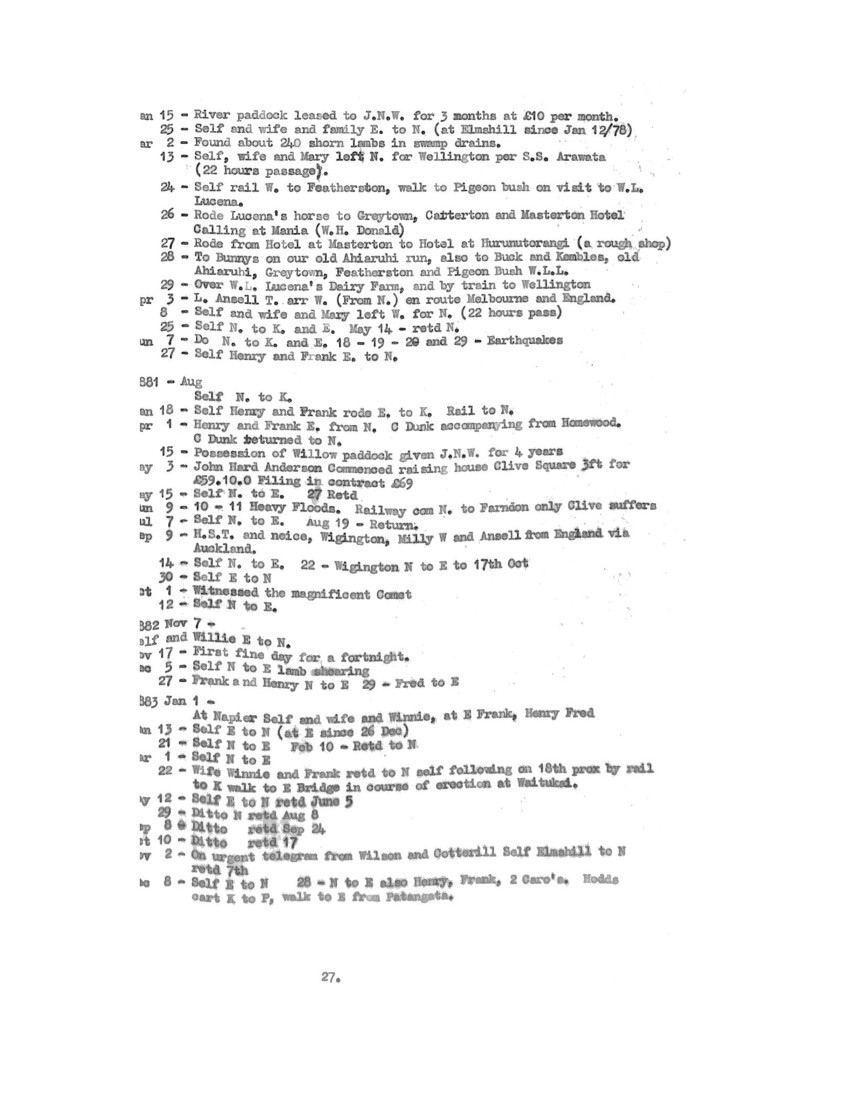
Page 28
Dec 31 – Maori dogs from Edenham attacked stud flock 5 or 6 bitten (2 since died).
1884 Jan 25 –
Self to Kopanga (Curtings) en route N.
Feb 11 – 12 – Self with Southdowns N to K and Homewood and Elmshill.
March 1 – Wife, Fred, Frank and Winnie N to E. remained about 10 days.
2 – Self E. to N. (at E since Feb 12).
12 – Self & W. Irvine N to E.
May 24 – Self, wife & Winnie E to N
June 11 – Self N to E. retd to N. 25th.
Aug 1 – ditto do 26th Aug.u
Sep 8 – ditto do 19th Oct.
Oct 25 – Self N to K led dog to Ashtons, Patangata, and walked to E. Next day.
Dec 19 – Self E to N. (at E since Nov. 26).
1885 Jan 1 –
At N. self & wife, Ida, Winnie & Willie, at E Frank & Henry, at ChCh Fred.
Jan 16 – Wife N to Waipukurau & Innesmore (Warrens) retd next day.
20 – Self to N to K and back by special train engaged by N. Harbour Board to facilitate voting for proposed breakwater.
Feb 9 – Self and Fred per S. S. Wairoa for Wairoa arr/ng next day. Walked to H Nairns Liston Station. Fleas! Rode over property with view to purchase.
1885 Feb 13 –
Self & Fred retd to N. from Wairoa.
Feb 28 – Self per S.S. Te Anau for Gisborne, run hunting. First visit to Gisborne.
March 3 – In company of G. Stubbs rode to Aroha run & station ( brs.)
10 – To Mangatai Kapua (Campbells)
18 – With J. MacKay rode to Paretu – rain arrived at Whare-onga-onga Pa Rough and slippery travelling.
23 – Self and 2 Miss Campbells rode up river to Waipaoa Station returning in a downpour of rain. Next day G. Stubbs and Station Manager ( ) from Waipaoa to Campbells through flooded river.
25 – Self & Stubbs to Puhatikotiko (Montmottens) Rode over portion of run (Horse fell). Purchased occupiers interest later on. Acquired further shares from Maori owners. Faced the Validation Court thereby legalising claim to nearly all my purchases. Gifted acres to Tiffen Brs. (4) whom (myself approving) sold out to who afterwards sold out to Williams who cut it up.
26 – Did the flats around Gis. To Te Pahi (Kenways)
31 – Gis. to Tolaga Bay, Takapau Station, Stopford Manager.
1885 Ap 1 –
Examined Te Papau ? Run & to Mawa Township.
Ap 2 – Self Peta and another guide over Mangahe No. 1 (bush) returning to Stopfords, returning over hills to beach and Gis.
5 – Montmottens, 10th – made contact agreement to purchase Puhatikotiko
left Gis. for N. per S.S. Rotomahana.
14 – Self N to Homewood. 15 – to Elmshill 24 – Self E to N.
May 1 – Self & wife & Ida to Waipukurau County Ball. Retd to N next day.
June – Self E to N. 16 – N to E, Jly 3 – E to N
July 12 – Self & G.W.T. left N for Gis. per S.S. Rotomahana. To Puha next day.
14 – Took delivery Puha sheep, hoggets 1084, 1843 Ewes, 1522 Wrs. & 45 Rams and on 21st – 124 cattle, 11 horses. Left G.W.T. in charge.
Aug 7 – Self Gis to N. per S.S. Waihora.
8 – H.S.T, and niece arr N from the Islands! Broken leg.
19 – 20 – Self & Nolan (Montmottens Solicitor) fixing up Puhatikotiko matters.
24 – Final stage. Montmotten & Carlyle (Nolan’s deputy Solicitor) at
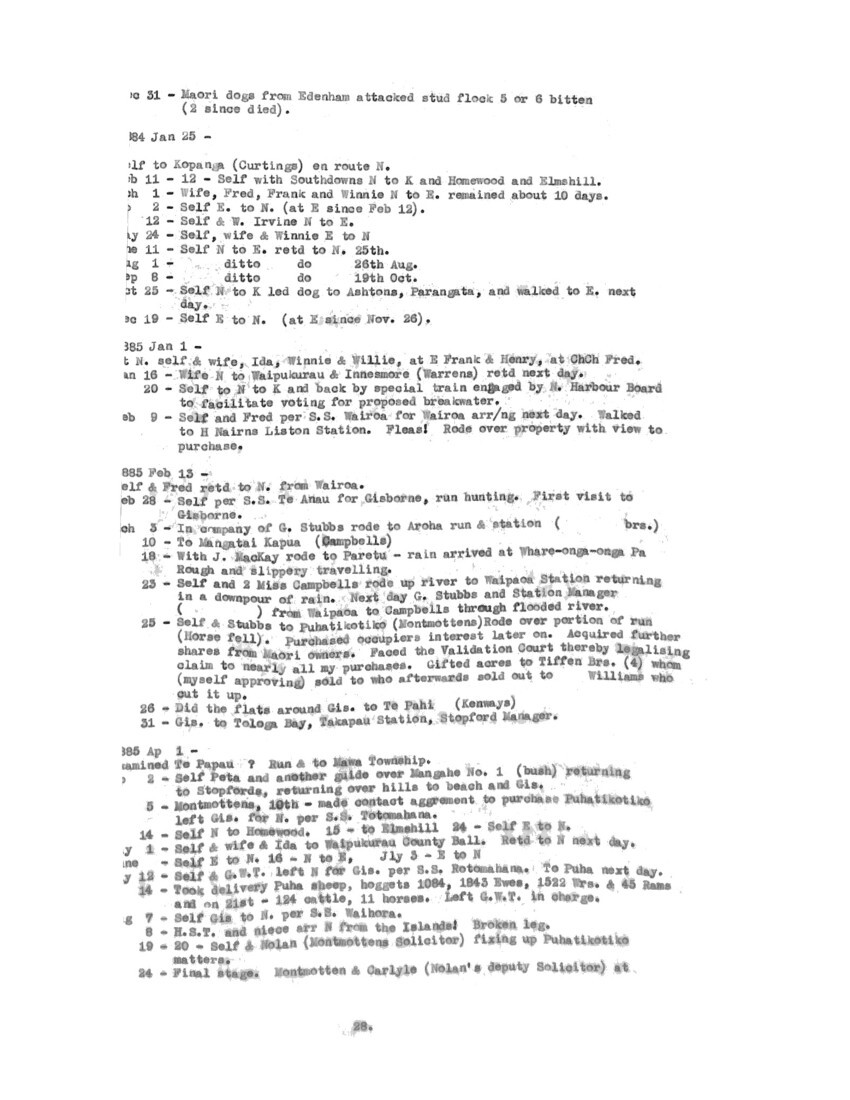
Page 29
Wilson & Cotterill, cheque, 215592.
Aug 29 – Self N to E. Sept 12 – E to N.
1885 Sep 27 –
Self per S.S. Wairarapa for Gis. returning on Oct 9, per S.S. Te Anau.
Oct 20 – Self N to E. docking retd to N. 30th.
Nov 9 Allen, Leslie Allan arr E (cadet).
16 – Self N to E shearing & dipping 2,600 2-tooth sheep for Poverty Bay, Retd to N Dec 12.
28 – 1081 2-tooth Wethers for Puhatikotiko P.B.
29 – Self & Ansell by rail N to Makatoku (Makotuku) accompanying fire engine to quench bush fire Returned next day.
1886 Jan 1 –
In N., Self & wife, Ida, Winnie, at E. Fred, Henry & Frank, at G. G.W.T.
Jan 3 – Big fire Waipawa,
28 – Self N. to Gis, per S.S, Taupo.
Feb 2 – Coach Gis. to Ormond, walk to Puha, returning to N, per Te Anau on 19th,
26 – Self N. to E. Wife & Ada for Waverley,
27 – Wife & Ada & G. Hunter, Waipukurau & Innesmore, and on 30 to E. G Hunter jun. remaining at Innesmore
Ap 8 – Self, Wife, Winnie & Miss Lookey E. to N.
14 – G. Hunter jun, arr N. from Innesmore (stayed with us until ).
May 21 – Self retd to N, Per Tarawera.
June 10 – Mighty volcanic eruption of Tarawera Mountain. Pink & White Terraces &c. at 2:15a.m.
Jly 9 – G.W.T. and Withered left N. for Gis. with dft. Horses.
Sep 30 – Self N to K Oct. 1 – K to E. for docking
Oct 23 – Self E to N. Nov. 3 – N to E 11 – E. to N. at E. since 1st.
Dec 1 – Self N to E. 22 – retd. to N.
11 – Big fire N. About 23 houses destroyed.
22 – Self E to N. as above.
1887 Jan 1 –
In Napier, Self, wife & Winnie, at E. Fred, Henry & Frank, at Gis, G.W.T. at M.E.T., in Dunedin J.E.T.
Jan 4 – Self N to E. lamb shearing.
15 – Self & Fred E. to N.
25 – Foundation stone laid of N. Breakwater.
Feb 16 – Self N. to E. 22 – Wife & Winnie N. to E.
Mch 2 – J.N. Williams leases River pad. to 30 Sep.
11 – Self, wife & Winnie & Fred E. to N.
19 – Self N. to Gis. per S.S. Waihora.
27 – Retd. to N.
Ap 1 – Self N. to E. 30th retd.
1887 May 11 –
Ship Northumberland wrecked N. S.S. Boo jum foundered.
17 – Self N. to E.
18 – S.S. Sir Donald wrecked.
26 – Self, H.E.T & F.A.T., E. to N.
June 23 – Accepted 10/- in the £ from W. Bennick Harding. Receiving £15.
Sep 11 – Self N. to Gis. per S.S. Mararoa 18th retd.
27 – Self N. to E. docking Retd N. Oct 15.
Nov 9 – Self & F.A.T, E to N.
12 – H.S.T. and niece & Mabel D. for Dunedin per Rotomahana to meet Hetty D. who did not arr from England.
22 – Self N. to K. walk to E. for shearing.
Dec 10 – Self retd. to N. from E.
1888 Jan 1 –
In Napier, self, wife Ida & Winnie, at Elmshill Fred & Frank, at Gis.
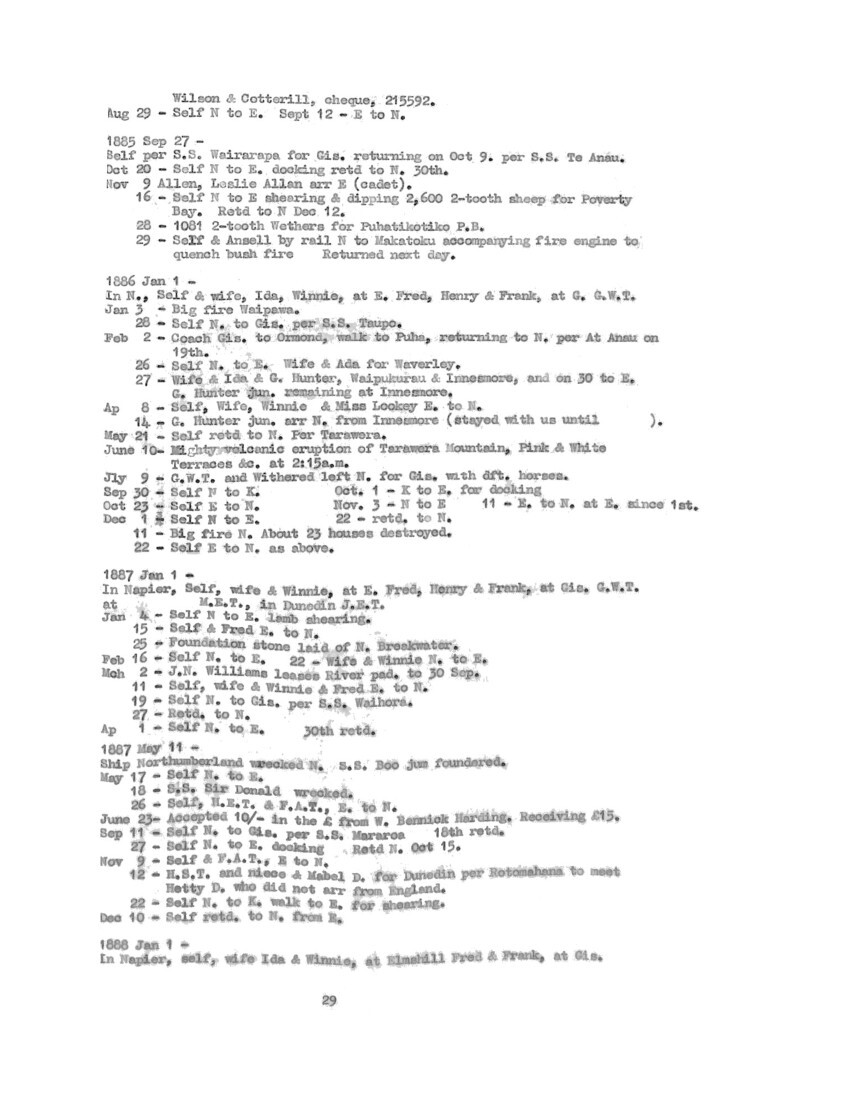
Page 30
Willie and Henry at Taradale M.E Tuke
Jan 3 – Self N. to E. 27th – Retd to N.
Feb 15 – Ida and Winnie N. to E.
Mar 1 – Self N. to E. to deliver sheep.
7 – Self and J.S. Buchanan E. to K. Self K. to Hastings by train and to N. by trap to arrange about Miss Looke’s funeral.
Apr 4 – On Grand Jury – a farce.
14 – Self N. to Gis. per S.S. Mararoa 28th – Retd per S.S. Waihora
May 2 – Self N. to Gis. June 7 – Retd. to N.
Jul 4 – Self N. to E. 28th – Retd.
Aug 18 – H.S.T. and niece and Mabel Dunk arr N. per S.S. Wairarapa from Sydney.
Sep 7 – Self N. to Gis. per S.S. Australasia.
21 – Retd N. per S. S. Tarawera.
Oct 3 – Self N. to E. for voting O.R.B.
20 – Retd to N.
Nov 5 – Self N. to K. walk to E. via Tammins bridge.
Dec 8 – Self retd to N.
17 – Self Taradale and back, funeral M.M. Tuke.
1889 Jan 1 –
In N. self, wife and Winnie, at Elmshill, Willie Ida Fred Frank and W.M. Berkley in Gis Ida and Henry.
Jan 2 – Self N. to E. Lamb shearing Retd on
Feb 11 – Self N. to E. Fred 2 – Retd to N.
12 – Wife, L.W.T. I.E.T. and servant N. to E.
23 – H.S.T. and Niece and Mrs. De Lisle left N. for England via Auckland
Mar 16 – Wife and Ida E. to Kaikora, Buchanans buggy, rail to N.
30 – Self E. to N.
May 25 – Self, wife and Winnie left N. to Halcombe returned on 28th
Aug 25 – Self N. to Gis. per S.S. Waihora.
Sep 7 – Retd per S.S. Mararoa. Also Ida from Wlgton per S.S. Wairarapa.
Oct 8 – Self N. to E. 26th Retd. to N.
Nov 13 – ditto shd Dec 11 – Retd.
1890 Jan 1 –
At Napier, self wife & Winnie, at Gis. G.W.T., at Elmshill F.A.T. & H.E.T.
Jan 2 – Serg. G.W.T. ar N. from Gis. enroute Dunedin Rifle Competition
Retd. to Gis. 25
10 – Elmshill homestead destroyed by fire, occupants, self, H.E.T.,F.L.T. & W.E. Grieves.
13 – Sergt. G.W.T. won 2 prizes firing Competition Dunedin.
15 – W.E. Grieves after lengthy res. at Elmshill left (at E. 17th Oct/88)
17 – Self E. to N. Purch stud sheep Wetwood. [Westwood?]
29 – Retd. to E. in town since 17
Feb 2 – H.E.T. & F.A.T. from E. to Hastings with Southdown Rams per rail
22 – Self N. to E. 28 – H.E.T. Elmshill to N.
Mar 16 – H.S.T. & niece returned from Wellington (away a week)
Apr 1 – Self N. to E.
16 – New house E. finished (2 months building)
Jun 13 – Self E. to Tomoana and N.
29 – Self and wife and Ida and Winnie left N. for Melbourne and Sydney per Ronowai. (Monowai?)
1890 July 4 –
Left Bluff 8th arr Melbourne
July 24 – Melb. to Seymour en route Sydney.
26 – Arr Sydney after an all night journey in train, strike on.
Sep 2 – Katoomba one week.
30 – Arr Auckland (Strike on) per S.S. Wairarapa
Oct 3 – Arr Gisborne 4th Napier.
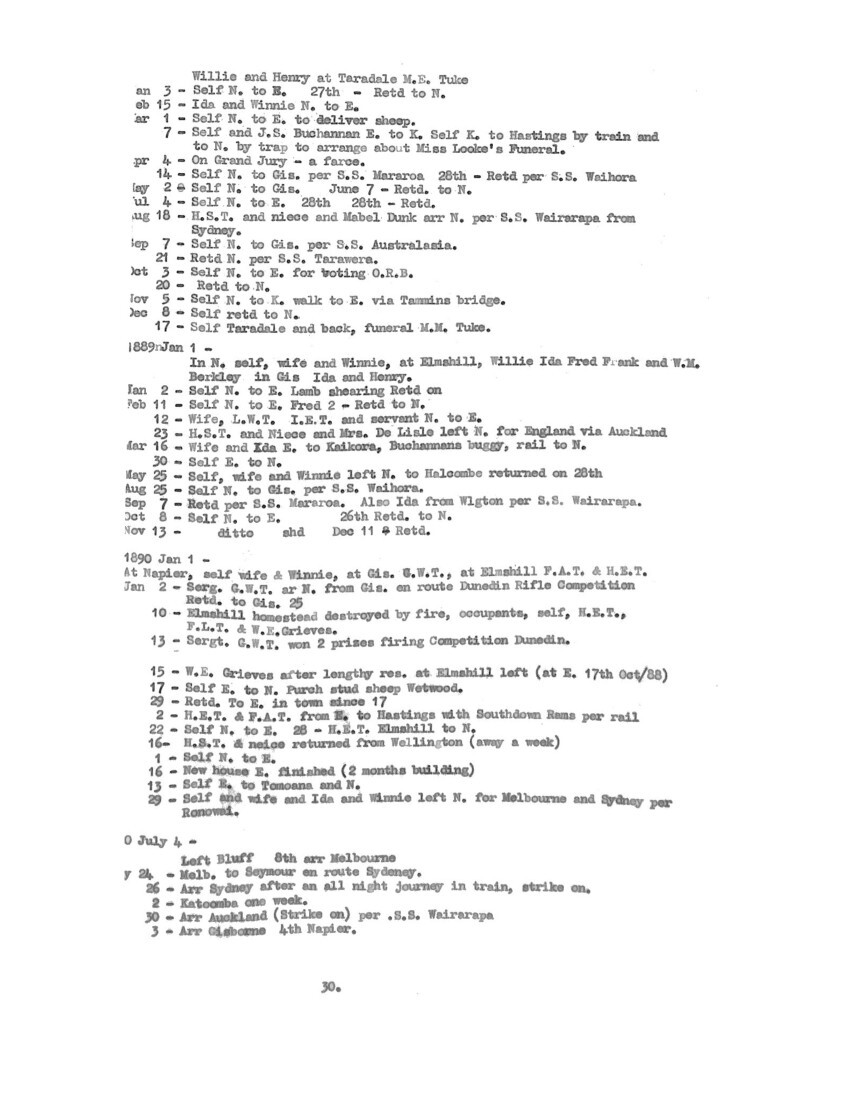
Page 31
Oct 13 – Self F.A.T. & H.E.T. N. to Elmshill
25 – H.E.T. off
Nov 8 – Self E. to N. 16 – G.W.T. at N. fr Gis.
24 – Self N. to E.
Dec 20 – Self E. to N.
1891 Jan 14 –
Self N. to K. walked to E. leading 2 dogs for rabbiting.
Feb 5 – Self E. to K. by buggy train to N.
Mar 1 – H.S.T. & niece arr N. from Wellington.
3 – Self N. to E. 28 – retd to N.
Apr 6 – Self N. to E. May 30 – retd to N.
Jun 6 – G.W.T. & W.D.L. Gis to N. on Mangatu 2 purchasing scheme
8 – Ida and Mrs. Carlyle en route Auckland.
15 – Self and G.W.T. interview De Lautour re Coopers offer to purchase Mangatu 2 shares.
20 – Self Gis to N.
30 – G.W.T. quit Puha for his Mangatu 2 block & acres.
Management Puha taken over by H.E.T.
1891 July 8 –
Self N. to E. 25 – retd to N.
Aug 21 – W.D.L. Gis to N. area Mangatu 2 purchased to date 1757
Sep 3 – Self N. to E. 23 – retd to N.
Nov 26 – do Dec 24 – do
(Oct 17 – Mrs C Chapman (Lizzie) obit
19 – interred unknown to me at time)
1892 Jan 1 –
At N. self, Ida Winnie, Frank, F.A.T. in Elmshill G.W.T. & H.E.T. Gis
Jan 21 – Self & G.W.T. N. to Gis S.S. Southern Cross anchored Young Nicks Head 22nd 23.
Feb 2 – Self rode Puha Gis ret
5 – Self & H.E.T. started on journey to N. leaving The Lawn (by Puha) after dinner arr Wairanga Kuri [Waerenga-o-kuri] – pub – rain and thunder
6 – Started 4;30 arr Wairoa 4 p.m. six hours rain and high wind 54 miles
7 – Sunday left Wairoa 5 a.m. arr N. 9 p.m. 75 miles.
19 – G.W.T. firing competition Omaranui Npr.
Mar 19 – do Wellington (Rifle Association
Apr 1 – Self N. to E. 15 retd N.
May do 14 ret N.
1892 Aug 15 –
Self N. to K. by rail walk to St Lawrence, and next day to E.
Sep 10 – Self E. to N. 12 – J. Buchanan died Elsthorpe.
13 – N. to K. rail, walk to E. Oct 1 – Self E. to N. 11th – self N. To E. retd. 29th
Nov 6 – Self N. to Gis per S.S. Manapouri 20 – Retd to N.S.S. Wairarapa
24 – Self Craig & Wilson N. to E.
1893 Jan 1 –
Locality of members of family. At Clive Square N. self, wife & Winnie at Taradale M.E.T. & I.E.T. at Gis H.E.T. & wife at Elmshill F.A.T. F.L.T.
Jan 7 – Self N to E. Retd – Feb 2.
Mar 1 – L E T. & L.W.T. S.S. Wairarapa for Gis
22 – Self N to Gis. Validation Court re Puhakohiko [Puhatikotiko?] purchases.
Apr 8 – L.E.T. & L.W.T. Gis for N per S..S.
May 6 – Self from Gis for N.
13 – Self & wife Winnie Godfrey & Lat Tuke N to E. Retd – 23rd
Jun 20 – Self N to K Waipawa, Elmshill Sept 7 – Self N to E retd 3-
Oct 12 – Self N. to E retd 25th via Longlands
1894 Jan 1 –
At Clive Square N. self, wife & L.W.T. at Gis Ida E. Lysanar, G.W.T. F.A.T. H.E.T.
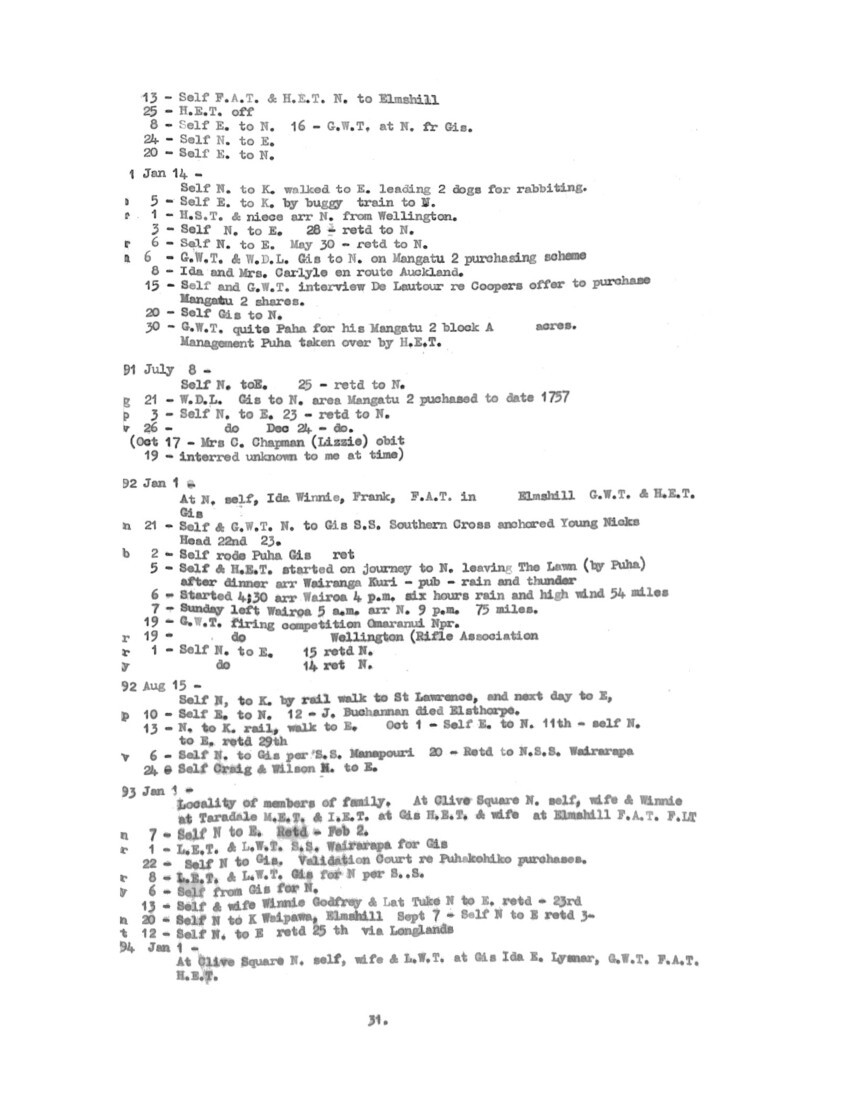
Page 32
Jan 2 – Removing from Clive Square to Clyde Road. Clive Sq sold to Dr Reed.
29 – Self N to E retd 5 Feb to N.
Feb 7 – Self wife and L.W.T. per S.S. Te Anau for Gis.
22 – Self Gis for N. S.S. Australia. 27 Self N to E dipping
25 – G.W.T. from Wellington prize firing March 6 – Self Gis to N.
Apr 9 – M.E. Tuke arr N from Waipukurau on trip Southward
11 – Self N to E 12 – wife, L.W.T. F.L.T. & M.E. Tuke arr Lyttelton [Lyttelton] S.S. Mararoa Retd to N. per S.S. Wairarapa on 29th
May 5 – Self (Buchanan’s gig) E to K to N injured back
19 – Self N for Gis S.S. Tatune – Whare building Mangatu
June 15 – From Gis to N. S.S. Australia
Oct 2 – Self N to E 26 – E to K Buchanan’s gig (Recd hurt at E)
28 – S.S. Wairarapa lost Barrier Isld 140 to 150 lost 80 saved C Chapman
Nov 26 – Self N to E Dec 8 – Mangatu Woolshed finished
Dec 9 – Self N.for Gis. S.S. Waihora 29 – First load of Wool for Gis from Mangatu.
1895 Jan 1-
At N. Clyde Road, wife and L.W.T., at E. Frank, at Gis Ida, G.W.T., F.A.T., H.E.T. & Self.
Jan 3 – Self N. from Gis per S.S. Te Anau
Feb 12 – Self N. to E. dipping retd 25th
Mar 30 – Messrs Wilson & Shrimpton valuing Elmshill on behalf of Tollemache exors [executors?] S.A. Westerman as Cadet at E.
Apr 5 – Self N to Waipawa purch 44 cattle – to Waipukurau 6th N.
Jul 1 – Wife and L.W.T. N to Woodville to interview re painting lessons and board retd to N.
Sep 8 – Self to Gis S.S. Flora 23 retd
Oct 2 – Self and wife N. to E. LWT. to Woodville,
31 – ditto E to N Nov 7 – Self N to E shearing. 30 – Retd to N
1896 Jan 1 –
At Clyde Road N self, wife and L.W.T., at Elmshill G.W.T. & F.L.T., at Gis Ida, F.A.T. and H.E.T., Waipuk [Waipukurau] L.E.T.
Jan 6 – Self, wife and L.W.T. daylight trip to Gis per S.S. Waihora
Feb 12 – Self Gis to N per S.S. Anglican.
21 – H.S.T. obit Deed of Partnership executed, as from Jan 1 last, re Tiffen Brs.
Mar 9 – Self N to E dipping 24th – retd
Apr 2 – Self wife and L.W.T. left N on excursion to West Coast.
4 – Wanganui 10 – New Plymouth 15 – Patea. 20 – From Woodville to N.
28 – Self N to E June 6 – Retd.
May 3 – C.L. Tuke and wife per S.S. Waihora for Sydney. June 11 – Retd to N
Oct 6 – Self N to E 28 – retd 23- Puha homestead burned.
Year closed with destructive bush fires.
1897 Jan 1 –
At Clyde Road N, self, wife and L.W.T. at Gis Ida, Henry, Willie, Fred, at E Frank, at Waipukurau M.E.T.
Jan 11 – Self N to E 19th – retd
Feb 23 – do Mar – Retd.
Apr 19 – good Friday, heavy flood and loss of life at Watangi [Waitangi?] washout
Jul 16 – The Mysterious Lights, Clyde Road res an illusion.
Oct 5 – Self N to E docking Nov 5 – Retd.
Nov 15 – do shearing
Dec 7 – Wife & L.W.T N to E 21st – Retd, also self. 8 – sharp earthquake.
1898 Jan 1 –
As above except F.A.T. at Clyde Road res.
Feb 23 – Self N to E, dipping March 14 – Retd
Mar – (wife) L.E.T. & L.W.T. to Gis 17 – wife and L.W.T. retd to N
Apr 5 – Self and wife and L.W.T. From N. for Wellington by train arr Masterton.
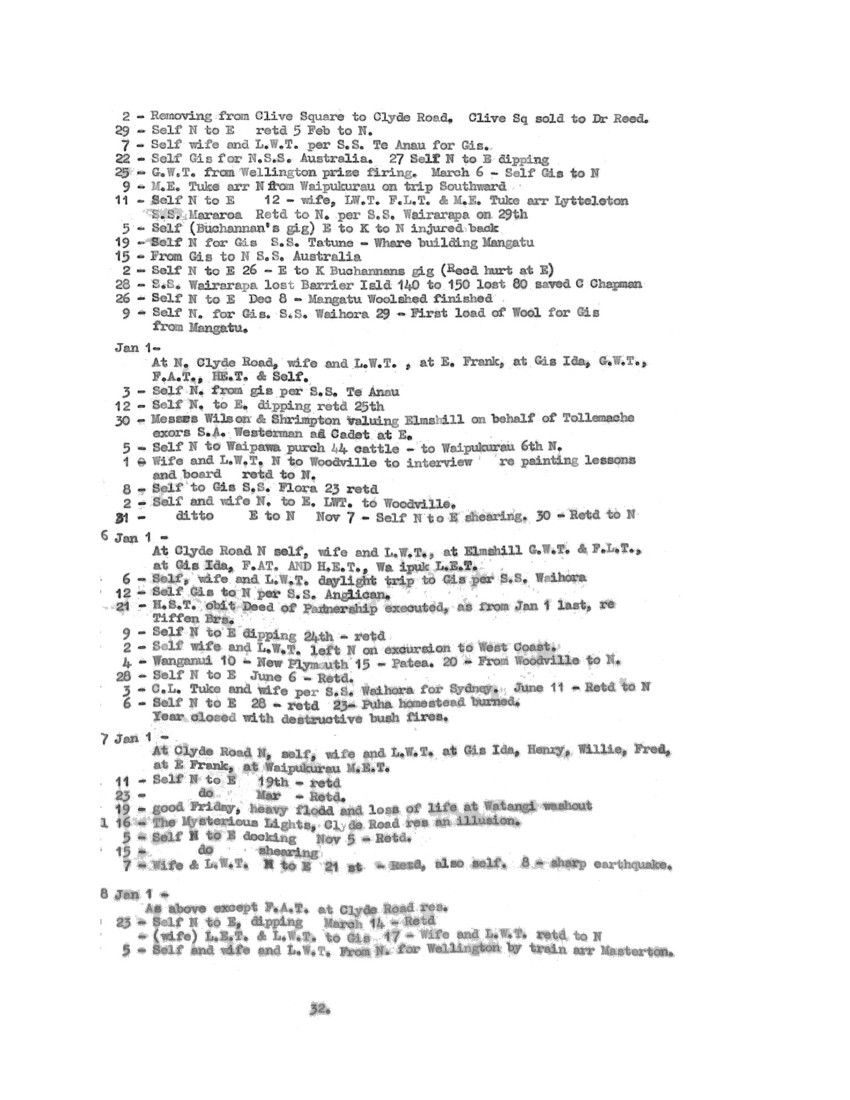
Page 33
Apr 6 – Wellington. 12 – Self Nelson. 14th – Parapara (Collingwood).
18 – Wakamarine.
26 – Wife and L.W.T. Wellington to N. self Marori G.M. Business samples.
27 – Self Upper Hutt. 28 – N. Oct 22 – Self N to E Nov 4 – Retd.
Dec 4 – Earthquake.
1899 Jan 1 –
At N Clyde Road, self, wife and L.W.T. (Clyde Road) at E F.L.T., at Puha F.A.T., at Mangatu H.E.T., at Waipuk M.E.T., at Gis I.E.L., Northward
G.W.T. on honeymoon.
Feb 5 – Self N to E 18th Retd. March 31 – F.A.T. on West coast excursion.
Apr 5 – Greenmeadows Auction, self securing 10 acres and homestead for £800
7 – Self, wife and L.W.T. N. to E 21st Retd
May 2 – ditto left for Auckland per S.S. Anau.
4 – Arr Auckland. 9th – Rotorua. 15 – F.L.T. arr Rotorua.
27 – Left by coach via Wanganui.
Jun 5 – Self, wife and L.W.T. left Rotorua for A.
17 – ditto Auckland per S.S. Te Anua [Anau?] for Gis.
29 – Arr N per S.S. Elingamite.
Aug 22 – G.W.T. and wife N to E. Erected skylight to woolshed.
31 – G.W.T. Ashurst to Wellington en route N.S.W. to introduce Wades patent Skylight for which he held Australiansian [Australasian] patent.
Sep 22 – Self and F.L.T. N to E 26th – Self retd N
Oct 23 – Self N to Kaikora, walk to E shearing.
26 – Accident to Maori lad’s finger wool pressing.
27 – Bitter weather. Losses shorn sheep Elmshill 300 shlgs. Edenham 1,500 (400 of which drowned) Te Aute 750 Lowry 700 Te Apiti 400 Pourere 500.
Nov 10 – Self E to N Dec – G.W.T. wife, child, and sister-in-law arrived from N.S.W.
Dec 25 – G.W.T. N to Gis on Partnership business.
1900 –
1901 Jan 1 –
In Napier, Clyde Road, self, wife and L.W.T., also M.C. Tuke and Family, at Gis G.W.T., H.E.T. I.E.T., at Elmshill F.A.T. & F.L.T.
Jan 2 – 1849 -left Wairarapa for Pourere with 3,000 sheep arriving on )
Jan 6 – G.W.T. & H.E.T. arr N from Gis.
Jan 7 – ditto N to K en route Elmshill on subdiv and partnership business.
10 – G.W.T. E to Ashurst H.E.T. E to N 11- H.E.T. and F.A.T. N for Gis
23 – News of death of Queen Victoria yesterday.
30 – 1849 arr at Pourere with 3000 sheep from Te Ahiaruhi Wairarapa having left there Jan 2.
Feb 6 -framework house sec 363 Station St. N erected – work then stops some time.
7 – Self and F.A.T. N to E, dipping. 8th – F.A.T. N for Gis
15 – Self E to H. 14 – Saw Imperial Troops.
6[?] Feb 21 – H.S.T. obit – 22nd Indian troops N
May 7 – Self N to E. Election O.R. Board.
15 – Self N to Hastings return. Voting Mayoralty.
Jul 12 – Removed from Clyde Road to new house Station St. N.
17 – Earthquake. Aug 12 Earthquake, Oct 23 – do.
Oct 24 – Self N to E 29 – Self Walk E to K, rail N
30 – Elmshill Woolpress disabled. 31 – Self N. to E.
Nov 1 – Self walk E to K rail to N. Wool at 4d per lb in London Colonial Sale.
1902 Jan 1 –
At Station St. N., self, wife and L.W.T., at St. Augustine’s N. M.E.T., at E. F.L.T, & Lat Tuke, at Gis E.I.L., G.W.T., F.A.T. & F.L.T.
Mar 28 – Godfrey & Lat Tuke, N.to E. 31st – Retd.

Page 34
17 – Earthquake. 22 – Wife & L.W.T. arr N from Gis per Waukare (Waikare?) (at Gis a fortnight)
9 – Earthquake. Sept 25 – G.W.T. wife and 2 children Gis to N.
26 – To Wellington and Dunedin,
13 – Self N to E 20 – Retd to N,
15 – Self N to Waipukurau to consult Dr Godrey [Godfrey?]re Cataract in eye. Discovered there was one in each eye.
1903 Jan 1 –
At N. self and wife and L.W.T., at St Augustine’s M.E.T. and family, at Gis Ida, G.M.T. F.A.T. and H.E.T., at Elmshill F.L.T.
29 – Rain fair Hastings.
5 – Self, wife and L.W.T. N to Dannevirke en route Wellington. First annual trip “Trocadero”.
7 – Terrace, Mrs. Peters!
27 – Self, wife and Winnie, Wellington via Manawatu line to Palmerston. — to N.
28 – Self and F.L.T. to Wellington,
29 – Selected sections 21 to 23 Ev Bay and Mm Est Co for L.E.T.
31 – We 2 Wellington to Featherston, bitterly cold S.E. (results self Pneumonia, Bronchitis and Pleurisy, six weeks illness from 8th Inst)
2 – Earthquake another on Dec 8.
[Aug?] 7 – First day of above illness 8 – Frank L.T. ar from Elm.
10 – F.A.T arr from Gis. 12th – Temperature 103.
13 – W.D.L., Ida & G.W.T. arr from Gis
22 – W.D.L. & Ida retd to Gis.
1903 Aug 27 –
Frank L.T. Retd to Elmshill. In town since 8th.
9 – G.W.T. & H.E.T. Retd to Gis In town since Aug 13 on my illness.
15 – F.A.T. retd Gis. In town since 10 Aug.
19 – My first walk up town.
3 – Visit from Mabel Haselden en route Auckland. 8 – Earthquake tremor.
24 – W.D. Lysnar, wife child and nurse from Gis.
1904 Jan 29 –
Self, wife and Winifred N to Wellington (Trocadero)
1 – Lodgings Mrs. Peters, Wellington Terrace.
14 – Heavy shower just in time to save water famine on Terrace properties
29 – We 3 returned to Napier after 4½ weeks visit.
9 – Self and wife and L.W.T. Napier. to Elmshill.
22 – Retd to N.
30 – W.D. Lysnar and wife from Gis enroute Wellington.
1 – per rail to Wellington. Returned on 4.
12 – Rev C.G. Tuke & wife to Wellington en route South. Retd 27.
[May] – 1 122 Ducks shot on lake. July-Aug – Several slight earthquakes
[Aug] 8 – W.D. Lysnar and wife en route W on H.E.T. business. Retd 12th
13 – G.W.T. arr N from Gis Nov 3 – E.I.L. arr from Gis.
1905 Jan 26 –
F.A.T. arr N from Gis wee Aug 23/06
21 – Self, wife and Winnie N to Wellington (Occidental) Hotel, McKinnon to occupy house Station Street.
28 – Left Occidental, wife and L.W.T. to Mrs Peters, self to Nurse Palmer’s
Private Hospital for removal of cataract from left eye by Dr. M. Kendall next day.
4 – Left Nurse Palmer’s Hospital for Mrs Peter’s boradge [boarding?] house, 138 The Terrace, W.D.L. from Gis in to Mrs Peter’s.
6 – We 3 removed to Bennet’s house, 29 Woolcombe St.
10 – W.D.L. and Ida W. to Wanganui.
27 – M.E. Tuke, self and wife Eleanor and Mavis per ferry boat W, to Seatoun.
[May?] 1 – 100 wild ducks shot on my lake Elmshill.
4 – H.E.T. arr Wellington from Gis.
5 – M.E. Tuke, Eleanor and Mavis W. for Napier.
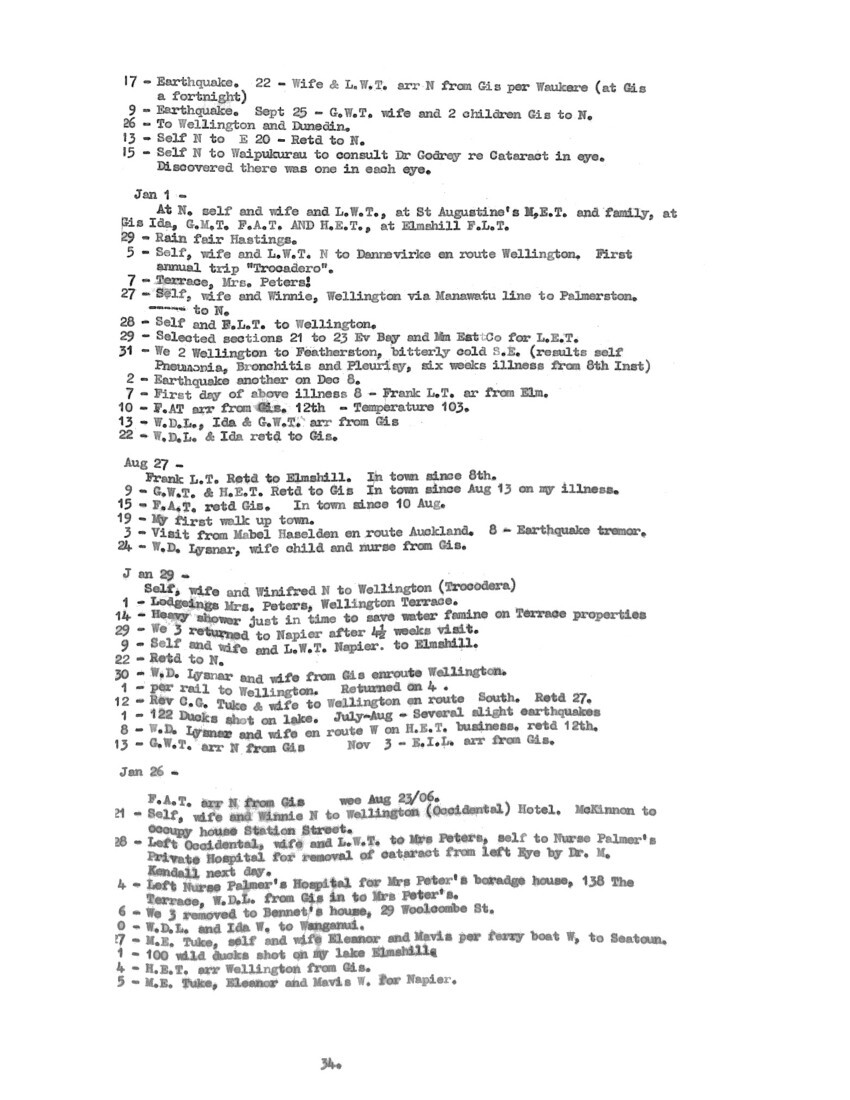
Page 35
11 – Frank L.T. arr from Elmshill at Woolcombe St.
12 – H.E.T. retd Gis.
18 – Lucy Tuke arr Wellington from Dunedin and proceeded by Steamer.
31 – Self and wife, Frank and Winnie from 29 Woolcombe St W. for Napier.
In Wellington from 21 Feb
– Several Earthquakes.
7 – W.D.L. wife, child and Nurse girl arr N. from Gis.
15 – Frank E.T. sold his Tikihore(?) property 2116A Lr 20p. to Henry E.T. at £5 per acre, also 568 acre leasehold thrown in, stock at Valuation.
18 – M.E. Tuke with Lucy arrived Wellington. 20th– Lucy E. Tuke to Lyttleton.
21 – M.E.T. retd to N. from Wellington.
2 – W.D.L. and Ida arr N. from Gis W.L.D. to Wellington, 6th – retd to Gis.
6 – W.D.L. and wife arr N. from Gis en route South 18 – Retd to Gis.
9 – Self, wife and L.W.T. N. to Wellington. No. 4 Kensington St. Mrs Douglas’ Boarding house.
20 – Voted for extension of tram line to Miramar. Result of Poll 360 for 47 against.
26 – We 3 removed from Mrs. Douglas for Napier,
27 – Interviewed Coleman and Humphries, also G [C].B. Hoadley re Sub-Dividing and selling part Elmshill.
1906 January 8 –
From N. for Elmshill, G. Rochfort and his 2 survey men to Patangata and Breakneck Hill and Co., self continued walk to Elmshill.
10 With G. Rochfort on survey matters ib(?) Terawin and other parts.
11 – C.J.A. Haselden, wife and daughter arr N. from Auckland en route Wellington
26 – Auction of part Elmshill 2,407 acres advertised in 6 lots. Lot 2 abt 572 acres sold to J. McNeill. Lot 6 300 acres sold to R Ward. Both Lots £9 per acre Headley and Co. Auctioneers. Private Sale by self of portion Lot 18 to A. Sinclair about 13 ac at £7. This step taken on report that the Govt intended “taking” the property.
1906 Jan 30 –
Frank E.T. Elmshill to N. and Gis. to give over Tikihore (?) to H.E.T.
2 – C.L. Tuke retd to N. from Waikaremoana trip.
15 – Interviewed J McNeill re lot 4 acres 1 or 1. agreed to lease as from this or next year at 9/- per acre with option to purchase at £9.
22 – W.D.L. arr N. from Gis. Submitted proposals for sale of Elmshill to F.L.T.
24 – Frank L.T. arr N. from Elmshill.
26 – Self, wife and L.W.T. N. to Wellington 36 The Terrace.
17 – Removed from 36 (Mrs. Peters) to Mrs Douglas. Kensington St.
16 – Jessie Tiffen and son, Jack, called en route Dunedin. Retd on 27.
[May]? 1 – 125 Wild ducks shot Elmshill
11 – Hoadley & Son notify sale Lot 3, 124 acres to Sinclair and Cordell at £14.10.0 per acre.
21 – W.D.L. and wife arr N., S.S. Victoria, en route Wellington
22 – do by rail. Retd July 11.
20 – Telegram from W.D.L. land slip occurred at Te Rata, F.A.T.’s house swept away. Parties removed to Arowhana. Mrs Merrit’s injuries severe (Amputation of leg followed later on.)
23 – F.A.T. Arr from Gis. after his almost fatal washout. Retd Sept 11.
1 – W.D.L. and wife arr N en route Wellington and Dunedin. 2nd train to W.
1906 Oct 8 –
Telephone from Edenham – Men’s Whare Elmshill burned down.
24 – G. Rochfort (with Godfrey Tuke) fixing pegs adjusting give-and-take old fence line between Tiffen, Buchanan’s and returning 30 acres to Elmshill.
5 – Self Kaikora, Elmshill re Wool delayed in cartage. 7th – 3 drays of Ward’s removed, wool just in time for S.S. Cornwall.
21 – We 3 to Wellington, Mrs Peters.
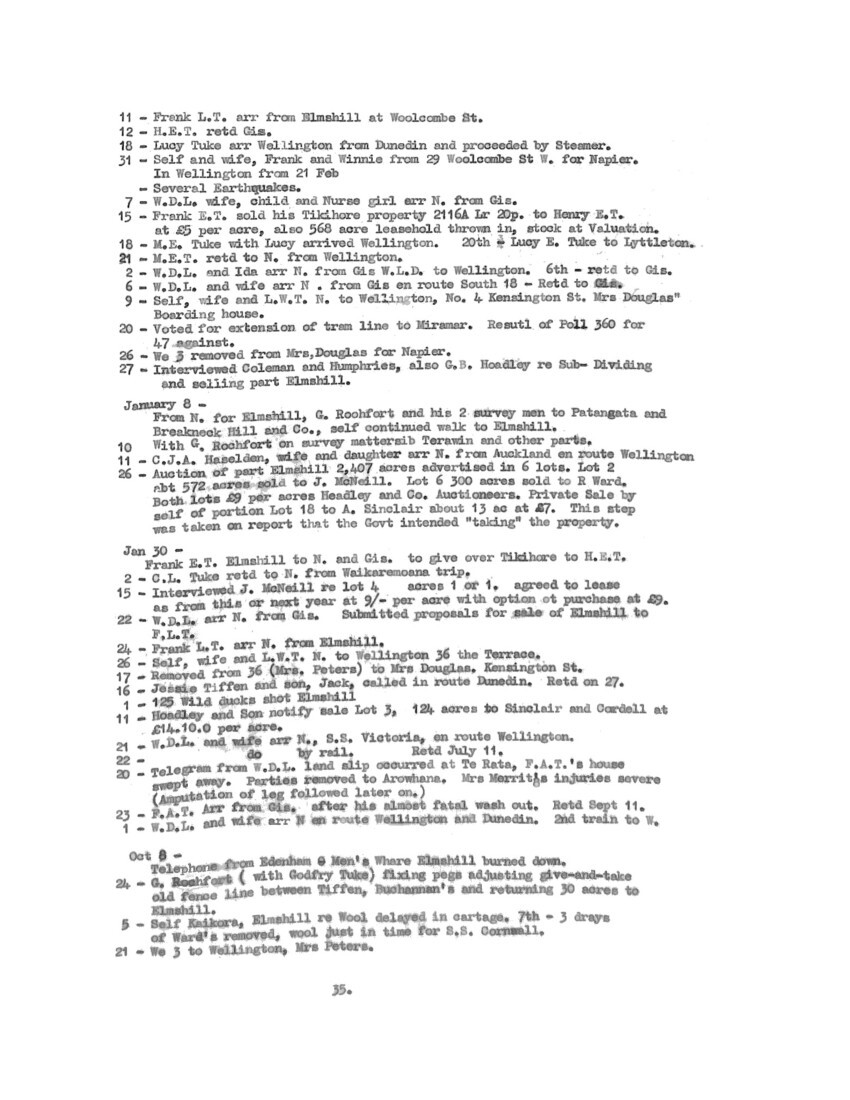
Page 36
1907 Jan 1 –
Whereabouts of members of family. F.J.T., Lucy E.T., L.W.T, Wellington Mary E. Tuke, Napier. I.E. Lysnar, F.A.T., H.E.T., Gis Frank L.T. Elmshill.
Godfrey Tuke aboard Cornwall nearing England.
[Jan] 9 – Purchd of A. Warburton for Lucy E Tiffen (gift) pt sec 1, 464 [46] Wellington Terrace
16 – Latimer Tuke arr Wellington en route England to join his uncle in Virginia (S.S. Suevie wrecked on Lizard 17 March all hands saved)
18 – We 3 Wellington to Napier to pack up. S.S. Cornwall with Godfrey Tuke, supernumary [supernumerary] Engineer, arr London.
4 – Self, express to Kaikora N. thence Elsthorpe and Elmshill by motor (F.L.T.)
6 – Motor to Patangata 20 minutes, Te Kaiku 20 minutes. Train to Napier Total 3½ hours.
1907 March 11 –
F.A.T. arr N. per Tahune (Tahuna?) from Gisborne,
15 – Self, wife and Winnie, Napier to Wellington,
18 – H.E.T. wife and Montie arr Wellington from N per rail, steamer from Gis
19 – The 3 left Wellington per Rotomahana for Lyttleton en route Christchurch Exhibition.
22 – F.A.T. ar Wellington from N per rail. We 3 removed from Mrs Peters to their home No 46 the Ter (later No. 106)
28 – W.D.L., wife and child ar Wellington from New Plymouth.
30 – We 3 and ditto to Miramar and back by Electric tram
[Apr] 3 – W.D.L. wife, and child left W per S.S. for N and Gis,
4 – H.E.T., and wife and Montie ar Wellington from Christchurch Exhibition,
8 – left W for Gis on route Longburn.
9 – Lucy Tuke ar W en route Christchurch,
10 – Frank L.T. Wellington to Kaikora and Elmshill (9th or 10th)
18 – F.A.T. arr Wellington from Christchurch Exhibition
[May] 1 – Wild ducks shot F.L.T. 38, Williams and Wolsman 23, 1906, 125, 1905. 100, 1904, 122, 1903,
2 – Lucy Tuke arr Wellington from Christchurch.
3 – First night’s res in No 46 Wellington Ter (now 1908 No. 106)
11 – F.A.T. arr Wellington from Napier.
18 – Sold to F.A.T., Wellington 78, 15, 14, 15 Vautier St. Pt Sec 367 also sub sections 3, 4, and 5 Station St sec 363.
31 – Self and F.A.T. rail Wellington to Waikanae, visiting Henry Burling aged only 107. Last seen by me was at Patumokai (Featherston) in 1848 Wairarapa, or 1849. (H.B. born at Stratford, England. May 1 1801)
[Jun 5] – Frank’s wedding Day.
7 – Official opening of trams to Miramar.
12 – D(r). Pollen’s first visit to Lucy E.T. suddenly ill with paralasis. Obtained Nurse A.M. Gordon.
[Jul] 11 – W.D.L. arr Wellington from N and Gis. Consultation Drs. Pollen Batchelor and Henley.
13 – Mary E. Tuke by rail to N In Wellington since 15th ult.
18 – W.D.L. and wife arr Wellington from Gis on Harbour Bd business
Frank E.T. and wife arr W by rail.
22 – F.A.T. arr Napier from Gis.
[Aug] 3 – Henry E.T. and Frank L.T. from Wellington to Waipukurau by rail. Motor to Elmshill.
5 – W.D.L. and wife per S.S. for Napier and Gis. F.A.T. arr N for Gis. O.C.L. Tuke and Aubrey N to Wellington (retd 14th)
9 – G.A.T. Npr to Wellington
19 – W.D.L. and wife arrived Wellington from Gis on Harbour Board business.
[Oct] 5 – W.D.L. wife, child and Nelly arrived Wellington per S.S. Mokoia from Gis.
[Nov] 14 – F.A.T. arr Wellington from Lyttleton.
18 – W.D.L. and wife arr W from Gis re Harbour Board business. This entry uncertain.
19 – Rev C.L. Tuke arr Wellington from N on Conference business.
20 – Ida E.L. & us 3 Drive Island Bay.
[Dec] 13 – F.A.T. Wellington to Napier.
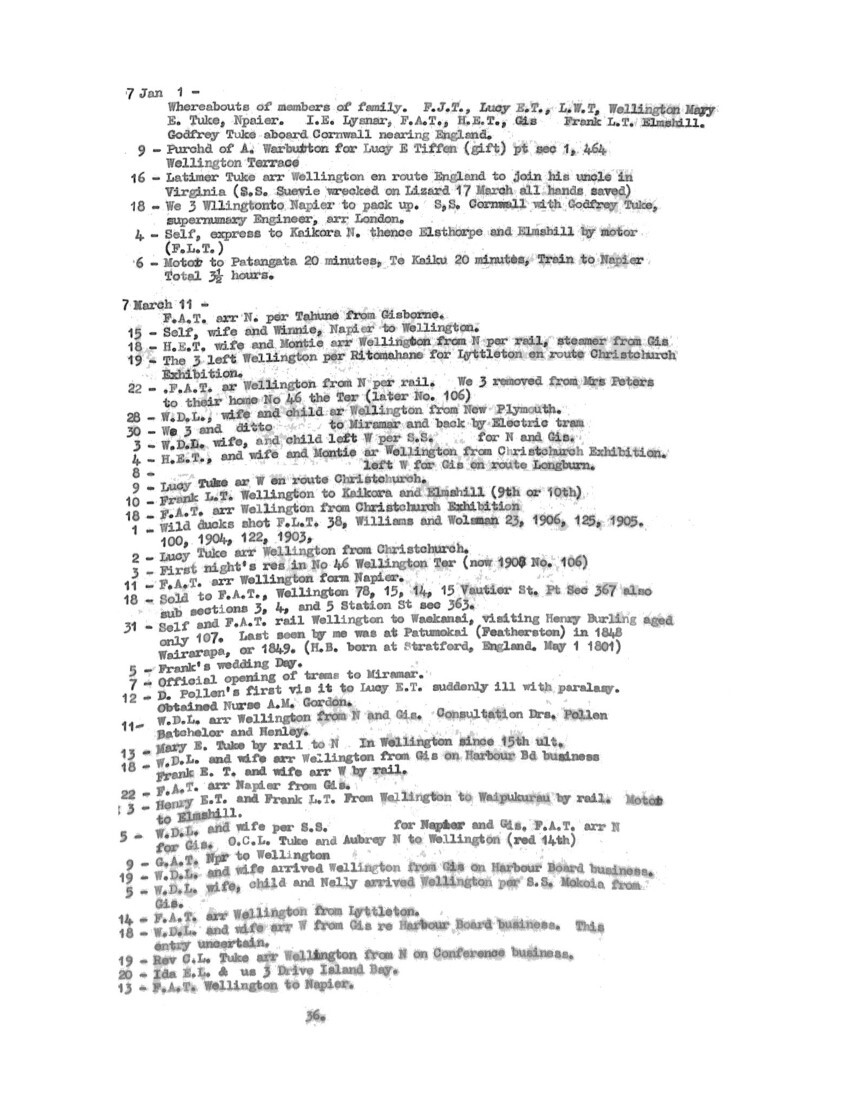
Page 37
25 – F.A.T. arr Wellington from N.
1908 – Jan 1 –
Self Wife and Winnie, Wellington, F.A.T., Ida, E.L., H.E.T. Gis Frank L.T. Elmshill, M.E. Tuke N. going Taupo to-morrow,
[Jan] 2 – C.L.T., wife and 3 children Tarawera en route Taupo.
3 – F.A.T. Wellington to Napier.
[Feb] 3 – W.D.L. and wife, arr Wellington (retd 7th)
14 – ditto do Mar – 4 – left Wellington per S.S. Monowai (Retd by New Plymouth)/ Nurse Gordon arr Wellington Ter to accompany us 3 Auckland and Rotorua today.
[Mar] 9 – F.A.T. Gis to Napier. Us 3 and Nurse Gordon per S.S. Monowai left
Wellington for Auck. arriving on 12th.
13 – Us 3 left Auckland arr Rotorua.
[Apr] 1 – ditto arr Newmarket Rly Station,
4 – ditto per S.S. Waikari for Napier arr there 4th.
5 – Took up residence Clyde Road.
11 – Louisa W.T. Napier to Wellington.
15 – W.D.L. and wife arr N en route Gis.
20 – H.E.T. and wife ar N en route Waipawa.
29 – F.A.T. N to Gis. Mayoralty elcetion [election] Gis W.D.L. 1136 Dr. Williams 808 following day. Wild ducks shot – 24.
1908 May 4 – Sale Miramar tramway Junction.
5 – Frank L.T. and wife Elmshill to N Retd on 7th
8 – W.D.L., wife and F.A.T. arr N from Gis. per S.S, Wimera.
16 – F.A.T.left N for W.
[Jun] 15 – Self by rail N to Kaikora, motor to Elmshill, retd to N same mode.
23 – Aubrey Tuke visits Gis.
[Jul] 3 – G.W.T. and wife arr N from South
30 – W.D.L. and wife arr N from Gis en route Wellington next day, on Conference of Mayors to be held Auckland and invitation to meet American fleet there.
[Aug] 17 – F.L.T. Visits N ret next day.
20 – Smart shock earthquake.
21 – Mrs. F.L.T. of son at Elmshill
[Sep] 3 – F.L.T. visits N on subject new shearers terms. Decided not to shear lambs
10 – W.D.L. wife and child arr N from Gis en route Wellington.
16 – Do retd to N. returning 18th to Gis,
18 – Mary Monteith Tiffen retd to Gis after having spent her holidays in Napier with her governess.
30 – Nurse A.M. Gordon Napier to Wellington, Nursing since March 24th at Rotorua and Napier.
[Dec] 9 – Frank L.T., wife and child visits N from Elmshill since 4th.
10 – F.A.T. from N to W by rail
12 – We 3 and Mrs Perry from Clyde Road res to Wellington.
1909 Jan 1 –
Whereabouts of family and Co. Self, wife Louisa W.T. & F.A.T. Wellington (106 Terr) Mary C, Tuke, husband & family N. Ida E. Lysnar, husband and child Gis. G.W.T. wife and family, Whaturau, H.E.T., wife and family, Whaturau. H.E.T., wife and Family Tawhiti Gis Frank, wife and infant Elmshill
[Jan] 4 – F.A.T. left Wellington for Gis. Nurse Gordon and we 3 by tram to Oriental Bay return. Left for Auckland.
8 – F.A.T. Married in Napier by Registrar.
14 – W.D.L. wife and child, arr Wellington from Gis. Retd by boat 19th
[Feb] 22 ditto do
22 – I.E. Lysnar, Wellington for Gis.
27 – W.D.L. ditto (Supreme Court case favour W.D.L.)
8 – F.A.T. and wife arr W from Napier and Gisborne.
[Apr] 14 – F.A.T. and bride’s visit to us in Wellington.

Page 38
26 – G.W.T. wife and 5 children arr Wellington en route Dunedin on proposed 6 months visit.
30 – Nurse Gordon returned to us intending to remain 2 or 3 weeks. (remained 6 months)
[May] 14 – F.A.T. re-married by Canon C.L. Tuke at N. (By Registrar N. Jan 8)
16 – Louisa W.T. express to N to prepare for return
17 – Lucy E.T. affected – tumbled out of bed 3 a.m. end attack paralysis
1st do on 17 Ap/07
18 – Louisa W.T. retd to N.
23 – Lucy E Tuke N to W en route Lyttleton
20 – T.N. Brodrick occupies Clyde Road residence.
[Jun] 7 – H.E.T. and wife arr Wellington from Gis Retd 11.
10 – Lucy Tuke arr W from Chch en route Napier.
16 – Aubrey Tuke and his cousin Athol called at Terrace,
18 – Lucy, Aubrey and Athol Tuke W to N.
[Jul] 6 – W.D.L. wife and child and H.E.T. arr N from Gis H.E.T. to Kaikora others to Wellington (Appeal case),
14 – Frank and Henry in N called on C and H about Lease. H.E.T. to Gis tomorrow.
15 – W.D.L. wife and child Wellington to Napier en route Gis.
20 – Frank L.T., wife and child Mrs. Bone (?) arr W. from Kaikora, retd on 24th.
[Aug] 1 – H.E.T. and Frank L.T. lease from today portion of Elmshill to Ap 1 1912 with right of purchase. Purchasing all live stock (except 7 horses auctioned and 1 injured)
1 – Frank L.T. from Elmshill to Wellington to assist our return to N. Station St residence.
7 – H.E.T, and Frank L.T. Napier to Elmshill
20 – W.D.L. arr W from Gis on Harbour Board Matters.
21 – Nurse Gordon N to Wellington
29 – Mrs Perry ended service. Nurse Prendergast arr evening from Wellington
[Sep] 11 – H.E.T. Frank L.T., and wife arr N from Elmshill on lease business.
H.E.T. retd 12th F.L.T. and wife 13th.
13 – L.D.L. and wife arr N from Gis S.S. Victoria and to Wellington on Harbour Board business, retd to N 21st,
22 – G.W.T. W.D.L. and wife N. to Gis.
29 – Elmshill shearing com (H.E.T. F.L.T.)
[Oct?] 5 – H.E.T. Elmshill to N en route Gis for shearing. Frank finished last days dry sheep shg for H.E.T. Lease signed by self and H.E.T.
8 – George Lysnar called re Frank’s Mort. To Wellington by boat. Frank L.T. and wife arr N from Elmshill.
10 – Frank L.T. and self C & H F.L.T. signed Lease.
24 – W.D.L. and wife arr N from Wellington to Gis.
25 – G.W.T. arr N from Gis en route Dunedin.
26 – Mrs. F.A.T. of a daughter.
[Dec?] 13 – Unusually sized hail stone fell Elmshill – as big as lumps of chalk.
Rochforts Surveyor in River Paddock.
23 – W.D.L. wife and child arr N from Gis. en route Wellington on freezing conference business. H.E.T. wife and child from Gis to N. H.E.T. wife and child Waipawa and to Brightlands next day. A rough Christmas of wind and rain.
31 – H.E.T. Waipawa to N return Elmshill. Frank L.T. from Elmshill to N. return.
1910 Jan 1 –
Whereabouts of members of family – At Napier, self, wife, L.W., Mrs M.E.Tuke, at Epsom, Auckland, F.A.T. and wife and infant, at Gisborne Ida E. Lysnar, at Dunedin G.W.T. wife and 5 children, at Elmshill Frank L.T., wife and child at Brightlands H.E.T. and wife and child.
[Jan] 5 – Frank L.T., wife and sister visit N by motor car 3½ hours from Elmshill Wool sale.
15 – H.E.T. wife and child arr N en route Gis Montie ill.
21 – W.H. McKay’s Mortgage transferred to Louisa W.T. from Lucy E.T.
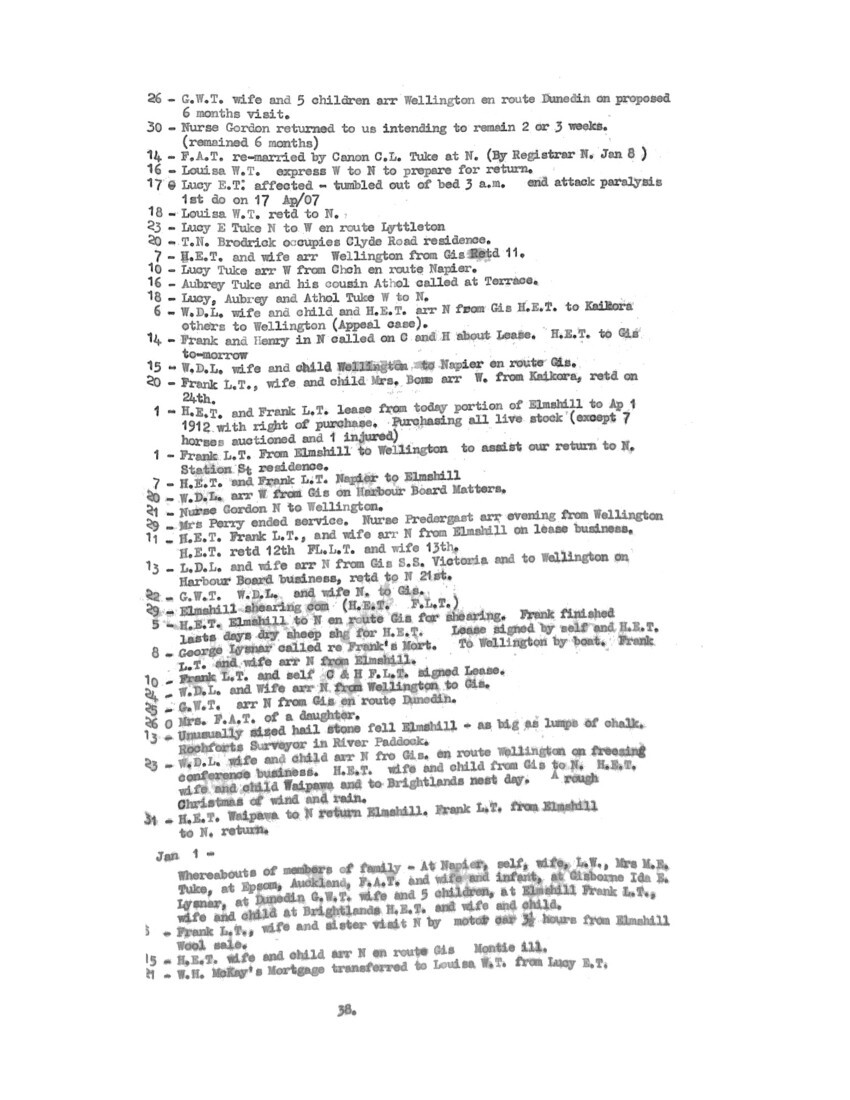
Page 39
See below
24 – W.D. Lysnar, wife and child and H.E.T. arr N from Gis (W.D.L. on frozen Meat Convention).
22 – Telegram from H.E.T. sold Tawhiti
Jan 29 –
Mary E. Tuke returned to N from visit to Taihape with her 3 daughters.
2 – 51st ann Wedding
4 – H.E.T. N to Gis Montie relapse.
7 – F.L.T. E to N. 8th – W.D.L.
17 – Returned G.H. Lysnar arr from Gis. en route Wellington
18 – G.W.T., wife and 5 children arr N en route Gis from their long sojourn South – purpose occupying their newly acquired residence 701 Aberdeen Road
22 – 23 – F.L.T. and wife E to N and N to E.
[Feb?] 2 – H.E.T. to Gis from N to give delivery of Tawhiti and Tikihore properties to Ferguson brs. 14 – Returned.
2 – F.L.T. Elmshill to N on Tikihore business.
16 – Age 82 today
22 – H.E.T. and R. Ward and son adjusting land transaction River Paddock.
[Mar?]1 – F.L,T. visits N.
3 – or 4 Frank L.T. and wife for Rotorua.
15 – Auckland to Rotorua, at Rotorua days.
16 – H.E.T. Brightlands to N to meet wife from Gisborne.
19 – Brightlands connected by telephone with Patangata 1st mess arrd.
26 – H.E.T. Waipawa to N. return.
[Apr?] 9 – W.D.L. to Wellington on Bis Boro Court loan business. 13 – Retd to Gis
1910 May 6 –
H.E.T. and wife to N wife en route Gis.
13 – W.D.L. arr N from W en route Gis.
18 – H.E.T. arr N.
26 – per S.S. Mokai from Gis. Mrs H.E.T. Montie and Neill W.D.L. wife and daughter and Nellie Green en route England on Gis Boro Loan £115,000 business.
25 – H.E.T. arr N to meet family from Gis 28 – H.E.T. N to home.
[Jun?] 1 – F.L.T. and wife arr N.
15 – F.L.T. arr N.
[Jul?] 18 – Lysnars arr London from N.Z. California and New York.
[Aug] 11 – H.E.T. and F.L.T. arr N from their homes
[Sep?] 1 – H.E.T. and F.L.T. visited N.
29 – Aubrey Tuke, Horse and sheepdog N to Brightlands on app as Shepherd, and as Sheepfarmer in the near future.
[Oct] 11 – F.L.T. and wife N. Oct 15 – H.E.T. to N.
[Nov] 22 – One of several futile attempts at rain-fall being about 1/16th of an inch: the largest fall for many months.
27 – An improved fall.
28 – H.E.T., wife, Montie and Neill arr N. from Brightlands, retd by Waipawa on 2nd Dec. H.E.T. returning to N on account L.E.T. illness.
Dec 2 – Lucy E.T. obit, born July 9 1839 aged 70½ at 6:45p.m. Died as result of 3rd paralytic stroke, the 1st being on June 12 1907, the 2nd on Ap 17/09. Frank L.T. and wife arr from Elmshill in evening.
3 – Private interment, present F.J.T., H.E.T., F.L.T., L. Ansell T.,
5 – Canon Tuke (officiating) E. Chapman, Tylee, Frank L.T. and wife to Otane and home.
[Dec] 6 – H.E.T. returned home.
5 – With H.E.T. interviewed Dr. F. Wallace Mackenzie re defective eye.
Removed piece (of) grit from top portion of eye socket. This my 3rd interview, others being Aug 27 and Aug 29.
10 – W.D.L. wife and daughter arr N from Wellington, Sydney and England
(Nellie Green also).
13 – To Gisborne
22 W.D.L. from Gis to N on lecture business at Hastings.
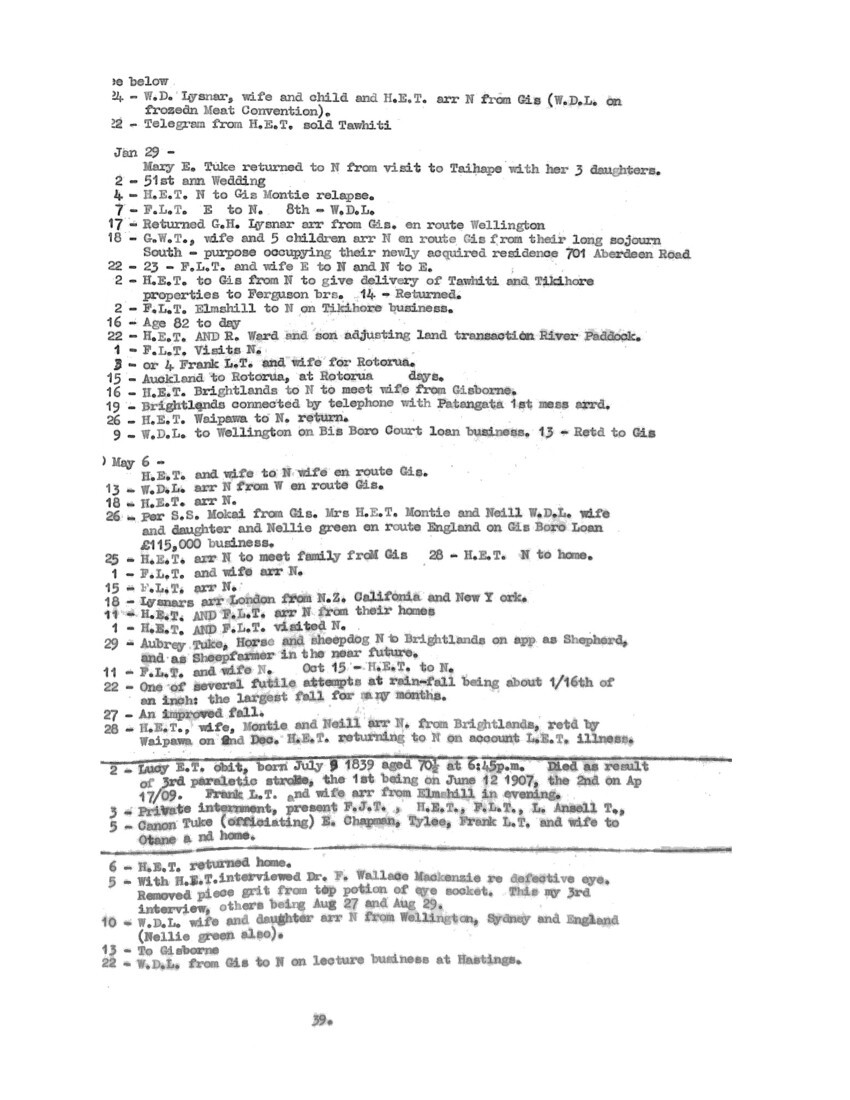
Page 40
1911 Jan 1 –
Family whereabouts. My good wife Napier Cemetery since a month ago. Self, Louisa, Winifred, Mary E. Tuke and 3 daughters in Napier. Ida E. Lysnar husband and daughter in Gisborne. G. Wm. Tiffen, wife, daughter and sons Gisborne Henry, wife and 2 sons Brightlands, Patangata, Frank, wife and 1 son Elmshill, Fredk. A.T. and wife, Epsom, Auckland
10 – W.D.L., wife and daughter and Nellie Green arr N. from Wellington, Sydney and England.
21 – W.D.L. and wife arr N breaking from Gis Hastings.
22 – Retd to Gis.
25 – G.H. Lysnar in Napier.
26 – Walter Grace (Frank Harry & Co) called on Monumental business.
30 – Frank L.T. arr N from E. Bernie wife of F.A.T. of a son 7½lbs weight Collier Mantynce baptised.
[Mar?] 1 -H.E.T. receiving instruction on motor car driving on his new car.
7 – Self, Mary, Winnie, Lucy and Mavis and Kitty Tiffen by rail, self to Otane and Brightlands, remaining 5 Wellington
16 – Self 83 today, returning to N on 22nd after spending fortnight at Henry’s. Us 5 to Napier by motor in 3½ hours.
[May?] 1 – W.D.L. wife and G.H.L. and Dr. Scott Passed through N en route Wellington on eye business Eye removed on
1 – contin –
Duck shooting on lake Brightlands, Boyd and Smith 41 and 42, Frank and Aubrey 9 (Frank’s gun gave in) Henry 1, total 93. 1919 [1910] close season 1909 1908 1907 1906 125, 1905 100, 1904, 122
3 – Operation W.D.L.’s eye by Dr. Harty and Dr. Webster. W.D.L. and wife returning on 20 to N and Gis.
19 – Napier in flood. Tuki tuki river as high as when bridge washed away at Patangata in year. Bridge being 3ft higher now than then saved it 11 inches rain.
20 – W.D.L. and wife arr N from W. Removal of eye apparently successful.
[Jun] 5 – H.E.T. wife and son Neill arr Waipawa from Wellington.
13 – H.E.T. wife and Neil motor to N.
15 – W.D.L. and wife passed N en route Wellington on eye business H.E.T. & co. motor home.
22 – Coronation – God save the King!
26 – H.E.T wife and Neil arrived N en route Gisborne tomorrow. W.D.L. and wife arr from Wellington to Gis tomorrow.
30 – Frank L.T. N to home – in N 3 days.
[Jul?]1 – H.E.T. wife, Nellie and G.W.T. arr N from Gis 2nd to Otane and Brightlands. G.W.T. for change of health.
7 – H.E.T. and G.W.T. on visit to N. Retd 10th.
17 – W.D.L. arr N en route W same boat – midnight
20 – 2 shocks Earthquake (smaller ones 15th and 18th)
21 – W.D.L. arr N from Wellington to Gis by same boat
20 – H.E.T. & G.W.T. arr N p.m. from Wellington, Dunedin & Co.
22 – Retd to Brightlands.
[Aug] 8 – H.E.T. and G.W.T. from Brightlands to Hastings thence by motor next day to N.
9 – Retd by motor to Elmshill, rode to Brightlands.
15 – H.E.T. & G.W.T. motor to N from Elmshill G.W.T. returning to Gis. on 19th and H.E.T. returning home on 18th.
18 – W.D.L. wife and family to Auckland on a month’s holiday.
25 – H.E.T. wife and Neil motor Elmshill to N. H.E.T per S.S. Hauroto to Gisborne on G.W.T. matter.
28 – Kate and Neil rail and coach home.
30 – G.W.T. left Gis for Auckland per S.S.
31 – H.E.T. arr N from Gis thence Elmshill motor – rode home.
[Sep] 17 – H. Burling died aged 110, my acquaintance in 1847 – 8 Certain calculations set age at 104.
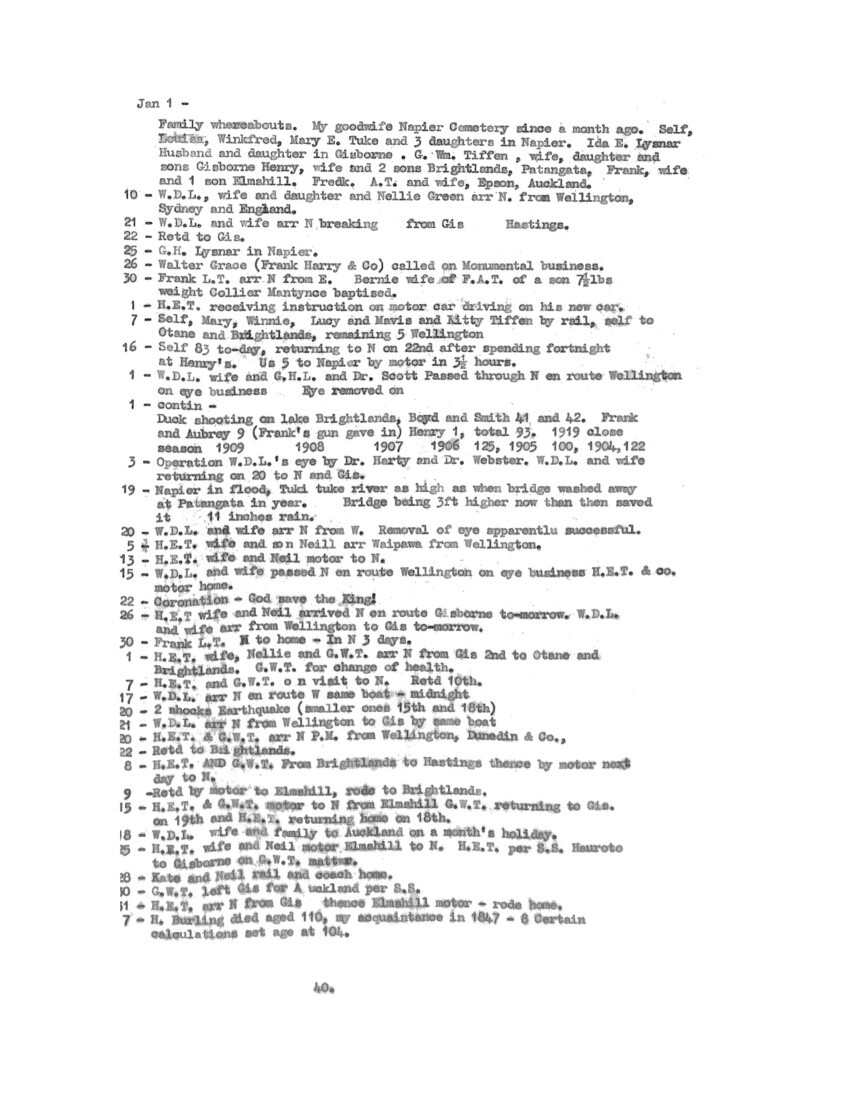
Extract From – “Early New Zealand Families” – By Douglas Creswell [Cresswell].
“TIFFEN OF ELMSHILL”
Midnight! The hoot of a morepork! The new moon on its side shedding the faintest of light over the countryside. I’m at Elmshill, right in the middle of Hawkes Bay, the home of the Tiffen family for almost a hundred years, and four generations. Everyone else in the home is asleep, but I’ve been reading the Tiffen journal. The morepork hoots again, I put out the light and lie in the dark wondering how to present this journal to you.
Should I be dramatic and begin: When Elmshill Station was started in 1859 Frederick Tiffen rode there on a bull, sharing its back with an arm-chair stuffed with horse hair?” Or should I be conventional? In the sober light of morning I decided it would he better that way, so here’s my version of the Tiffen story.
Once upon a time, in the early eighteen-hundreds to be exact, there lived at Hythe in Kent a master printer named William Tiffen and his considerable family of children. He was a man of substance and saw to it that his boys were suitably educated and interested themselves in a profession. His oldest daughter married early and was lost to the family in the Pas de Calais; but his oldest son Henry Stokes, born in 1816, was articled to a surveyor, and aimed to put out his sign in one of the sleepy Kentish villages soon to be revolutionized by the railway.
One day when Henry was idly reading the Times and speculating, as a printer’s son should, on the vast amount of ink needed to produce such a splendid edition, his eye caught an advertisement. “The New Zealand Company. For the settlement of Wellington. Wanted Surveyors.”
It was 1841 and Henry was single and twenty-five. He was, too, in love with Caroline White who lived on the Parade at Hastings, and well aware that to marry her and set up in England as a surveyor was but a precarious living. To persuade her to come to New Zealand on a guaranteed salary now, to have a long sea voyage, to face adventure, to meet new friends – where mightn’t that lead?
Henry squared his shoulders and, without saying a word to the family, saddled his horse at the first opportunity and rode into Hastings to put the case before Caroline.
Caroline was only sixteen and head over heels in love; and when her man painted the New Zealand picture in as glowing terms as you might imagine why, she tossed her ringlets and whispered “Henry! Only Papa stand(s) in the way.”
Papa who was a naval captain, proved easy. He both knew and liked the Tiffens and even agreed to an early marriage and a passage being booked in the Brougham – provided, of course, that Henry could get his surveying appointment.
Henry did; and the marriage took place only ten days before the honeymoon trip began. It was early in 1842 when Brougham entered Port Nicholson, and here Henry started on his three year surveying contract, while his wife led a quiet life waiting for the arrival of her first child, due in the spring of the year.
Alas! the birth was fraught with tragedy. Both mother and child died and Henry was beside himself with grief. No doubt it was his loneliness that made him write to his parents by every mail and urge that one of his younger brothers should come out and join him.
At first no heed was taken. Henry, the family thought, would return himself when his contract was over. But Henry was beginning to like the land of his adoption, and when the family learnt in one of his letters that in addition to being a surveyor he was now in partnership with a Mr Northwood as a sheepfarmer they sat up and took notice and were much more ready to heed the plea of Frederick, a younger son now sixteen, that he should be allowed to go out and join his brother.
Frederick arrived in Wellington in midwinter 1843 and although knowing nothing about stock, agreed with his brother, who met him, to throw in his lot with the partnership of Northwood and Tiffen and accept what employment might be offered.

Cont.
Six weeks after his arrival, and just when he was beginning to get a grasp of matters colonial, a cargo of merino ewes arrived in Wellington from New South Wales, consigned to his employers.
Fred says in his journal – the journal, you’ll remember, that kept me burning the midnight oil, and which the family has given me permission to paraphrase – “A few days after landing, the merinos from Australia were driven through Wellington’s main street (Lambton Quay) and round the coast to my brother’s place in the Wairarapa. The flock numbered between seven and eight hundred, and in charge of them were my brother and Northwood, old Mr Pharazyn and myself, and three or four others. In addition we had a pack mare, two small pigs and later on a dozen head of cattle.
“After seventeen days” journey we reached the partners’ place, Ahiaruhi, but not without some fun I can tell you. You could get round the Muka-muka rocks on the east coast beach at low tide only, and then it was a ticklish business; while on the Wharekaka Plain one mare was badly bogged and in her struggles smothered the two little porkers.
“Naturally, straight from England, I was pretty soft: so after a few days they gave me Billy the pack bull to ride, a bull with a ring through his nose and one rein to turn his head. I’m not going to pretend it was comfortable.
“Well, I stayed at Ahiaruhi for six months and then had my first holiday. I went to Wellington to the races – a four-day walk it was – and enjoyed the fun on Te Aro Flats. When I returned I found that Northwood and my brother had leased from the Maoris another run, situated close to where Masterton is today.
“Here, too, I worked, and after shearing we packed the wool on bullocks to the coast, then shipped it into whaleboats that rowed round to Port Nicholson.
“Soon I was considered experienced; and I was, too, much stronger, for by now I was nineteen. So I had the job of living in a tent and supervising outstation work – boundary riding, I suppose you would call it.
“In October 1848 we suffered the most severe earthquake imaginable. Not a chimney left standing or a house undamaged. Indeed, many people were killed and in Wellington the scene beggared description.
“About a year after this tragedy, that is to say midsummer 1849, Northwood and Tiffen somehow or other procured from the Maoris, for less than one hundred pounds per annum, an interest, in a huge block of property in Hawke’s Bay – central Hawkes Bay – known today as Pourerere and Omakere. On part of the property I was soon managing for my brother; and on the other, Charles Nairn for Northwood but that was later on.
“When the partners decided to stock this place of fifty thousand acres, they did so from their Ahiaruhi run in the Wairarapa, and Northwood came with us. The drove took the eleven of us – six of whom were Maoris – just under a month, and during it the three thousand merinos improved in condition. You see, there were no other flocks about and the sheep could roam wherever they liked. It was a great show.
“Scab? Well yes! There were signs of it, but as early as this it was scarcely noticeable and we didn’t worry much.
“When at last we arrived at Pourerere we separated the sheep into two mobs, and Davis the shepherd and I, built two little huts of totara bark and minded them on the spot. Was it lonely? Certainly it was. To the south the nearest white habitation was well down in the Wairarapa; to the north at Auckland as far as we knew.
“What little stores we required, such as food, arsenic for scab and tobacco came to the coast in infrequent sailers; and thereby hangs a tale.
“Dutch Charlie, Collins, and myself – the first two were shepherds, although Collins afterwards owned a block of country – we three in the station whaleboat went aboard Gypsy the first sailer that called. We tied our boat to Gypsy’s stern and had just begun to check over the stores when the wind changed and Gypsy started to drift up the coast. This wasn’t too good, especially as the wind freshened; but worse was to follow – candidly, the result of our own carelessness. As the sea rose, somehow or other the whaleboat came adrift and
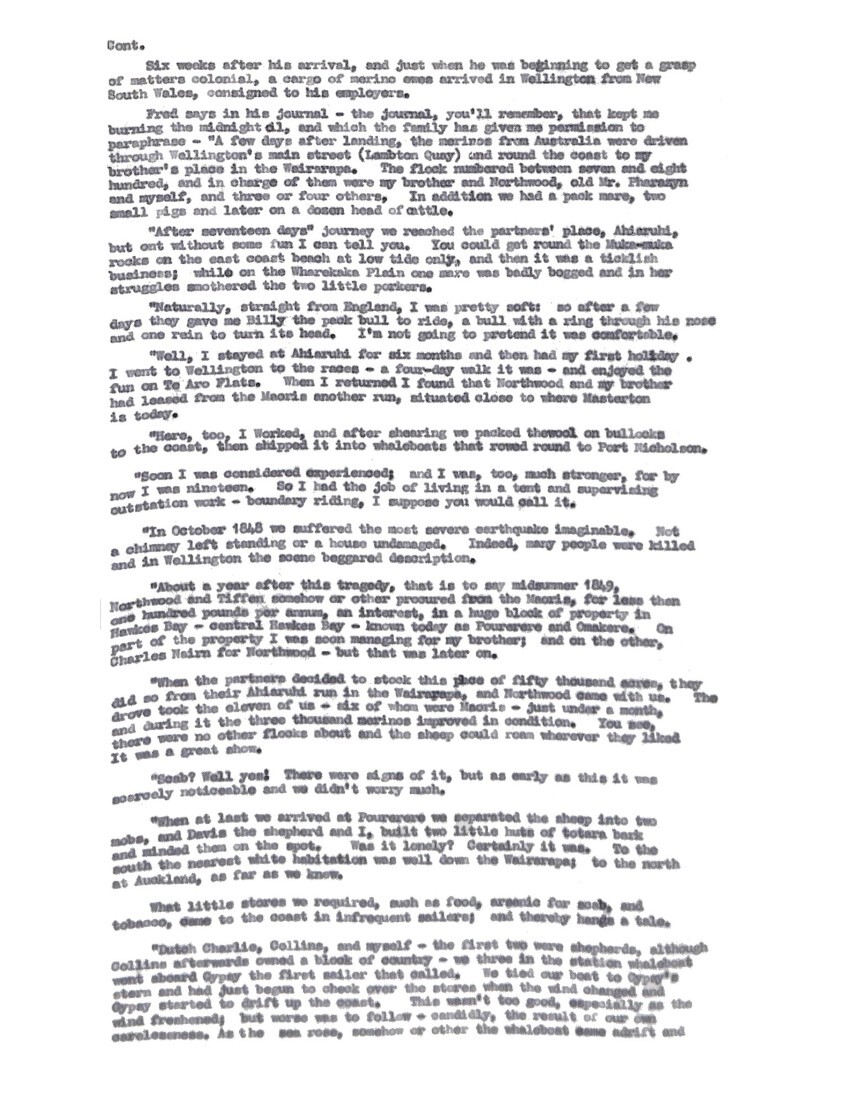
Cont: –
we never saw her again.
“The wind now became a gale and we flew up the coast without a hope of landing. Fortunately a chance came at Port Ahuriri – for there was no thought of Napier in 1849 – and glad we were to take advantage of it and land. Soon we found that the only house was on the western spit – a store and trading station it was – where quantities of pigs from all parts were slaughtered, pickled, or made into bacon by Messrs Alexander and Ankertel.
“With these friendly traders we stayed the night, and the next morning left on foot for Pourerere. We had no intention, we said to ourselves, of missing a courtesy call on the Rev. W. Colenso at his Waitangi Mission, and this was savoured with enjoyment, for Colenso was an excellent host. We soon afterwards forded the Tukituki River and walked the beach to Kidnapper Cliffs. It was then a case of endless hills before we arrived back at Pourerere.
“I paid dearly for the carelessness that led us into this unnecessary activity. I had to carry back with me, on my back, a twenty-pound bag of arsenic. I can tell you it gave me a nice sore neck, chafing the skin and rubbing in the fine poisonous powder.
“Well, before long we were better placed in the way of trading. We opened communications with a nearer branch store opened at Tui-nga-ra by Alexander and Ankertel. Here Jack McAllister managed and, buying from the Maoris a rare lot of pigs, he would set to work and pickle them. He was regular at his work was Jack, and it soon paid a trader to call once a month and take away the meat and bring – much to our relief for we were come down at times to drinking manuka for tea – fresh stores and what you won’t guess – sly goods!
“So much for early communications, and now for something that happened on the station itself.
“In 1850, years before Samuel Williams was at Te Aute, I engaged as a general rouseabout, a William Good, who gave the name of Anderson. Certainly he was a good chap and could whistle to beat the band. Now, a large vessel, the General Palmer, that had been anchored in Wellington, was condemned as unseaworthy and tied up indefinitely out in the harbour with a young man named Jones as caretaker. Here he had been visited previously by this Good I employed, and quarrel evidently ensuing, Good killed him and shoved him head first into a large barrel of pork brine that stood on deck.
“Good cleared out and had no sooner turned his charms on us at Pourerere, than the police got on to his tracks, visited us, and arrested him. How the police took him to Wellington I’ve forgotten, but not so the three-hundred-mile walk I had to make when subpoena’d as a witness. Sergeant Scott accompanied me and three Maoris were in at the start. However, they soon dropped off, calling us manu (birds) and we saw no more of them. Nor do I wonder, for Scott and I were great walkers and, fording all the rivers and pushing through bush, we reached Wellington in ten days, in time for the trial. Good was found guilty and executed.
“Don’t think for a moment that this was the only trouble of that sort that I experienced. Troops had arrived at Auckland to fight Hone Heke and there were plenty of deserters. Where better for them than isolated Pourerere? It got quite a reputation as a hide-out and the entire Hawkes Bay area began to go by the name of “Save-all”. I could tell you plenty of deserter stories.
“In 1852 I left the service of Northwood and Tiffen. I’d then been with them for three and a half years in the Wairarapa and three years on Omakere, during which latter period I’d scarcely seen a white woman or child. What I wanted was a proper change and you’ll never guess my decision.
“I decided to cross to Australia. A gold rush had broken out in Victoria and that meant life and excitement. So I sailed from Wellington in the Brigantine William Alfred with plenty of passengers also afflicted with gold fever.
“What a grand city was Sydney, though how the money flew! Soon I joined up as a trooper in the mounted patrol – gold escort you understand – and presently was hard at work drilling. When I qualified I was sent to
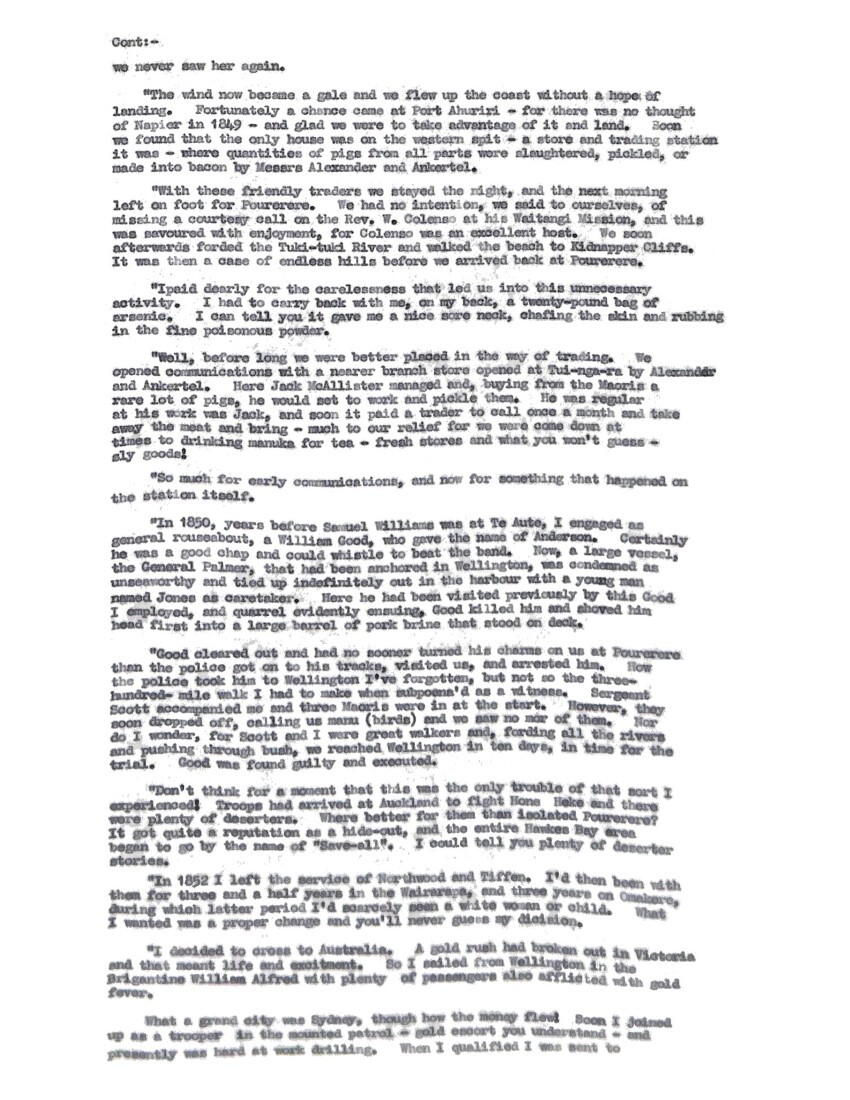
Cont: –
Wentworth Falls and, feeling very important, was fitted out with a carbine, sword, pistols, and horse, and told to report at Bathurst to a Sergeant McGrath, officer-in-charge.
“Most of the gold was carried in iron boxes nine inches by nine inches but some was in heavy linen bags. Not for one moment was it left unguarded however sleepy the escort after a long hot day travelling on the dusty tracks.
There were twelve of us guarding the gold, and I was the only total abstainer. That meant of course, a social cleavage – you men will understand. It meant, too, that I saved money whereas my mates on pay day would blow the lot, and likely enough get into some sort of trouble.
“And if that wasn’t unsettling there were the flies! Every house swarmed with them, and on horseback the shady side of the horse, and our own clothes, carried them by thousands.
“Maybe it was the flies, or if not the flies, the ants that insinuated themselves into the honey, the jam, and the sugar, that made me restless. Having as I’ve said, saved my money, I had little difficulty in obtaining my discharge and, although it was winter and snow lay on parts of the Blue Mountains I set off for Sydney on foot, determined to return to New Zealand by the first ship offering.
“In Sydney I made immediate enquiries concerning a berth to New Zealand, but without much success. Indeed, it wasn’t until I ran across a Mr. Sidey, who was making a pile shipping sheep across to the new-found settlement of Canterbury, that prospects brightened.
“From Sidey I learnt that he had chartered the Duke of Roxburgh, the fine immigrant vessel that had brought to Wellington in 1840 the Hunters, afterwards of Porangahau, and Dr Monteith and his family. Sidey had chartered his ship from Newcastle to Lyttelton and, being short of shepherds, was willing to listen to a proposition I put up to him.
“I’ll tell you what,” he said “If you help with the sheep and the trip’s successful, I won’t charge you any fare. Otherwise – well there was no “Otherwise”. I agreed with his suggestion straightaway, and when the Duke of Roxburgh anchored off Sydney Cove I at once went on board and sailed in her for Newcastle.
“Here it took a fortnight to outfit the ship for stock – alterations, fodder, and so on – and load twelve hundred sheep, fifty horses, and forty cattle. You see, she was a big ship for the job, 417 tons. It was 23 July when we sailed, and we were no sooner at sea than bad weather overtook us, and the barque, a fine sailer under good conditions proved almost unmanageable.
“All the sheep suffered, but as you’ll readily understand, those on deck the most, for they were continually wet. I took my share of cleaning the pens and of going the rounds with fodder and fresh water, but really the hardest task was lifting the dead out and dragging them to the side, up over the bulwarks and into the sea.
“These highly unpleasant tasks went on for days and days, and the weather seldom abated. The only cheery spot was a dump of oranges the skipper had brought on board, for when once or twice I picked these over for him, I of course helped myself.
“So bad was the weather as we approached New Zealand, we couldn’t face Cook’s Strait so as to reach Wellington. Therefore a fair wind was made of it by shaping south-about, so making Port Cooper (Lyttelton) the first port.
“The fine flock of twelve hundred merinos had by this time dwindled to less than half, and the horses and cattle the same, and I can tell you we were glad to get inside the heads. Skipper remarked as he came in “It must be a very good place this. Parsons is the pilot, Godley the founder, and Christchurch the town.” It cheered us up a bit.
The unloading took no time and on the eighth of September we sailed into Port Nicholson (Wellington) thirty-two days after leaving Newcastle.
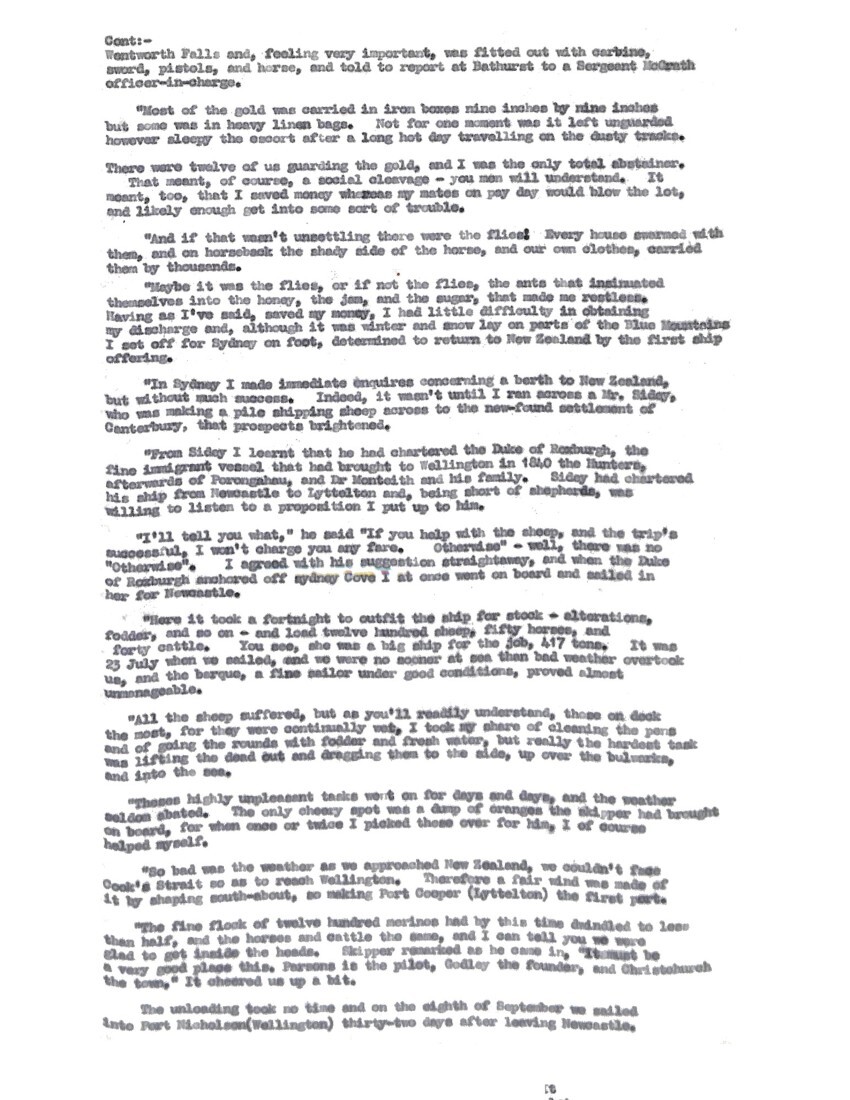
Cont: –
“Again I lost no time, but set out on foot for Hawkes Bay via the Rimutakas and Wairarapa.
“Here I found great changes had taken place. The seven year partnership of Northwood and Tiffen had come to an end. Northwood had taken the Ahiaruhi run in the Wairarapa as well as Pourerere and Omakere in Hawkes Bay, as his share; my brother Henry the Homewood run near Waipukurau.
“Naturally, Homewood was my destination, and here at a spot called Waitukai on the banks of the Tukituki River, I found Henry hard at work building a house and a woolshed. It was obvious why he had chosen this particular spot. All his stores and requisites had to come from Ahuriri (Napier) and by far the easiest way was up the Tukituki river by canoes poled by Maoris.
“When it came to shearing, getting the wool downstream in the same manner wasn’t so easy. Four bales would be loaded into each canoe and the balancing of these was a feat. Not uncommonly, I’d have to walk the fifty miles to Ahuriri, there to unpack the wool and dry it. But we still had to pay the Maoris one pound a fadge to bring it down – I suppose a capsize or two had added to their work, too.
“Well, I must hurry over the next few years, for in the main they were vexatious. Henry went to England, and I spent a lot of time with J.D. Canning at Mount Vernon, later the property of the Harding family. I tackled scab in deadly earnest, I rode inland and visited Lake Taupo, and I walked to and from Wellington many times, often carrying tobacco for dipping.
“In 1856 I was appointed inspector of sheep – a part-time job at a salary of one hundred pounds per annum – and my duties took me into every corner of Hawkes Bay. This was a chance too good to lose, and everywhere I went I looked, though without success, for a property suitable for a man of my small means.
“You see I knew that my brother Henry was about to return from England and when he did I could resign the managership of his Homewood property. I certainly did this when the time came, but imagine my surprise when he landed at Wellington from the barque Westminster, not only with Ansell, my youngest brother aged twenty, my sister Mary, two shepherds, and some rams, but with a second wife! Yes! his deceased wife’s older sister Louisa Anne. He must have married her in France where some of the Tiffens were living – what do you say – for such a marriage would never have been allowed in England. Like her sister’s married life, Louisa’s was tragic. She too lost her life in childbirth and the baby also died – although that was much later on.
“I didn’t stay in Wellington long to welcome the newcomers and was back at Homewood when Ansell arrived with the first of the imported sheep – the rams. They were unique! Rambouillet rams from France! And was brother crestfallen when one of our best-known squatters discovered that one of his so called rams was a wether!
“With Ansell on the spot, I felt I could in fairness leave Homewood, and the year 1857 that followed was a carefree one financially, for I added the job of inspector of brands to that of inspector of sheep.
“However, by degrees the squatters mastered the dread scab and my duties correspondingly lessened. So much so, that early in 1858 when Captain Carlyon purchased Gwavas Station from Charles and Edward Pharazyn, I was prevailed upon to manage the property for the new owner. My boss, the captain was hardy. Cold bath every morning and in winter I’d hear him break the ice.
“On 2nd May my new duties began, for that was the day that the changeover of stock ownership was made. With Gwavas to manage, the irrepressible Carlyons to wonder at, my two government jobs and another station to look after – Milbourne belonging to Stokes Brothers – I was busy, happy, and financially independent.
“You’ll guess what my next visit to Wellington concerned – and indeed many visits past. I’d fallen in love with the sweetest of girls: Lucy, the daughter of Dr. Monteith, and nineteen years old.
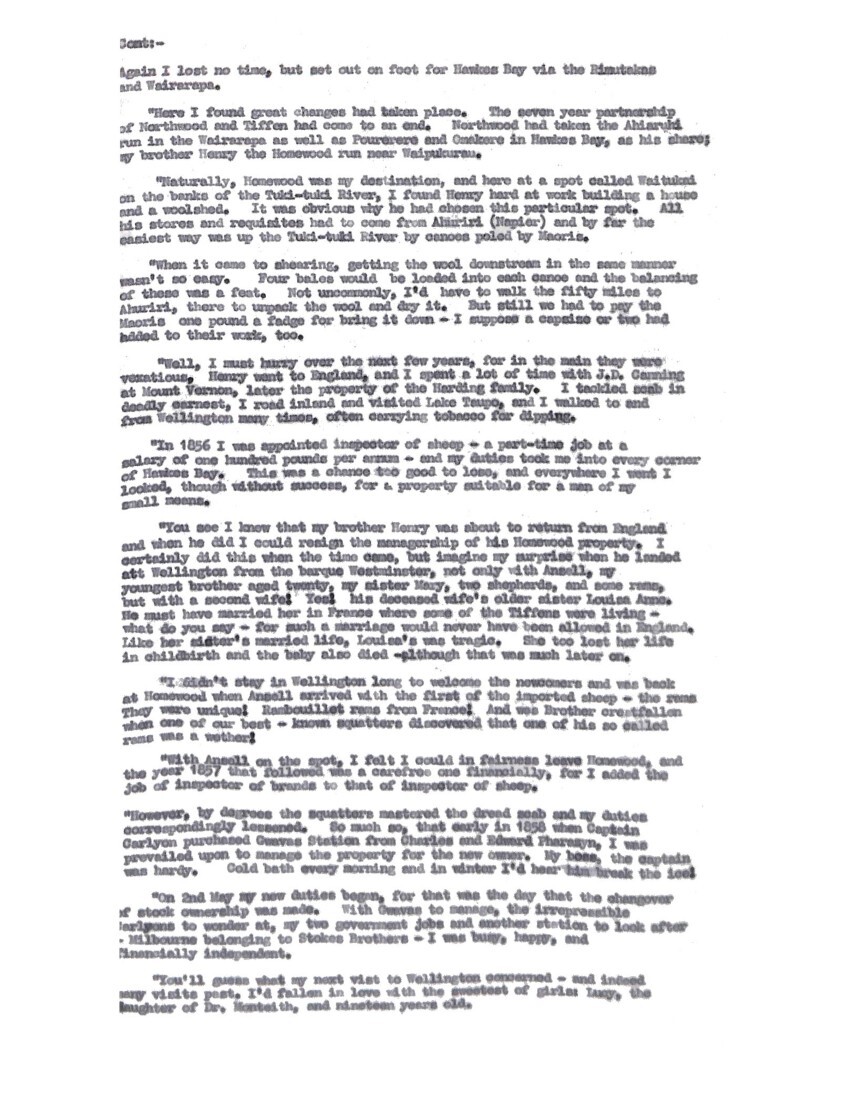
Cont: –
I put my case to her father and was accepted, and on 2nd February 1859 we were married. We allowed three weeks for our honeymoon, and then left Wellington in the steamboat Wonga-wonga for Napier. Of course I had to stay at Homewood and show her off to Henry and his wife, and to Ansell, but by May we were happily settled in at Gwavas.
“The life of a stock inspector was a roving one, and although in my long absences the Carlyons were kindness itself to Lucy I could see that somehow or other we’d have to have our own property and on it our own home.
“One day, when Lucy and I had ridden across to Homewood to see Ansell, we spied some most attractive land as yet unoccupied. Lucy laughingly said, “Fred, that’s just the sort of place we want.” I couldn’t agree quickly enough but, reining in my horse, I banteringly continued “The imagination of women is something to wonder at, Lucy. To buy that block – it’s Government land – would cost thousands – and you know my position!”
“We rode on, but Lucy, I could see, was deep in thought. Finally she called to me to rein in again, and when we were side by side turned to me in all seriousness and said:
“I know your position Freddy; but I’ve a father and after all what are fathers made for? You’ll maybe think me mad, but what about acting on the spur of the moment? What about the both of us making a surprise trip to Wellington? The surveyors are there. The maps are there. That’s where Crown grants are made, and there my love, is where the money lies – well, perhaps!”
“Behold then, in a day or two, Lucy and I on our way back to the capital, where in proper fairy-book style, “the Governor” – Monteith that is – came to light; and four hundred acres of Elmshill, for that was the name we afterwards gave the place, was Crown-granted to us.
“Fine country without a doubt, the block nevertheless, was unfenced and unstocked. On the hills it was covered in fern and the valleys were little better than swamps.
“Early in 1860 I surrendered my farm managerships and took Lucy to Homewood which happened to be close to Elmshill. In the autumn I pitched a tent on our own block and got to work, building a clay house of three rooms. It was a race against time really for Lucy was “Expecting”, but I managed it and to spare, and on 6th April I loaded all our worldly goods, and they were few, onto one of the Homewood pack horses and had the little home spick and span before I gently brought Lucy across.
“A month afterwards our first child was born, George William, the first of seven, and soon we were a very happy trio I can tell you.
“Before long I had increased my holding to about a thousand acres and began to stock the place. Already I had bought six hundred – odd sheep to pasture on terms at Mount Vernon, and when these were driven to Elmshill, the three Tiffens made a state call to look us over and appraise my purchase of stock. I wonder what they said privately on the way back.
“By the time shearing came around, in November 1861, I had increased my holding to thirteen hundred acres, and over the years continued to buy until in the end I had about nine thousand acres. Need I add that every two years my wife presented me with a bonny child, so in a way, you see, I gained on both the swings and roundabouts.
“Of course I had my troubles, and folk who used to think us Tiffens hot headed may have had something.
“On one occasion I got to grips with a neighbour, A. Chapman of Edenham – a partner in Rhodes and Chapman; money, influence, everything! He had my sheep mustered under warrant because of some stragglers of his amongst them. Maybe that was all right, but after my enforced drafting he never called for them, and in the end I charged him grazing and poundage – and for eight of his bullocks into the bargain.
“What a scene when word of this reached him. He came on to the place and got at me with a handle of his whip, while I retaliated with a spade. Blood flowed freely; and there I was, brought to earth and nearly choked, besides receiving a christening of gore.
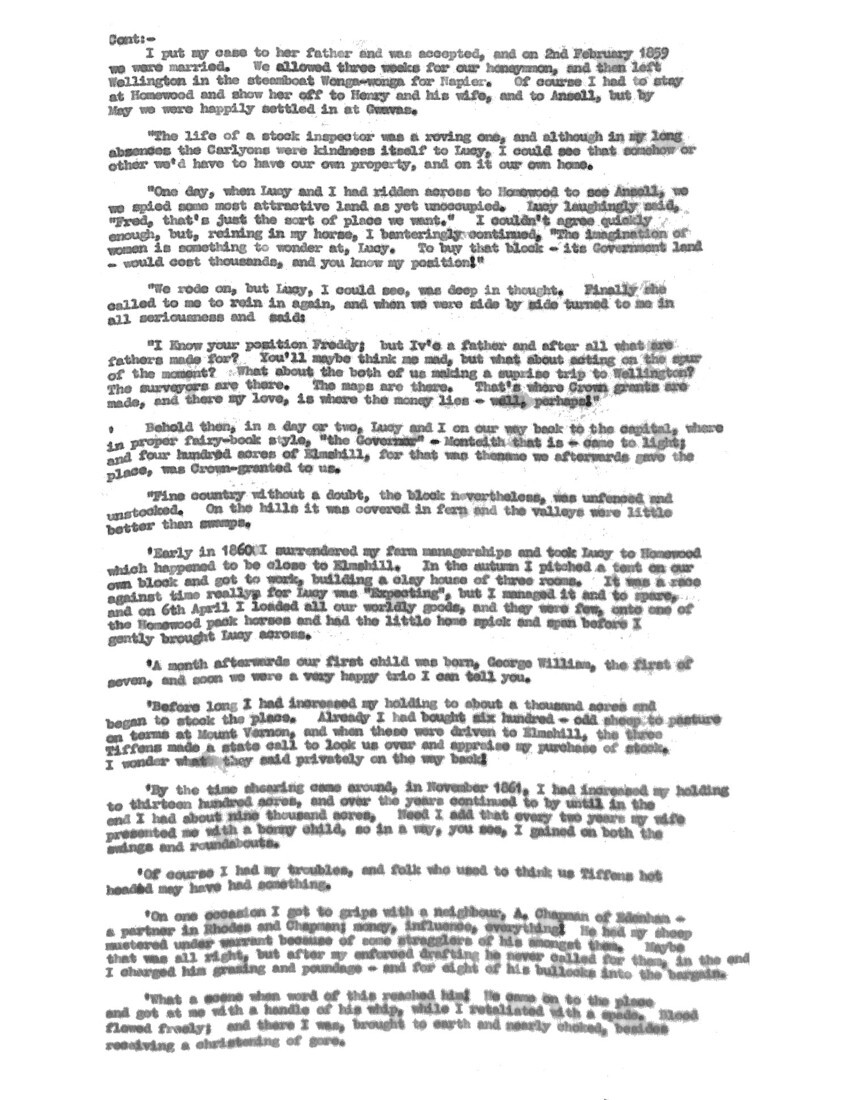
Cont: –
“Then his dogs attacked my sheep and I shot them, and so for a whole year we squabbled and retaliated and aired our grievances in court.
“On another occasion I had to intervene over trouble between the Watts Brothers and J Buchanan. I got no thanks for that! Watts served me with notice of compulsory muster and when the sheep were yarded according to law, why, Buchanan came along at night, let ’em out and shot up one of the musterer’s dogs. Nice, wasn’t it? Especially when other musterers started to roll the wool out of the woolshed, smashed gates and cut peep-holes in the woolshed itself. In the end we had to have the police along.
“We forgot our troubles of 1870, however, when one day big guns started to boom in the distance. For three days they kept it up at intervals of from three to ten seconds, and then there was a nasty earthquake, followed next day by six explosions. It was the eruption of Tarawera and the destruction of the Pink and White Terraces, though in my day-to-day journal I called the show Tongariro instead of Tarawera – we all did then.
“When in 1875 I journeyed to Wellington to attend the funeral of Henry’s wife Louisa, what a city I found it. I hadn’t been there for sixteen years. I mention this, for in my early days as a colonist I walked to and from Wellington over thirty times – and no fallen arches – a matter of ten or twelve thousand miles of hard going.
“My poor Henry, a widower for the second time now, seemed to cave in, if I can put it that way, and spent the rest of his days quietly at Napier. He had no children and few expenses, and when he died his estate ran into six figures. Life for me was different – harder yet happier. I admit my troubles; indeed I’ve told you a few; but not withstanding, Elmshill was gradually brought in and just as gradually prosperity came to my family, who continued to farm the property.
“I was over eighty when Bleriot first crossed the English Channel in an aeroplane, and fat lambs began to reach almost a pound a head. Goodness me, what a price! Why, when I first began work for Northwood and Tiffen, in 1846 they paid me fifteen pounds a year; then twenty pounds a year; then twenty-six then thirty, and lastly the princely sum of thirty-two pounds. Five years on those wages! You couldn’t marry on ‘em. No! But there was a wonder about life, a freedom, a sense of adventure that folk today, it would seem, must go to war to obtain. Give me the good old days of struggle; and were I young again, another Elmshill to break in – and another Hawke’s Bay to open up.”
THE END

TRIALS AND TRIBULATIONS OF AN EARLY PIONEER
FRED TIFFEN
Florence Malkin
Page 1.
When a young lad boarded the good ship “Louisa Campbell” at St. Catherines dock he little thought of all the adventures that would befall him. Neither did he think of the trials and tribulations that would be his lot in a new and untamed land. He didn’t know that some 5 years earlier the ship “Duke of Roxburgh” carried those who were to become closely connected to him by marriage.
The “Louisa Campbell” sailed from England on Oct. 16th 1845, young Fred Tiffen’s 16th birthday. On board with him as shipmates was a youngster named Thompson, a Mr. Murray and a Mr. Reynolds, whom Fred said were both “Tipplers”. There were Hill Charlton – a Lankey man – and a Mr. Bushell, an old Channel Capt. who for some reason or other was making himself scarce.
The other Captain the “Louisa Campbell” carried to try his luck in a new land was Captain Good who rose to fame in the Colonial Army, Taranaki. Oh Yes! there was also on board one enterprising young lady who opened a Milliners shop at Te Aro, Wellington. The ship called at St. Jago and Cape Verde Island on its way to New Zealand and the voyage took four months.
When they arrived at Nelson they found it a very ticklish business getting into the port especially as the “Fifeshire Rock” stood in the way. Mud flats spread around everywhere but the sailors made good use of the mussels that thrived there.
Young Fred wasn’t too keen on seeing the sights of Nelson, being nervous of the Maoris [ ] round their market places, which were built of brick. They were both noisy and [ ].
The ship stayed in Nelson harbour 11 days. They anchored in Wellington on June 24th. Weeks later a cargo of merino sheep arrived from New South Wales for the partners, Tiffen & Northwood. Henry Tiffen, brother of Fred Tiffen came to N.Z. five years before and they leased from the Maoris about 8,000 acres of land at Ahiaruhi – in the Wairarapa at a rental of £12 a year.
You know, looking back into the history over the years, at the changes that have taken place in our every day lives and the prices paid for land, it really seems fantastic.
Well! Young Fred’s first job was driving about 800 sheep for Messrs. Tiffen & Northwood along the main street of Wellington.
It would be a difficult job taking one sheep thro’ Wellington City today wouldn’t it?
At Wainui-o-mata they added to their livestock ½ doz. head of cattle, a mare and 2 pigs.
They journeyed round the coast, beset with obstacles in those days. But which later altered after the ‘quake and upheaval of land in the Wairapapa.
It was only at low tide, and then only if the tide was well out, that a rocky point could be negotiated. Muka Muka point was a dangerous place but even that was made safe by the quake.
The Maoris ferried the sheep across the Lake. They were easily caught and tied [tired] as they hadn’t had time to recover from the long sea voyage but they weren’t to escape misfortune as those carrying the pigs got bogged and were suffocated. Young Fred said the mishap could have been avoided had more attention been paid to them. They still had to get round the rocks. The men were up before daylight piling up stones at one point for the sheep to go over, driving a tunnel thro’ another point known later as “Coles Hole” after the Rev. Cole who visited there at one time. Riders were forced to go into the sea at low tide to go round. Life was full of trials and tribulations for those Early Settlers and young Fred was learning the hard way. The ‘quake made a great difference and its an easy job negotiating round the points even at high tide. The party then passed over Rhodes Hills, which lay between the “Brownacorn House” and Wainui-o-mata, near Orongorongo, where the Northwoods lived.
The only dog to help them was “old Bob” and he wouldn’t have been much use if the sheep had been in high fettle.
It was about 40 miles to Ahiaruhi from the landing station at Te Kopi for household goods and other necessities. At shearing the wool was taken by the same transport they carted goods to the sheep station. Loads that were unevenly balanced were made up with stones. It was long and arduous work. All travelling was done on foot, 5 days being the usual time taken for the journey. Young Fred used a bull as his pack animal altho’ mule, horse, and donkey were used too. The bull had a ring in his nose and riding was rather a painful experience when perched on a pack saddle and only one guiding rein. Well, that just reminded me of a story, told by young Fred of a man who agreed to graze some mules for an Australian. The price agreed on, a third of any progeny born to the mules, suited both parties, especially the Australian! Mules don’t breed so I’ll leave you to guess what the man who grazed them said.
Sometimes the Tiffens and neighbours went for stores making six loads to be carried. They packed about 2 tons of wool at their first shearing, which was repacked at Te Kopi into larger bales ready to ship to Wellington. A pair of harrows was once used as a pack made snug by a few score yards of calico. Such were some of the difficulties of those far off times.
Well! said young Fred, “Just wait until the lambing season” no doubt thinking of all
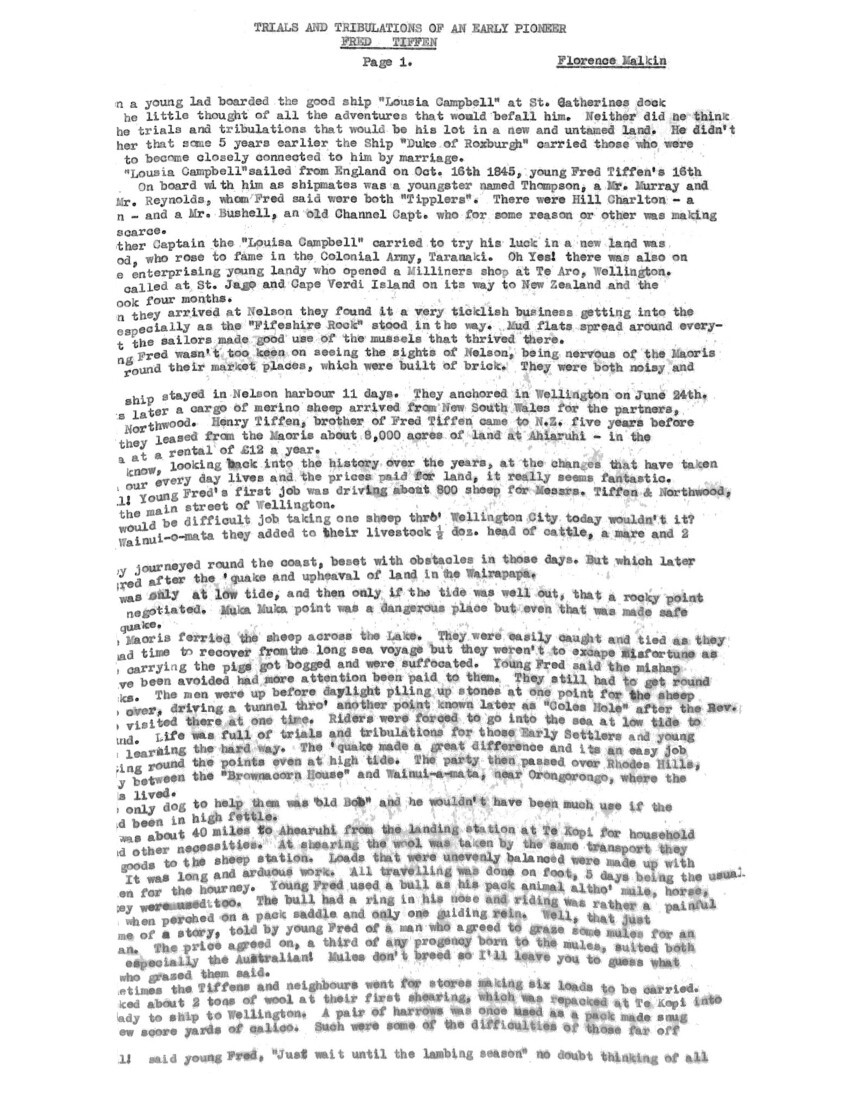
Page 2.
the nursery rhymes he’d heard “Little Bo-peep and “Little Boy Blue“. All he’d would have liked would be to stretch out on the nice green grass, listen to the birds carolling and watch their little lambs gambolling round their mothers. He soon found that lambing was just a long period of hard work and that drowsing in the sunshine was well, just a fairy tale. When he wasn’t chasing the flock trying to keep them within bounds, often at night by lantern light, he was feeding the motherless lambs or changing the lambing ground. Sheep will go in any direction but the right one causing confusion and some lurid remarks. Young Fred used to wonder the percentage was low at docking time.
Shearing wasn‘t as easy as it is today. It was done by hand by Jim Coutts and his co-shearer Charlie Cameron. Each fleece was rolled and tied with a strip of flax. Locks and pieces were left loose. A wool pack, known as a three quarter bale was suspended by its corners to the roof, the fleeces packed in by treading them down to make 100lbs bale for packing to the coast, where they are repacked for shipment to Wellington.
Scab too became a nightmare, especially as there was no known cure and everything was trial and error – mostly error. Burnt lime was tried, carried from the foothills of the [ ]to hills. That proved useless, then arsenic was tried but the only thing this did was to upset the men who got so thoroughly wet they could neither lace their boots nor put on their clothes. I have often heard the remark “Who’d be a Farmer?” But I think it could truly have been said by these who blazed the trail for future generations.
In 1846 young Fred walked all the way to Wellington to see the races which at that time were held on Te Aro flat in Jan. of each year. His next visit to Wellington was to be of a more painful nature.
Fred was at Tainanui outstation – which was occupied by the Shepherd and his Maori wife. He was evidently in a playful mood. While helping the shepherd build a chimney he threw a piece of clay at the Maori woman, she retaliated by throwing her waist band over Fred’s head and pulled him back so that he fell heavily to the ground putting his shoulder out of its socket. She seemed to know what was wrong and tried bathing the swelling with opoldeldock solution. After nearly three weeks of pain Fred walked to Wellington via the Coast, where Dr. Dorset fixed the dislocation by a series of hard pulls and Fred said “He put me into stays”. I’m not sure if these were the type of harness women wore in those days to control their figure! By the time the third shearing came around, Mr. Charles Nairn had built a dray for the wool. It was a very primitive affair, the wheels were made from a large kahikatea, or pine tree, anyway it did the job much better than by pack mule or bullock. The bullocks loaded up, they strongly objected to being turned into pack animals, with a bale of wool each side and perhaps one on top.
Young Fred’s bull “Old Billy” was a docile creature, but civilisation caught up on him when chairs were found to be more comfortable than stools or blocks to sit on. A case [ ] were sent for and on arrival were packed with a corresponding weight on to the [ ] well! that was the end of poor “Old Billy”, he strained his heart and died.
Rats were a terrible menace, and problem, especially when the men were camping. They’d scamper about the dry leaves making a great noise, then they would run up the men’s legs or over the meat slung in the stream overnight, they had a merry time, altho’ the men did catch several hundred of the vermin in a gin trap – pinning their tails to a pine tree as a lesson to others.
Wild dogs were another great trial to the early settler, they took a great toll of the [ ] and generally made the men’s lives a misery. In desperation the men would climb a ridge over overlooking Tiratahi flats, make as much noise as possible even to letting off a small cannon, until finally it burst.
All this time the Teratahi plains were covered with small anice plants – the sheep loved it and kept straying away to get it, being an annual it never grew again. Bayonet grass or papai too grew in clusters of 50 – 100 as well as prickly baynots, a thorny plant that was firmly believed by the Maoris to have formed the “Crown of Thorns” at Christ’s crucifixion.
The Maoris had a strict code of honour when leasing land to Europeans, so says young Tiffen. They adhered to any bargain made between them and respected the primitive leases made. Rent was usually paid in coin of the realm, which promptly came back as payment for goods bought from the white man by the Maori.
Fred Tiffen seemed to be a young man with the wanderlust fully developed. He was off again this time with Mr. Nairn from Wellington, walking from Ahiaruhi over the Rimutakas. The route they took, breaking their journey at Burlings accommodation house, was across bush hills past Hodders Collins, Mangaroa Buck, Taitai, and Burchenns. The Hutt was at the foot of the bush all the way from the foothills on the Wairarapa side. There is no doubt that if young Fred had lived today he’d have stood a good chance of qualifying as a world champion in the Olympic games.
Such as [an] earthquake occurred in 1848 as made young Fred remark that it “Wasn’t such as people make a song about nowadays, but a real chimney levelling, earth cracking, terror inspiring article.” 1848 was a long way off from 1931 wasn’t it?
People ate their food picnic fashion in Wellington. All chimneys were down and they had to return to the good old camp oven to do their cooking. There was only one baker able to supply bread and he was under contract to supply the Military Troops, with only one oven intact, so he wasn’t much help.
The Medical Hall was in a pickle – medicines, salves and lotions all jumbled together
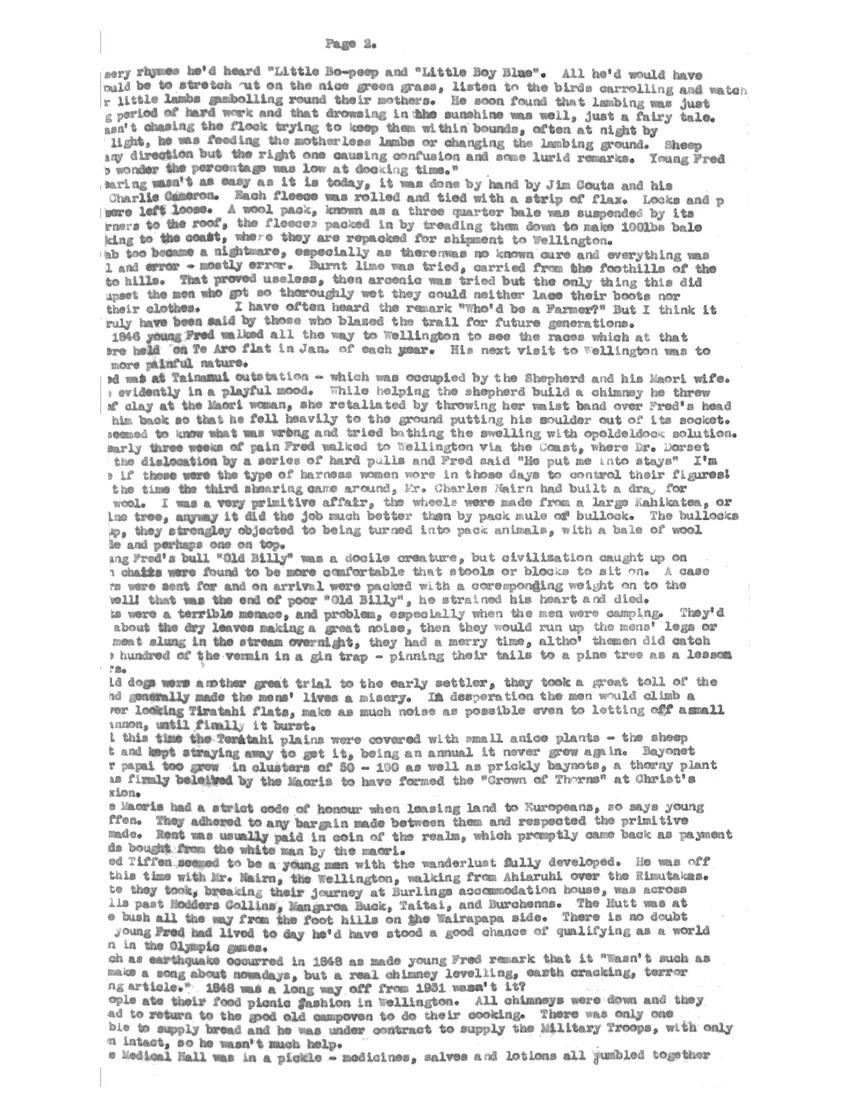
Page 3.
on the floor. As was to be expected the people got panicky and hurriedly boarded a ship to leave for Australia, where the earth didn’t heave and undulate.
And just as hurriedly returned when the ship was wrecked when clearing the Heads – preferring the known perils of earthquakes to the unknown perils of shipwreck.

2. “TRIALS AND TRIBULATIONS OF AN EARLY PIONEER.”
FRED TIFFEN.
The distinction of leasing the first “run“ in Hawkes Bay fell to the lot of Mr. Northwood one time partner of Mr. Henry Tiffen. He had as his partner, Mr. Charles Nairn, who besides being a farmer was a very able linguist. Mr. Northwood had no talent for languages. This was a great asset in those days especially in view of the many Foreigners who were coming into the country. Mr. Northwood leased the “runs”, about 50,000 acres, from the Maoris at a rental of £100 a year. Cheap wasn’t it in comparison with todays [ ].
The runs were situated, one at Pourerere and the other at Omakere. The Pourerere block was only fit to graze merino sheep but the Omakere one was a good “run.” While the Pourerere “run” had hills clothed with ferns from top to bottom, the Omakere one was good land and with moderate hills. The sheep thrived there but scab was a persistent evil. Fred Tiffen and Mr. Northwood, with the help of Charlie Cameron, alias “Dutch Charlie” and a pack horse set out from Ahiaruhi to the East Coast, six Maoris and another white man accompanying them. They took twenty eight days to drive 3,000 sheep down the river Pahau with many crossings to Cameron’s “run” on the Coast, then on to Castlepoint reaching there just a month later. Then 2,000 of the sheep were driven to Omakere by Fred Tiffen and Charlie Cameron. Mr. Edward Collins was appointed station manager at the Pourerere site and Maoris built him a house which served as a Homestead.
Wild dogs soon made their presence felt. Many sheep were lost at Omakere, there were no less than twenty one visits from these creatures in ten months. The men were so annoyed by the brutes they set to work and built themselves two huts, one to [of] toi and one totara bark. They were able to watch the sheep from these huts while the feed lasted then had to build another one. They used the others to grind wheat and as a yard for sheep – they were the only yards on the “run”. Often they never saw a living soul for weeks, although they had an occasional visit from the Maoris when at the depot. Once when out of tea, which often happened, they improvised, making a brew from Pori-Pori [Manuka].
Once Fred Tiffen and Charlie Cameron left with Edward Collins, the Pourerere Station manager, to bring stores in. They boarded the “Gypsy” expecting to find a station hand on board attending to things. A gale blew up – the ship dragged her anchor and they [were] forced to make sail. Having a smaller boat in tow, they intended to put in at a sheltered spot further along the coast but before that haven was reached the small boat broke adrift and they were compelled to make for Port Ahuriri. Wasn’t life one of great adventures in those days?
The store and trading station was kept there by Messrs. Ankertill [Ankertell] and Alexander where animals were slaughtered, pickled or pigs were made into bacon. The only house at the Port at that time was built on the Western Spit. The party left next morning on foot for Pourerere calling at Waitangi upon the Reverend W. Colenso. They then made their way across the Tuki tuki River along the beach to Cape Kidnappers, walked along the track across the hills at the southern end of the Cape of Waimarama, over the hills to Te Apiti, along the coast to Pourerere. Poor Fred’s neck was rubbed raw, he was carrying a 20 pound bag of arsenic and it had not only chafed his neck badly but had rubbed in the arsenic for good measure.
Tui – nga – ra (sew the sails) was a branch of the pig pickling industry kept by Jack McAllister, who according to Fred, “Brought and pickled a rare lot of pigs.” A vessel[called] once a month bringing fresh stores and taking away the cured meat. It was about this time that young Fred Tiffen and Mrs. Guthrie of Castlepoint became involved in a trial. They were served with a subpoena to appear at the Wellington Court, to give evidence. Although three men were actually involved – two were acquitted.
It appears that the ship “General Palmer”, condemned as unseaworthy, was laid up in Wellington Harbour and a caretaker named Jones put on board as watchman. His dead body was found stuffed into a pork cask. The murderer tracked up the East Coast from Wellington with Police Constable Oxenham after him. On arriving, at Pourerere he was told that Good – the murderer – had gone to Omakere. There was of course no telephone in those days to give hint of trouble approaching, so the Constable got Morena and another Maori to help capture the men. The constable used a little strategy in arresting the men, two of whom were deserters from the 65th Regiment. Fred Tiffen, who owing to pressure of work being up at dawn noticed the two Maoris about half a mile away but he wasn’t disturbed about them. However the Maoris continued to come on and Morena handed a placard to Fred Tiffen that had printed on it “Kohuru” (meaning murder) £100 e hutu – £100 reward. There [ ] seai [?] (the other side) and Fred says: “While I was reading it he collared me and then told the other Maori to “Mau Tetahe” (take the other) and Fred says that collared the deserter”. They were marched off to Pourerere, so Fred lost two hands at a busy time.
The man Good had worked at Omakere for a day or two and in his diary Fred says I swapped away a serge shirt for a little coat I thought I looked well in. Good gave his name as Anderson and was a very popular member of the Station hands, being very good company and adept at whistling. So you see it never does to take a person always on face value, as he soon found out. Good was believed to have been a deserter from the Australian Army. Jones and Mc Ausland were taken to Wellington and as I have mentioned were acquitted of the crime. However Fred Tiffen had to appear at the trial, so in the company of Sergeant
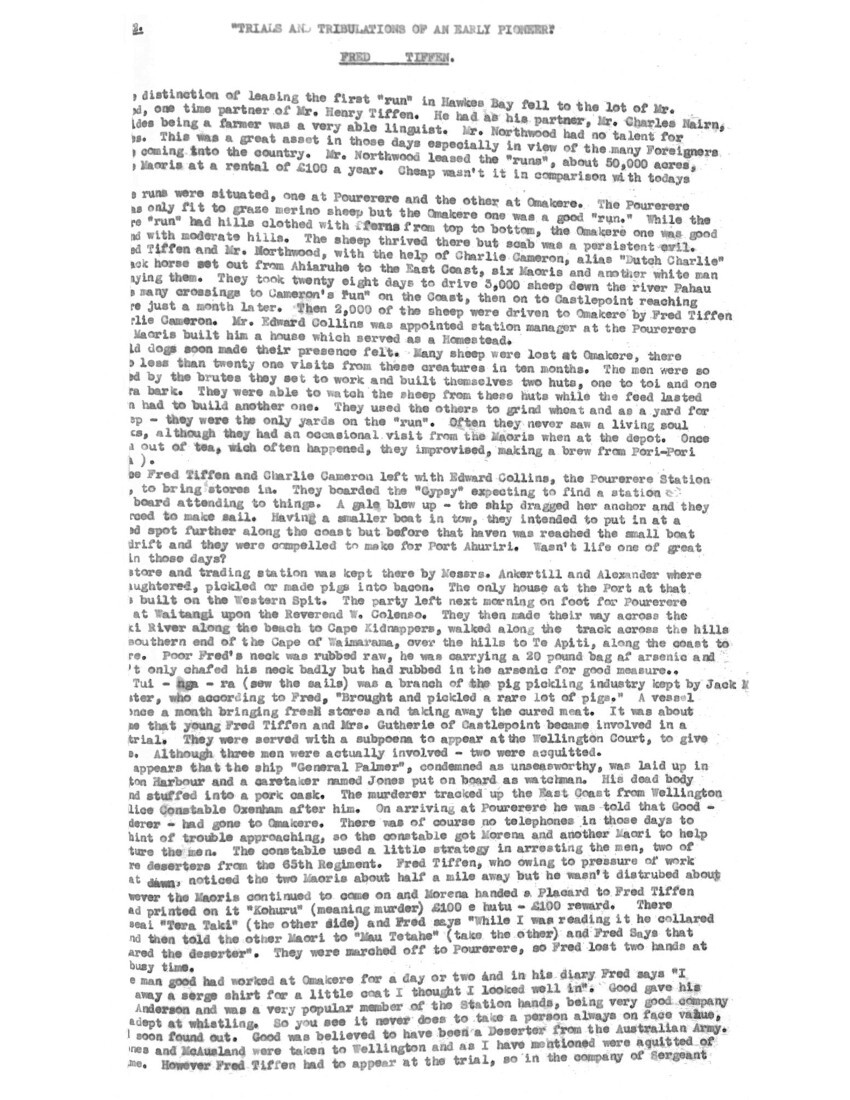
Page 2.
Scott who was a good walker and some Maoris they set out on their journey. The Maoris tired of trying to keep pace with them and left them saying they were “Manu”…..Birds. The third day from Pourerere saw them at Castlepoint, a schooner arriving that evening to take Mrs. Guthrie, Fred and Police to Wellington. Mrs. Guthrie had been served with a subpoena to appear in Court having received a pair of boots from the murderer Good. “I had to continue my walk to Wellington”, says Fred and arrived for the trial on May 24 1850, neither the coat nor the boots threw any light on the murder. Good was found guilty and hanged a few days later. Fred was very peeved because the Government refused to pay mileage from Castlepoint to Wellington, he said “In that I dare say they were right but I didn’t think so at the time.”
You could be inclined to laugh at the idea of Hawke’s Bay being a great place for whales! It was, but Poverty Bay was even more favoured and it was to this place all deserters and criminals seemed to make, thus earning for it the name of “Save-all.” It was from deserters from the 65th Regiment that squatters drew their white labour. Some of these men, named Claridge, Moor and Green were employed on the Pourerere run. Fred, who had been shearing while suffering from a nagging tooth, was resting on his bed half dressed, when he was shaken awake by his Boss – Mr. Collins – a rather rude awakening as there standing beside his bed was Sergeant Sculley, who later became Inspector [ ] for Hawkes Bay, also Morena, whom we have met before, and a Corporal Ben, looking business like carrying a short sword, something like those bandsmen wore in the army. Sergeant Sculley made no bones about what they were after. He said “We are soldiers on the trail of deserters.“ Green and Moor were captured and left in the care of Corporal Ben, Sergeant Sculley went across country to Omakere hoping to intercept any deserters. It proved to be the worst form of strategy because Calridge [Claridge] remained hidden in the woolshed, so Mr. Collins and Fred made up their minds to help the prisoners escape. Morena, whose chance came when the Corporal, wishing, to absent himself for a short time handed his pistol to the Maori, putting him in charge of the two escapers. This was chance to earn more by letting the men go free than by keeping them captives. So the men flew like birds from a cage, with Morena running after them making a great commotion and making a great to do. Corporal Ben of course heard the commotion, guessed what had happened, and rushing round the house made a real figure of fun, clutching his [pants?] while trying to run and tripping up at every step. The prisoners hid themselves in the fern and Fred Tiffen fed them while they waited for Mr. Northwood to return from Ahiaruhi and pay them the few shillings owing to them. They got tired of waiting, or were afraid justice would catch up on them, anyway they accepted a few stopes and tobacco which would do for currency in those days, and made their way to “Save-all“ the deserters Paradise. After all this excitement Fred felt in need of a change of scene so he started off once more to walk to Wellington en route to Australia.
Doctor Featherstone had expressed a wish to see a bridle track cut through the 40 mile bush to Ahuriri, which was the name given to the whole country north of the 40 mile bush and was part of the Wellington Province. £100 was the cost of cutting a track 8 to 10 yards wide and Fred wanted to see what sort of a job cutting such a track would be. He intended going through the bush to the Wairarapa. On January, 10th he set out and his first day’s walk brought him to Waipukurau Pa where he picked up a Maori guide . The next day saw him at Takapau and on the 13th day he entered the bush, rain falling so heavily that he camped under a large tree and the next day was glad to stop at [ ] Pa to dry out. On January fifteenth he found a fresh guide, passed Hututahi [Pututahi?] Pa, slept at Ngawapara Pa arriving next day at Ahiaruhi. He thinks he must have covered seventy miles of bush but considered cutting a track would be a heavy job for £100.
The Natives strongly opposed the project as they firmly believed it would have been as if it was taking possession. names
Only one other European had journeyed through the bush and he only went part of the way after striking off to the right via Manawatu Gorge. Otherwise the route had been untrodden except by Natives.
However Fred Tiffen, by Request, submitted a report to Mr. Ludham of the Provincial Council, giving his opinion of the track. He doesn’t tell us what the outcome of it all was, perhaps he forgot in the excitement of going to Australia, but I’ll tell you about that later.
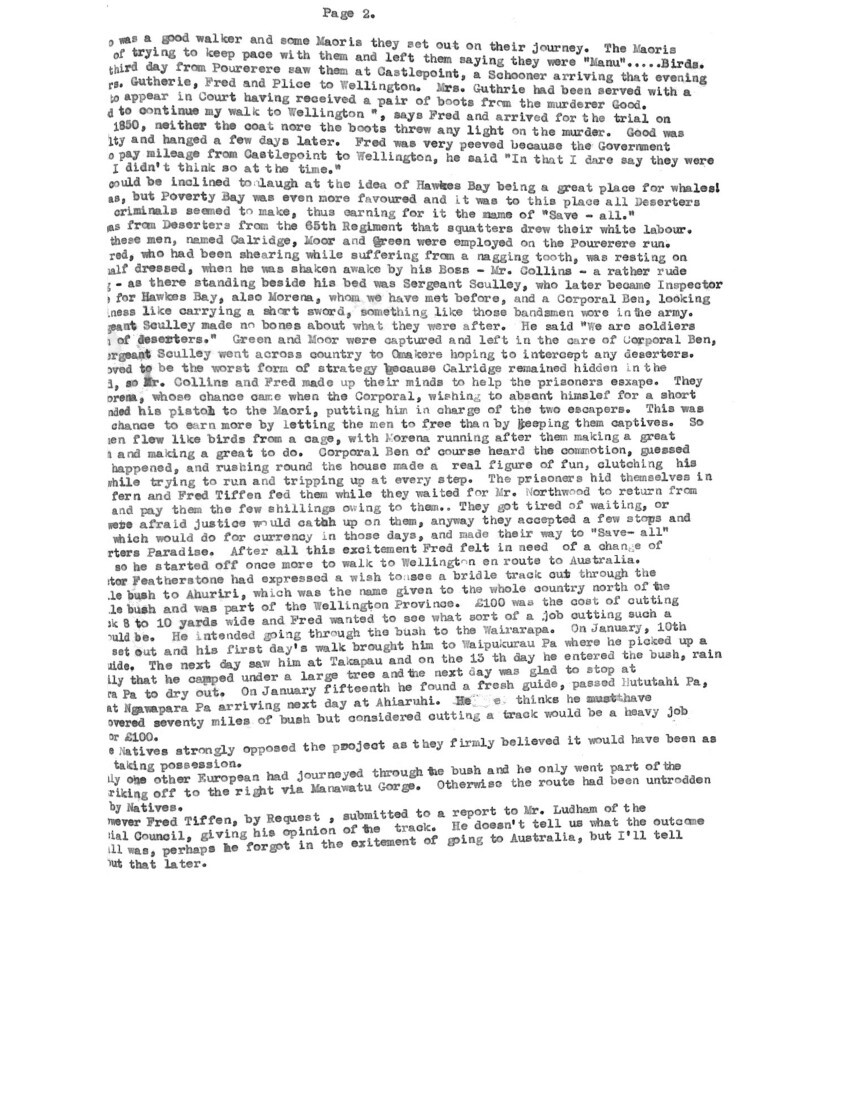
“TRIALS AND TRIBULATIONS OF AN EARLY PIONEER.”
FRED TIFFEN.
– Florence Malkin.
The eagerness of youth and the ever increasing need to see or try something different must have prompted Fred Tiffen to try his luck in a new land and so on Jan 20th we see him footing it to Wellington en route to Australia. He didn’t sail until Feb 11th on the Briganteen “William Alfred“ with Captain Tinnley as skipper and several passengers who were suffering from gold fever and were off to make a quick fortune, or so they said.
They took a fortnight to reach Sydney and Fred was astonished to see what he termed “A great city so far away from home“.
But Fred had to make a living, so instead of catching gold fever he decided to escort the gold instead.
He joined the gold Police, who escorted the gold from the gold fields at Turon to [Sydney?]. After serving as a Trooper for a short time he was sent to Carters Barracks to undergo sword and mounted drill. He was later sworn in by Captain Batty and received his accoutrements, a brace of pistols, carbine, sword and a horse, Fred said he left Weatherboard P.S. well armed and no doubt feeling very important”. He then took up his duties as an escort of the gold.
The first escort fell on Queen Victoria’s birthday. When the mail coach arrived at Turon the escort received the gold from the Commissioner taking it to the gold police barracks for the night, with Fred Tiffen to mount guard. His duty was from 8 p.m. to midnight, which doesn’t sound very long but Fred had had a long day’s ride and was feeling tired, more ready for bed then guarding gold.
There was a roaring fire in the guard room and his companions were sound asleep. Fred tried hard to keep awake. He put his pistols on the table loaded and ready for instant use if necessary. For a seat he had two gold filled boxes measuring 9 x 9 inches which [ ]down filled cushion and kept Fred from nodding off to sleep. Fred says “Besides these two boxes was a small bag of gold about the size of my fist. When in my Jacket pocket it became unpleasantly heavy, so I put that on the table“ but Fred seems to have been very concerned about it, he goes on “Whilst on the table I was afraid it might be collared” for I was very sleepy after a long day’s ride military fnashion and a log fire by which I sat”. He was “mighty glad” to be relieved at midnight as there was gun firing and lots of noise by the Miners who were celebrating the Queen’s birthday very noisily”. It may be of interest for you to know what the Escort uniforms were in those days. The Gold Police were mounted men having similar arms and uniforms. Hip jackets of pilot cloth and trousers of the same, strapped with bazil but the cap of the gold Police had a gold band and Fred said “our head covering was a black cabbage tree“.
A pair of cloth trousers strapped with bazil was worn on state occasions. When not on duty they had to Patrol the highways leading in and out of Bathurst, nothing happened on [ ]uns during Fred‘s stay there.
Pay day always meant trouble of some kind. Fred was an abstainer but as he said “The others had their grog, they were a decent lot of fellows who liked light word [work?] ” but “they always managed to get a black mark and sometimes a discharge.”
Flies there were in swarms, they were everywhere, crowding on to the mens’ clothes and horses by the thousand, ants helped to complete their misery. If they carried anything of a sweet nature there were the ants having a lovely time.
Fred soon tired of Australia and yearned for his adopted country. He made his way to Sydney and left Newcastle on the “Duke of Roxburgh” whose Captain was a Mr. Collard. This was a fine immigrant ship once but was reduced to stock carrying.
Fred Tiffen decided to part work his passage back to New Zealand. It took a fortnight to load the ship with 1,000 sheep, 50 horses and 40 cattle. The vessel left Newcastle on July 23rd 1852. The weather came up rough, Fred wasn’t a good sailor and neither was the livestock, which Fred had to care for. They had to be fed and watered – altho’ they had plenty of that from the seas that swept over them but it was the wrong kind. He had to keep the pens clean and get rid of the dead. Before that voyage was over Fred began to wish he was at the bottom of the sea and that he hadn’t agreed to work his passage home. He found one easy job, the Captain had brought a lot of oranges on board so Fred enjoyed picking them over. The weather got worse and the Captain wouldn’t risk going into Cook Strait to reach Wellington, he put into Port Cooper instead. The stock were depleted in numbers only half the number landed, which was bad for Fred, as he’d agreed that if the trip was successful he’d pay nothing. Well it was a long way from successful, Fred remarks “It was the wrong way for me, I paid a trifle of my trifling balance”. Captain Collard said on entering Port Cooper that it must be a very good place, there was Captain Parsons the Pilot, Godley the Founder and Christchurch a town.
Fred made way to his brother’s run at Ahiaruhi on foot. I don‘t think I have told you the meaning of Ahiaruhi, it is derived from the Maori words Ahi meaning fire and aruhi meaning roots.
After staying for five days at his brother’s run Fred made his way to Castlepoint which he said was ”always a hospitable place“. After resting there 3 days, he made his way via Porangahau, Waipukurau, Pa and Waituki, the first residence of Mr. H.Tiffen on the Homewood [ ].
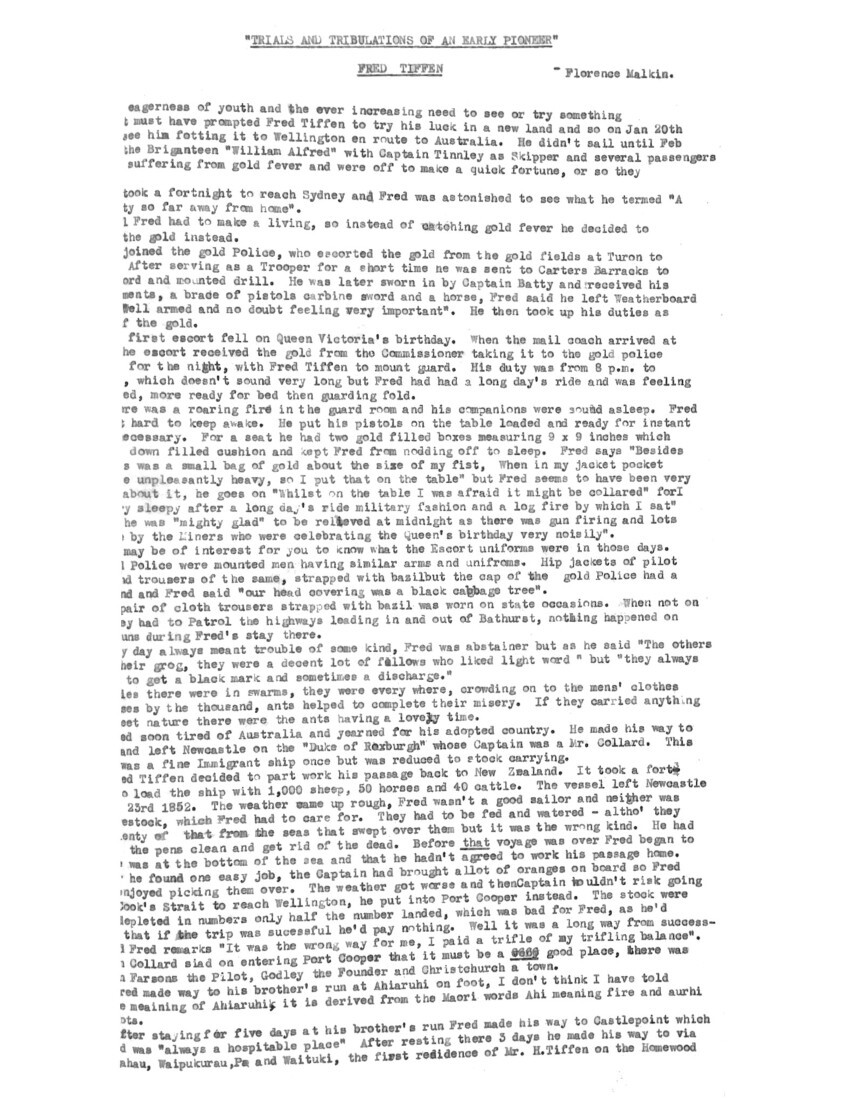
Page 2..
Waituki on the banks of the Tuki-Tuki river was a convenient spot for a residence and woolshed. Stores and other commodities could he landed there by canoe from Napier known at that time as Ahuriri, and the wool taken back by the same way. This required careful balancing if the wool wasn’t to get wet, otherwise it would mean going all the way to Ahuriri to dry it out and repack it, a job calculated to try the patience of any man. Fred Tiffen loved tramping and a change of scenery, so he made many journeys. On one occasion he set out from Waituki for Wellington, met Mr. J.D. Canning at Eparima and turned with him, making their way to Canning and Hardings station between Waipukurau and Waipawa, known now as Mt. Vernon, to help cook. Fred said, “Grinding wheat into flour was my job for 7 or 8 months.”
Then he went on to build a whare for Mr. F.S. Abbott of Waipawa. Living in a tent for four months at the back of the run. His next move was back to Waituki now Witherows as boss for a short time while his brother was on a visit to Wellington. He took to the road as soon as Mr. H. Tiffen returned, this time to get spirits of tar and damaged tobacco for scab dressing.
On his return from another visit to Wellington he helped as top sawyer to cut timber to build a woolshed at Patangata, I suppose that being top sawyer was a better job than being the man in the pit.
Earthquakes seem to have been more frequent then than now as Fred Tiffen records many in his diary, so perhaps the earth is settling down.
Once Fred got lost on one of his many treks to Wellington. He was caught in a storm of dense sleet on the hills overlooking the Warehama river. He camped in a flax bush, which seems to have provided good cover in those days from the weather, when it cleared he was able to take his bearings.
He returned to Homewood and found Purvis Russell trespassing by cutting timber in the Waipawa bush, which was part of Homewood and owned by the Hon. A.G. Tollemache, Henry Tiffen being in England.
It is difficult to imagine that from Waipawa to Waipukurau was once all forest, a small part of it still remains on the north side of the river Tuki – Tuki. at Waipukurau. According to an old map in my possession there was once a bush tramway system operating close [ ]ma, passing thro’ Purvis Russell’s property, to Waipukurau, between J. Hardings property and the Tarewa bush to Waipawa on to Kaikora now Otane, through and out at the [ ] side of Te Aute, which was quite a long track and I suppose carried timber cut from the bush country it passed thro’.
However to get back to my story. Fred went to Napier to see Commissioner Dommett [Domett] about the trespass. Whatever the outcome of this was Fred wasn’t taking it lying down. He “Stopped Purvis Russell’s sawing by levering a log off into the saw pit” and no doubt felt very pleased with himself. Nowadays a trip to Wellington means a few hours in comfort, but in the early days, even if a schooner was available it took 7 days and was considered good going. There was only the most primitive means of transport, no [ ] and not half a mile of roadway.
When wool was taken by canoe to Waipureko the Maoris did the job at a cost of £3/10/- [ ]r bales. Later a punt was used with headquarters at Patangata. Up to now Fred had led a charmed life, considering his adventures but misfortune caught up on him when his horse “Boots” threw him and bolted, breaking his arm. Fred was on his way home from Waipureko when the accident occurred. Now in those days it wasn’t a case of telephoning the Dr. and “Presto!” he was there. The nearest Dr. was quite a distance away and it would take time to reach his patient. So young Fred had to walk back to Waipureko to intercept a companion getting him to fetch Dr. Hitchings from Napier, to render first aid. When this was done Fred was taken by flat bottomed boat belonging to a man named Hollins, who had a small refreshment and “Fred said “sly grog shop“ near Awaroro [Awatoto?] to Munn’s Royal Hotel Napier. It was thirteen days before Fred was fit to return home but even this little accident didn’t cure him of the wanderlust. In 1858 Fred Tiffen was appointed Inspector of sheep and brands at a salary of £100 a year. This gave him plenty of scope for his love of travel.
The next visit Fred paid to Wellington was one of great importance. He’d decided [ ] in “double harness” so on Jan 17th 1859 he married the lady of his choice, who was 19 years of age.
Fred Tiffen and his bride returned to live for a time at Gwavas, where Fred was [ ]red Manager at the time of his marriage. He left there for Homewood on Jan 26th 1860 bringing his goods from there by packhorse to Elmshill where they lived in a whare until their house was built all of hand sawn timber. You’d have thought being married would’ve cured Fred of his love of wandering, not a bit of it, he just took his wife along with him until in 1862 his daughter was born. Before this happy event took place, Fred Tiffen was appointed in 1861, returning Officer of the Waimarama District where he conducted two elections of members of the Provincial Council.“
Fred’s duties took him away from home a great deal and he spent much of his time at Oakbourne. On one occasion he had to conduct an election at Porangahau and such little enthusiasm was shown only one Elector was present. The election was therefore postponed for three weeks when Mr. J.D. Ormond was elected.
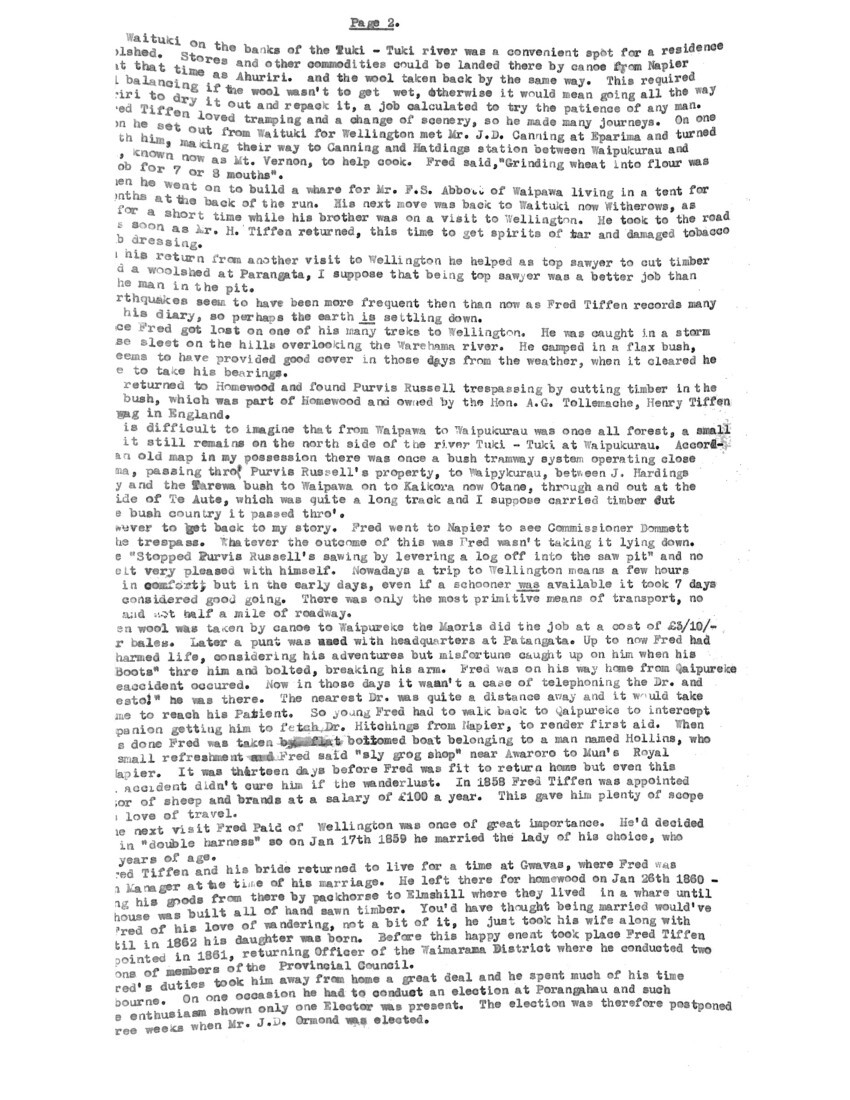
“TRIALS AND TRIBULATIONS OF AN EARLY PIONEER”
FRED TIFFEN
Florence Malkin
Script IV
Some of the Laws passed in the early days of the settlement of New Zealand were very different from those operating today. One law which has since been greatly altered was to cause Fred Tiffin [Tiffen] and a neighbour a good deal of trouble. Fred wasn’t a man to be trifled with and woe betide anyone who tried to trespass on his [rig?]hts, as Mr. Chapman his neighbour found to his cost.
Some sheep belonging to Mr. Chapman had strayed among Fred Tiffen’s flock. Fred impounded them in his own pens as well as some working bullocks, this was quite legal then. He claimed 9/- costs 24/-impoundage and 5/ – for the bullocks. This brought Mr Chapman and a station hand to the rescue of his stock.
He set about Mr. Tiffen with his whip handle. Fred wasn’t taking this meekly, so he returned it all with interest – using a spade. His assailant felled him to the ground nearly throttling him and by the time the contest had ended the place looked like a slaughter house. They both set out to Waipawa, took summons out against each other and were bound over to keep the peace, which couldn’t last long with two such hotheads.
Mr. Chapman owned a slut with her pups and the dog attacked Mr. Tiffen’s sheep. He followed (them) and got a shot at them. He then made his way to Edenham Station and as Mr. Chapman was ill in Napier, he reported his grievance to the Station Manager, getting Peter Hart to return with him to see the damage done. Fred retaliated by impounding 115 sheep belonging to Mr. Chapman. These were redeemed for £2/6/2 . Fred then summoned Mr. Chapman for damages serving a subpoena on Peter Hart at the same time.
Fred said the whole trouble was based on Mr. Chapman mustering “My sheep under magistrate’s order just to suit him“, however the whole miserable business cost him his position as Inspector of sheep and brands. He was offered a sub inspectorship under Mr. G.Peacock which he refused to accept. Fred remarks that agitation was floated by the meddlesome Lord Henry Russell, causing a great deal of private and public correspondence”. The whole trouble seems to have stemmed from the previous assault cases however there couldn’t have been any lasting ill-feeling between the two men as Mr. Tiffen became one of Mr. Chapman’s executors of his will when he died.
Peter Hart who figured in these disputes came to a very tragic end while shearing one day. A branch of a tree fell on him inflicting such injuries that he died 9 hours later. As I’ve mentioned before, it took time for a Dr. to reach his patient and Dr. Todd Coroner of Waipawa arrived in time to sign the necessary papers and poor Peter was duly buried the next day, his grave being left open in case his father arrived the following day.
Some very dry seasons were experienced in Hawke’s Bay in the early days. Tiffen mentions many such in his diary, one in particular. In April 1860 the first rain fell since the previous August, the Waipawa river was quite dry for three or four miles above the gorge!
Once Fred attended a Government land sale and purchased he said “A so called 740 acres at 5/0¼ an acre”, W.B. Rhodes forcing me to buy or he would do so. This block was found to contain 100 acres less than stated, 50 acres at 10/- was offered to me later on as compensation”.
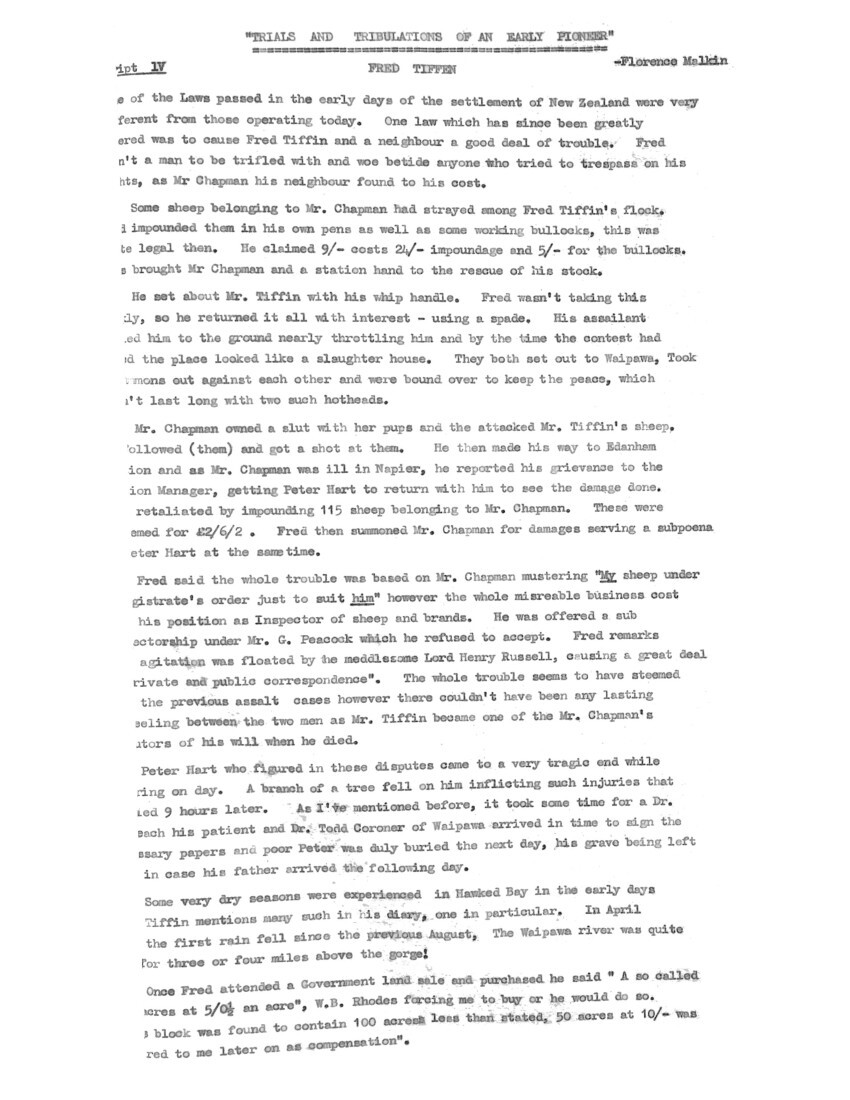
Page. 2.
Fred wasn’t above admitting himself in the wrong either – he proceeded against Morris (Mahia) and R and W. Riddle under the Scab Act. He reports “Believe I was in error here!”
Great was his excitement when he discovered the first Scotch thistle on the Elmshill property – perhaps it was the forerunner of all those we see today.
Don’t imagine that life held nothing but work for those early settlers, who managed to get quite a lot of fun one way and another. They attended many [ ] and travelled long distances to various stations. They had their pig hunting too and it seems to have been a more profitable sport than it is today. Tiffen tells us of the shooting of 134 wild pigs. Duck shooting too was enough to turn our present day sportsmen green with envy, a total of 122 ducks was bagged in one day on Fred’s lake at Elmshill. Good going wasn’t it?
I’m not sure if Fred Tiffen was responsible for introducing the first pheasants to Hawke’s Bay but he tells us that he liberated one cock and two hen pheasants from Napier, so perhaps he was.
Here too we were told that Ditton’s dray was the first wheeled vehicle to pass along the Oero bush road and that the first boiling down of sheep for tallow took place in 1871. The Warranga and Hoani killing plant consisted of a 400 gallon iron tank and 40 wethers were used at a boil. Interesting, isn’t it? And more interesting still was the population of Hawke’s Bay some years previously, 1864 to be exact, was 3770 of which 1337 lived in Napier, so even in the early days that town has enjoyed a popularity second to none in New Zealand. Fred Tiffen would no doubt be a very proud man if he could see the wonderful progress it has made. People were ready and willing to share with others too, one instance of this generosity was when each sheep station contributed a few sheep each to help Te Aute School.
Fred’s experience as a trooper and gold escort in Australia came in useful during the Maori disturbances in the early 19th century. A Militia meeting was held in Mr. E.S. Curting’s wool shed. Altho’ the meeting lapsed for want of attendance drills commenced with Fred Tiffen as Corporal and acting Sergeant. Arms were served out and drilling continued for some time. Once, Fred was called before a court of enquiry for not attending drill parades regularly at Waitaka drill ground. He was sentenced to 48 hours detention at Waipawa court-house. Of course they held shooting matches much as we do today and so were able to keep in touch with the use of firearms.
Fred went to Wairoa once on one of his runs “Hunting Excursions”. He walked to Nairn’s Liston station with a view to purchase, he was tormented by more fleas than he ever knew existed. His only remark was FLEAS!!!! but he doesn’t tell us if he bought the property with its additional livestock.
Fred served on several Juries. Once when a case was brought to court with Tiffen as Defendant, the verdict went in favour of the Plaintiffs, because Fred’s witness was too drunk to attend.
He also served on the special Jury which sat on the case, Kennedy Telegraph papers v Carlyle and others (Hawke’s Bay Herald) so stubborn was Fred he tells that he himself held out against the nine Jurors until lapse of the three hours limit”. Later he sat on a Grand Jury and he described it as a “farce”.
Fred Tiffin lived a great deal in Napier which held a charm for him, through

Page 3.
the latter part of his life. His first home was in Clive Square and altho’ he often went to Elmshill on business he always returned to Napier. All the same Fred [ ] liked change and he let his Clive Square residence to the Working Mens’ club with the option of purchase later. He spent another four years living in Clyde Road. He auctioned that and returned to Elmshill for a time but the call of Napier was strong and he returned to live in Station street when his house was built.
Then Fred tells us of the great eruption of the Tarawera mountains on June 10th 1886 at 2.15 P.M. when New Zealand lost one of her most beautiful scenic attractions, the pink and white terraces. He mentions too the great fire at Napier when 23 houses were destroyed, also the laying of the foundation stone of the Napier breakwater on Jan 27th [25th] 1887. What a wonderful fund of interesting information these old pioneers had! I wonder if they ever thought of the time when their exploits would be of National and historic importance.
Fred paid another visit to Australia but this time he had his wife and two daughters with him. They arrived in Sydney in the middle of a strike, stayed at Katoomba a week and arrived back in Auckland during another strike. What a great traveller Fred was. His brother, Henry Stokes Tiffen, died on Feb 21st 1896. His death was a great loss to Fred, indeed the year seems to have been one of misfortunes, he records great bush fires raging and Puha homestead destroyed. On Good Friday of the following year there was heavy floods and loss of life at the Waitangi washout as well as earthquakes. Life was full of trials and tribulation wasn’t it?
To add to Fred’s troubles his Elmshill Homestead was completely destroyed by fire, fortunately his wife and family were in Napier and only Fred, his son Frank and Mr. W.E. Grieves were in the house, they all managed to escape without injury. The house was rebuilt and ready for occupation in two months which must be a record for building Oh! and here is a tit bit [tidbit] that may be of interest to farmers of today, at the Colonial Wool Sale London in 1901 Wool sold at fourpence a pound!
Fred’s troubles were by no means over, he received the disturbing news of a land slip which occurred at Te Rata when his son’s house was swept away with almost fatal results to Fred Jr. but a Mrs Merrit wasn’t so fortunate, she received such severe injuries that her leg had to be amputated.
Despite all the troubles Fred Tiffen managed to enjoy the thrill now and again as when he had his first ride in a motor car, later he tells us it took three and a half hours to get to Napier from Patangata, so you see we have hurried things up since 1907.
Then came the greatest trouble of Fred’s long life. His wife and Partner was taken seriously ill, she lingered on for nearly three years when she died and now lies in the Napier cemetery – but before her last illness, Fred became seriously ill himself when on a visit to Featherston in bitterly cold weather, he caught such a severe chill that he caused his family a great deal of worry, but Fred was tough and was able to take his first walk to town at the end of six weeks which pleased him immensely. It is very interesting to note how Fred kept in touch with the various members of his family altho’ they were scattered all over New Zealand. He seemed to [ ] his fingers, not only as to the whereabouts of his family but on events of interest. For instance he tells us that Queen Victoria died on Jan 22nd 1901 and that King Edward VII’s Coronation was on August the 9th. of the same year ending his entry “Coronation – God save the King”.
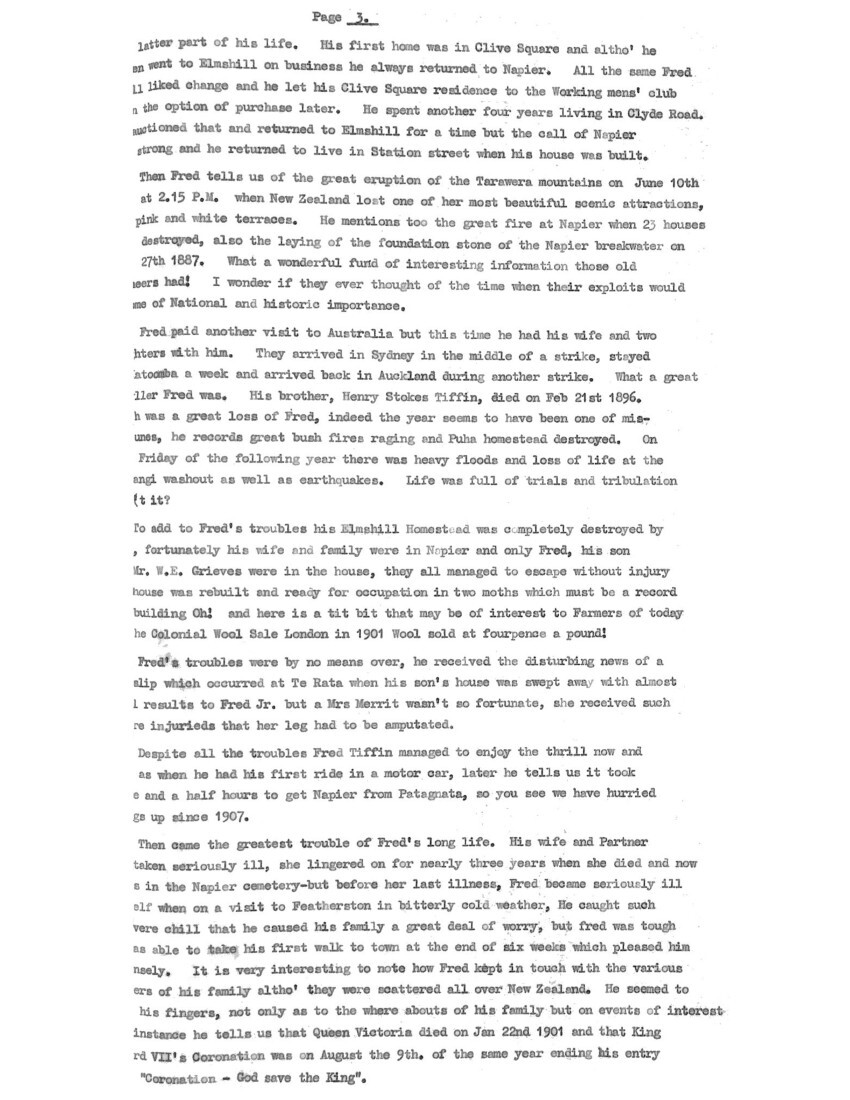
Page 4.
Almost at the end of a life of hard work and travel Fred paid a visit to an old friend who lived at Waikana. Henry Burling was at that time 107 years of age. He was, in his younger days, a mail carrier and well known in the Otaki district.
Altho’ life was hard and in many ways very primitive, people lived to a good old age. Henry Burling is an example, he died at the age of 110 years. Fred Tiffen in his diary questions this but I have since ascertained that that was Henry Burling’s correct age when he died. Anyway it speaks well for a life of hard work plus [priva?]tions as an inducement to longevity. The last record Fred made of his age in his dairy was in 1911 when he celebrated his 83rd birthday. Despite his age he still seemed to enjoy life keeping track of events which are of great interest to many of us who have never known the trials and tribulations which beset the lives of our forefathers.
THE END
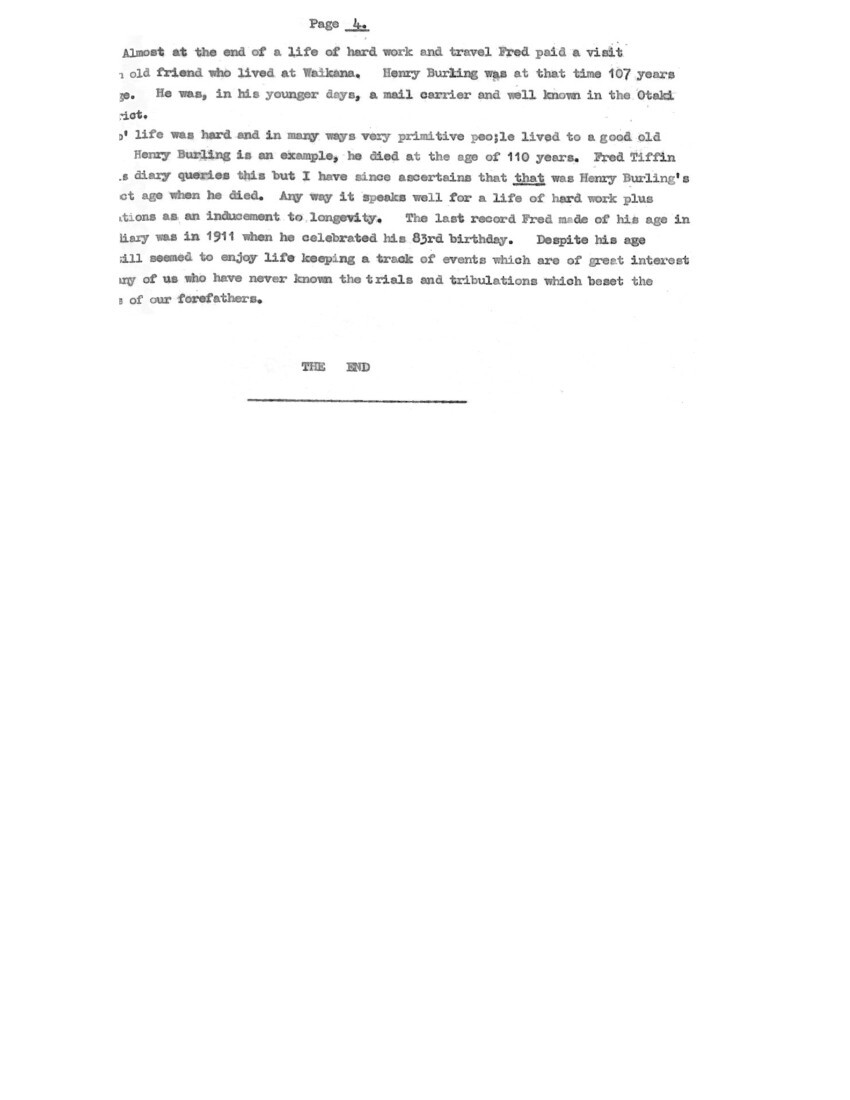
Non-commercial use

This work is licensed under a Attribution-NonCommercial 3.0 New Zealand (CC BY-NC 3.0 NZ).
Commercial Use
The donor of this material does not allow commercial use.Can you help?
The Hawke's Bay Knowledge Bank relies on donations to make this material available. Please consider making a donation towards preserving our local history.
Visit our donations page for more information.
Description
Names in this diary –
Abbott F S, Allen, Allen Leslie, Alexander (Mr), Anderson, Anderson F W (alias of Good), Anderson John Hard, Andrews J C Rev, Ankertell (Mr), Arthur, Barton, Batchelor Dr, Batty Captain, Beil O, Ben (Corporal), Bennet Mr, Bennett E, Berkley W M, Bethune, Bevans Saml., Blair, Booking Mr, Borlesse C B, Bridwell, Britton J, Buck Mark (Capt), Buck George, Bunny H, Burchum, Burling Henry, Bushby Dr, Bushell Capt, Butler, Canning J D, Cameron Charlie, Campbell, Campbell Misses (2), Carlyle, Carlyon Capt, Carlyle Mrs, Chapman Alfred (Alf), Chapman C Mrs (Lizzie), Chapman E, Chapman F M, Charlton, Claridge (deserter), Clarke, Clifford, Cole (Rev) possibly Coles, Coleman, Colenso W (Rev), Collard Capt, Collings J, Collins Edward, Collins R, Collins S, Cooper G, Cooper G S, Cooper W, Cordell, Cotterill W, Coutes Jim, Cracknell, Cross Capt, Crosse, Crouch T, Curting E S, Curting John, Curting R, Dalrymple George, Dalrymple Elizabeth, Dalrymple Jack, Dalrymple Katharine, Dalrymple Lucy Eleanor (married FJT), Dalrymple Maria, Dalrymple Mary Ann, Darby Capt, Darby Sergeant, Davis Edward, Dean A, De Lautour, De Lisle Mrs, Diamond infant, Diamond P, Dillon A, Donald W H, Dorset Dr, Douglas Mrs, Drummond, Dunk C, Dutch Charlie, Dyett, Ellison Mr (Surveyor), Fannin, Featherstone Dr, Fitzgerald, Floyd F, Floyd T, Ford Mrs, Gillies, Godley (Founder of Christchurch), Gollan D, Good, Good Wm, Gordon (may be first name), Gordon A M (Nurse), Govette (Rev), Grace Walter, Grant A, Grant Alex, Green (deserter), Green Nellie, Grieves W E, Grindall J, Guthrie Anne, Guthrie Mrs, Hales, Harding W Bennick, Hargreaves Mr & Mrs, Hart Peter, Harty Dr, Haselden C J A, Haselden Mabel, Headley & Co, Hearn Dennis, Hebberley (Constable), Henderson David, Henderson Mrs, Henley Dr, Henry Lord (possibly H R Russell), Herrick J L, Hill, Hitchens V, Hitchings B, Hitchings Dr, Hitchings V (possibly same as Hitchens V), Hoadley C B, Hoani, Hodd, Hodder, Humphries, Hunter Barbara, Hunter Bel (Isabell?), Hunter David, Hunter D S, Hunter Fanny, Hunter George (Sr), Hunter George (Jr), Hunter Helen, Hunter Margaret, Hunter Jessie, Hunter Robert, Hunter Tiney (f), Hunter William, Irvine James, Irvine W, Jones (Ship’s caretaker), Joyce, Ihaka (Maori?), Kebberley (musterer), Kelly, Kendall, Kendall M Dr, Kennedy, King H, Knapp J E, Knowles Mrs A (formerly Elizabeth Northwood ?), Knowles Frank, Lawrence P James, Livingstone, Lock G, Logan, Looke Miss, Lookey Miss (same as above?), Lovell Sergt, Lowry, Lucena W L, Ludham Alfred, Luff A, Luke Miss, Lyndon E, Lysnar George, Lysnar G H, Lysnar Ida E, Lysnar W D, MacKay J, Mackenzie F Wallace Dr, March, Mason, Mayne Captain, McAllister Jack, McAusland, McGarth (possibly McGrath) Sergeant, McInlay Miss, McKay Barbara, McKay W H, McKenzie, McKinnon, McMasters McNaughton, McNeill J, Merrit Mrs, Mitton J, Monteith G D (Dr), Monteith J, Monteith Lucy E (married FJT), Monteith M A (f), Montmotten ?, Moor (deserter), Moor Mrs George (nee Canning), Morena (Maori), Morris W, Morrison, Munn, Munroe, Munto, Murray J, Murray Mrs, Nairn Chas (Charles), Nairn Frank, Nairn H, Nairn Mrs, Neill George (G J ?), Neils M, Nell Mairia, Nelson Wm, Newman Captain, Northwood Elizabeth, Northwood James Henry (JH), Ormond, Oxenham (Police Constable), Paddock, Palmer Nurse, Parsons (Pilot), Paul Helen, Paul Margaret, Peacock G (Sheep Inspector), Perry Mrs, Peters Mrs, Pharazyn C J (Sr), Pollen Dr, Porter (deserter), Prendergast Nurse, Price A H, Price R, Purvis, Randall Mary, Reed Dr, Reynolds, Rhodes J, Rhodes W B, Rich, Riddle R & W, Rochfort G, Roper (musterer), Roy J, Russell, Russell Arthur Edward, Russell H R, Russell W, Seale, Scott Dr, Scott Police Sgt, Scroggs, Sculley (Sergeant), Sealey H B (Commissioner of Crown Lands), Sidey Mr, Simpson, Sims, Sinclair A, Smith Wm (Capt), Small R, Spencer Rev, St Hill Ashton, Steffensen Andrew, Stokes R, Stokesler, Stopford, Stubbs G, Sturm, Sutton, Swainson G, Tanner T, Taylor Miss, Thompson, Tinley Captain, Todd Dr (Coroner), Tollemache A G Hon, Torotoro Paora, Trask (musterer), Tucker, Tuke Athol, Tuke Aubrey, Tuke C G (Rev), Tuke C L (Canon), Tuke Godfrey, Tuke Latimer, Tuke Lucy, Tuke Mary E, Tuke M M, Tukes, Tully, Vaughan Miss, Walker, Wallace, Warburton A, Ward R, Ward(s), Wargan G, Warranga, Warren(s), Warren Augustus, Watts Brothers, Webster Dr, Weld, Welsh Mrs, Westgarth Capt, Westgarth Mary E nee Tiffen, Weston J, Wheeler, White Captain, White J, White W Bertram, Wigington, Williams J N, Wilkinson John, Williams, Williams S Rev, Witherow(s), Withers Mrs, Wolf Mr, Wolsman, York
Tiffens – Bernie – wife of Frederick Ansell Collier Mantynce – son of Frederick Ansell F A – Frederick Ansell T, son of Frederick John F J, “FJT” – Frederick John “FLT” – Frank Louis Tiffen, son of Frederick John “FMT” – possibly Frederick John’s grandson GW, “GWT” – George William, son of Frederick John “HET” – Henry Ernest, son of Frederick John Henry Stokes, “HST” – brother of Frederick John Kitty – Frederick John’s grand-daughter L Ansell – Louis Ansell, younger brother of Frederick John Louisa Anne, “LAT” – wife of Henry Stokes Mary E – Mary Elizabeth, sister of Frederick John Neil (Neill) – son of Henry Ernest
Names in Cresswell segment – Alexander Mr, Anderson (alias of William Good), Ankertell Mr, Buchanan J, Canning J D, Carlyon Captain, Chapman A, Colenso W Rev, Collins, Davis (shepherd), Dutch Charlie (shepherd), Godley, Good William, Harding family, Hunter family, McAllister Jack, McGrath Sergeant, Montieth Dr, Monteith Lucy (Frederick Tiffen’s wife), Parsons, Pharazyn Charles, Pharazyn Edward, Scott Sergeant, Tiffen Ansell, Tiffen Frederick, Tiffen George William, Tiffen Henry Stokes, Tiffen Louisa Anne, Tiffen William, Nairn Charles, Northwood Mr, Sidey Mr, Watts Brothers, White Caroline (Henry Tiffen’s first wife), Williams Samuel
Names in Malkin segment – Abbott F S, Alexander Mr, Ankertell Mr, Batty Captain, Burling Henry, Bushell Mr, Cameron Charlie alias “Dutch Charlie”, Canning J D, Chapman A, Claridge, Colenso W Rev, Coles Rev, Collard Captain, Collins Edward, Coutts Jim, Curting E S, Dorset Dr, Featherstone Dr, Good, Green, Grieves W E Mr, Guthrie Mrs, Hart Peter, Hitchings Dr, Hollins, McAllister Jack, Merritt Mrs, Moor, Murray Mr, Nairn Mr, Northwood Mr, Ormond J D, Peacock G, Reynolds Mr, Rhodes W B, Russell Lord Henry, Russell Purvis, Thompson, Tiffen Fred, Tiffen Henry, Tollemache Hon A G

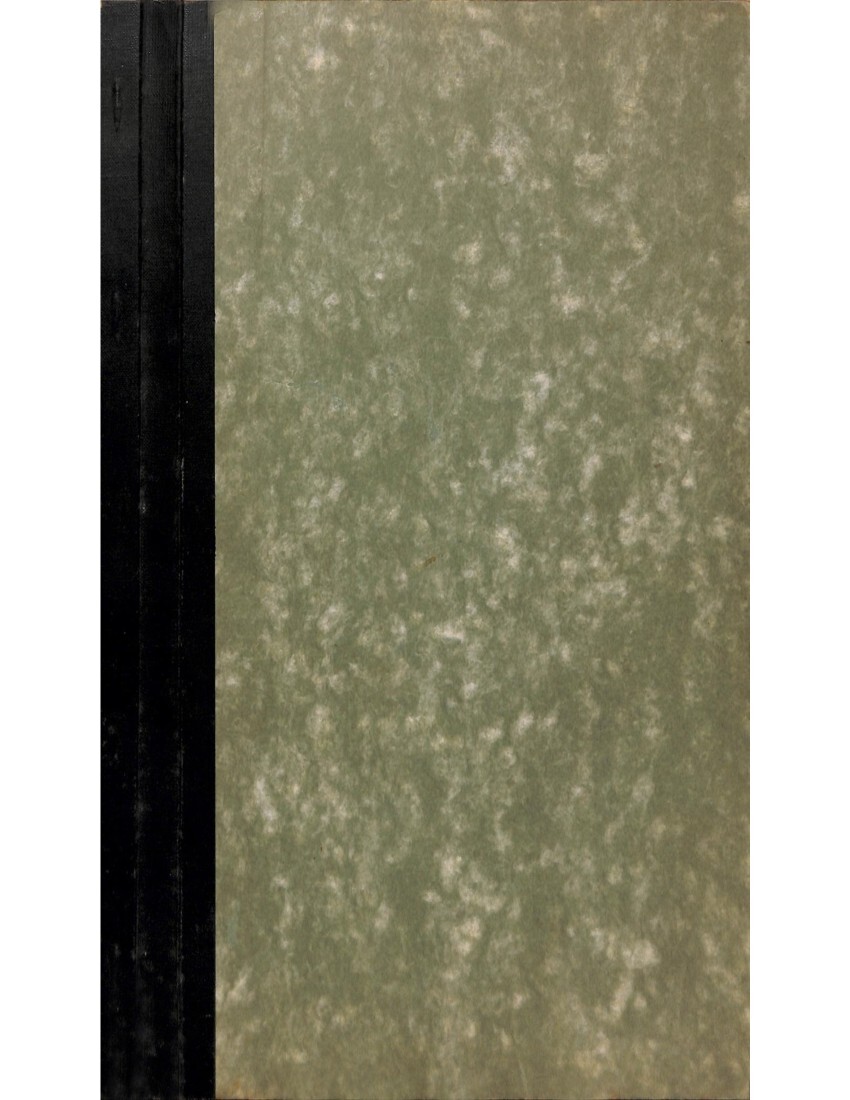









Do you know something about this record?
Please note we cannot verify the accuracy of any information posted by the community.